 Abengoa
Abengoa
Annual Report 2012
- Legal and Economic-Financial Information
- Consolidated financial statements
- Notes to the consolidated financial statements
-
Note 1.- General information
Abengoa, S.A. is the parent company of the Abengoa Group (referred to hereinafter as “Abengoa”, “the Group” or “the Company”), which at the end of 2012, was made up of 618 companies: the parent company itself, 568 subsidiaries, 16 associates and 33 joint ventures. Additionally, as of the end of 2012, certain subsidiaries were participating in 224 temporary joint ventures (UTE) and, furthermore, the Group held a number of interests, of less than 20%, in several other entities.
Abengoa, S.A. was incorporated in Seville, Spain on January 4, 1941 as a Limited Liability Company and was subsequently transformed into a Limited Liability Corporation (“S.A” in Spain) on March 20, 1952. Its registered office is Campus Palmas Altas, C/ Energía Solar nº 1, 41014 Seville.
The Group’s corporate purpose is set out in Article 3 of the Articles of Association. It covers a wide range of activities, although Abengoa is principally an applied engineering and equipment manufacturer, providing integrated project solutions to customers in the following sectors: energy, telecommunications, transport, water utilities, environmental, industrial and service.
Abengoa´s shares are represented by class A and B shares are listed on the Madrid and Barcelona Stock Exchange and on the Spanish Stock Exchange Electronic Trading System (Electronic Market). Class A shares have been listed since November 29, 1996 and class B shares since October 25, 2012. The Company presents mandatory financial information on a quarterly and semiannually basis.
Abengoa is an international company that applies innovative technology solutions for sustainability development in the energy and environment sectors, generating energy from the sun, producing biofuels, desalinating sea water and recycling industrial waste. The company supplies engineering projects under the “turnkey” contract modality and operates assets that generate renewable energy, produce biofuel, manage water resources, desalinate sea water, treat sewage and recycle industrial wastes.
The Group has identified 3 main business activities (Engineering and Construction, Concession-type Infrastructures and Industrial Production).
Abengoa´s activities are focused on the energy and environmental sectors, and integrate operations throughout the value chain including R+D+i, project development, engineering and construction and operating and maintenance for its own the assets and third parties.
Abengoa’s activity and the internal and external management information are organized under the following three activities:
- Engineering and construction: includes our traditional engineering activities in the energy and water sectors, with more than 70 years of experience in the market and development of thermo-solar technology. Abengoa is specialized in carrying out complex turn-key projects for thermo-solar plants, solar-gas hybrid plants, conventional generation plants, biofuels plants and water infrastructures, as well as large-scale desalination plants and transmission lines, among others.
- Concession-type infrastructures: groups together the company’s proprietary concession assets that generate revenues governed by long term sales agreements, such as take-or-pay contracts, tariff contracts or power purchase agreements. This activity includes the operation of electric (solar, cogeneration or wind) energy generation plants and transmission lines. These assets generate low demand risk and we focus on operating them as efficiently as possible.
- Industrial production: covers Abengoa’s businesses with a high technological component, such as biofuels and industrial waste recycling. The company holds an important leadership position in these activities in the geographical markets in which it operates.
These Consolidated Financial Statements were approved by the Board of Directors on February 21, 2013.
All public documents on Abengoa may be viewed at www.abengoa.com.
-
Note 2.- Significant accounting policies
The significant accounting policies adopted in the preparation of the accompanying Consolidated Financial Statements are set forth below:
2.1. Basis of presentation
The Consolidated Financial Statements as of December 31, 2012 have been prepared in accordance with International Financial Reporting Standards, as adopted for use within the European Union (herein, IFRS-EU).
Unless stated otherwise, the accounting policies as set out below have been applied consistently throughout all periods shown within these Consolidated Financial Statements.
The Consolidated Financial Statements have been prepared under the historical cost convention, modified by the revaluation of certain available-for-sale non-current financial assets under IFRS 1 and with the exception of those situations where IFRS-EU requires that financial assets and financial liabilities are valued at fair value.
The preparation of the Consolidated Financial Statements under IFRS-EU requires the use of certain critical accounting estimates. It also requires that Management exercises its judgment in the process of applying Abengoa’s accounting policies. Note 3 provides further information on those areas which involve a higher degree of judgment or areas of complexity for which the assumptions or estimates made are significant to the financial statements.
The amounts included within the documents comprising the Consolidated Financial Statements (Consolidated Statement of Financial Position, Consolidated Income Statement, Consolidated Statement of Comprehensive Income, Consolidated Statement of Changes in Equity, Consolidated Cash Flow Statement and notes herein) are, unless otherwise stated, all expressed in thousands of Euros (€).
Unless otherwise stated, any presented percentage of interest in subsidiaries, joint ventures (including temporary joint ventures) and associates includes both direct and indirect ownership.
Certain prior period amounts have been reclassified to conform to current year presentation.
2.1.1. Recently issued accounting standards
a) Standards, interpretations and amendments effective from January 1, 2012 applied by the Group:
- IFRS 7 (amendment), ´Financial Instruments: Disclosures´. This amendment modified the required disclosures about the risk exposures relating to transfers of financial assets. Among others, this amendment could affect the sale transactions of financial assets, factoring agreements, financial assets and the loan titles agreements.
This amendment did not have a significant impact on the Group’s Consolidated Financial Statements.
b) Standards, interpretations and amendments published by the IASB that are not yet in force and have been adopted by the European Union:
- IFRS 10, ´Consolidated Financial Statements´. IFRS 10 replaces current consolidation requirements of IAS 27 and establishes principles for the presentation and preparation of Consolidated Financial Statements when an entity controls one or more other entities. The standard defines the principle of control, and establishes control as the basis for consolidation. This Standard will be effective for periods beginning on or after January 1, 2014 under IFRS-EU (January 1, 2013 under IFRS approved by the International Accounting Standards Board , herein IFRSIASB).
- IFRS 11 ´Joint Arrangements´. This Standard will be effective for periods beginning on or after January 1, 2014 under IFRS-EU (January 1, 2013 under IFRS-IABS).
IFRS 11, replaces the actual IAS 31 about joint ventures and under this standard investments in joint arrangements are classified either as joint operations or joint ventures, depending on the contractual rights and obligations each investor has rather than just the legal structure of the joint arrangement. Joint operations arise where a joint operator has rights to the assets and obligations relating to the arrangement and hence accounts for its interest in assets, liabilities, revenue and expenses. Joint ventures arise where the joint operator has rights to the net assets of the arrangement and accounts for its interest under the equity method. Proportional consolidation of joint ventures is no longer allowed. - IFRS 12 ´Disclosures of interests in other entities´. This Standard will be effective for periods beginning on or after January 1, 2014 under IFRS-EU (January 1, 2013 under IFRS-IASB). Standard that defines the disclousures related to interests hold in subsidiaries, associates, joint arrangements and non-consolidated entities.
- IAS 27 (amendment) ´Separated financial statements´. IAS 27 amendment is mandatory for periods beginning on or after January 1, 2014 under IFRS-EU (January 1, 2013 under IFRS-IASB). After IFRS 10 has been published, IAS 27 covers only separate financial statements.
- IAS 28 (amendment) ´Associates and joint ventures´. IAS 28 has been amended to include the requirements for joint ventures to be accounted for under the equity method following the issuance of IFRS 11. IAS 28 is mandatory for periods beginning on or after January 1, 2014 under IFRS-EU (January 1, 2013 under IFRS-IASB).
- IFRS 13 ´Fair value measurement´. This Standard will be effective for periods beginning on or after January 1, 2013, both under IFRS-EU and IFRS-IASB.
- IAS 1 (amendment) ´Financial statements presentation´. The main change resulting from this amendment is a requirement to group items presented in ‘other comprehensive income’ (OCI) on the basis of whether they will be subsequently reclassified to profit or loss or not (reclassification adjustments). This Standard will be effective for annual periods beginning on or after July 1, 2012, both under IFRS-EU and IFRS-IASB. Earlier application is permitted.
- IAS 19 (amendment) ´Employee benefits´. IAS 19 amendment is mandatory for periods beginning on or after January 1, 2013.
- IAS 32 (amendment) and IFRS 7 (amendment) ‘Compensation of financial assets for financial liabilities’. IAS 32 amendment is mandatory for periods beginning on or after January 1, 2014 and is to be applied retroactively, both under IFRS-EU and IFRS-IASB. IFRS 7 amendment is mandatory for periods beginning on or after January 1, 2013 and is to be applied retroactively, both under IFRS-EU and IFRS-IASB.
The Group is currently in the process of evaluating the impact on the Consolidated Financial Statements derived from the application of these new standards and they will not have a significant impact on the Group’s Consolidated Financial Statements in opinion of the Directors.
c) Standards, interpretations and amendments that have not been adopted by the European Union:
- IFRS 9, ´Financial Instruments´. This Standard will be effective as from January 1, 2015 under IFRS-IASB.
- IFRS 10, IFRS 11 and IFRS 12 (amendments) ´Transition Guidance´. Effective from January 1, 2013 under IFRSIASB.
- Improvements to IFRS published by the IASB in May 2012 as part of the Annual Improvements 2009-2011 Cycle. The improvements affect IFRS 1 ´ First-time adoption of IFRS´, IAS 1´Presentation of Financial Statements´, IAS 16 ´Property, Plant and Equipment´, IAS 34 ´Interim financial reporting´, and IAS 32 ´Financial Instruments: Presentation’. These amendments are mandatory as from January 1, 2014 under IFRS-IASB.
The Group is currently in the process of evaluating the impact on the Consolidated Financial Statements derived from the application of these new standards and amendments.
2.2. Principles of consolidation
In order to provide information on a consistent basis, the same principles and standards applied to the parent company have been applied to all other consolidated entities.
All subsidiaries, associates and joint ventures included in the consolidated group for the years 2012, and 2011 that form the basis of these Consolidated Financial Statements are set out in Appendices I (XII), II (XIII ) and III (XIV), respectively.
Note 6 of these Consolidated Financial Statements reflects the information on the changes in the composition of the Group.
a) Subsidiaries
Subsidiaries are those entities over which Abengoa has the power to govern financial and operational policies to obtain profits from their operations.
It is assumed that a company has control if, directly or indirectly (through other subsidiaries), it holds more than half of the voting rights of another company, except in exceptional circumstances under which it may be clearly demonstrated that such possession does not entail control.
Control shall also be presumed to exist if a company holds half or less of the voting rights of another entity but holds certain participating rights:
- power over more than half of the voting rights under an agreement with other investors;
- power to manage the financial and operating policies of the company, by virtue of a legal provision, a bylaw or some kind of agreement with the aim of obtaining profits from its operations;
- power to appoint or dismiss the majority of the members of the Board of Directors or equivalent governing body that is actually in control of the company; or
- power to cast the majority of the votes in meetings of the Board of Directors or equivalent governing body that controls the company.
Subsidiaries are accounted for on a fully consolidated basis as of the date upon which control was transferred to the Group, and are excluded from the consolidation as of the date upon which control ceases to exist.
The group uses the acquisition method to account for business combinations. The consideration transferred for the acquisition of a subsidiary is the fair value of the assets transferred, the liabilities incurred and the equity interests issued by the group and includes the fair value of any asset or liability resulting from a contingent consideration arrangement. Any contingent consideration is recognized at fair value at the acquisition date and subsequent changes to its fair value are recognized in accordance with IAS 39 either in profit or loss or as a change to other comprehensive income. Acquisition-related costs are expensed as incurred. Identifiable assets acquired, liabilities and contingent liabilities assumed in a business combination are measured initially at their fair values at the acquisition date. On an acquisition-by-acquisition basis, the group recognizes any non-controlling interest in the acquiree either at fair value or at the non-controlling interest’s proportionate share of the acquireer’s net assets.
The value of non-controlling interest in equity and the consolidated results are shown, respectively, under 'Noncontrolling Interest' of the Consolidated Statement of Financial Position and “Profit attributable to non-controlling interest” in the Consolidated Income Statement.
Profit for the year and each component of Other comprehensive income is attributed to the parent company and non-controlling interest in accordance with their percentage of ownership. Total Comprehensive income is attributed to the parent company and non-controlling interest even if this results in a debit balance of the latter.
In the consolidation process, intercompany transactions and unrealized gains are eliminated and deferred until such gains are realized by the Group, usually through transactions with third parties. Intercompany balances between entities of the Group included in the consolidation are eliminated during the consolidation process.
In compliance with Article 155 of Spanish Corporate Law, the parent company has notified to all these companies that, either by itself or through another subsidiary, it owns more than 10 per 100 of their capital. Appendix VIII lists the Companies external to the Group which have a share equal to or greater than 10% of a subsidiary of the parent company under consolidation.
b) Associates
Associates are entities over which Abengoa has a significant influence but does not have control and, generally, involve an interest representing between 20% and 50% of the voting rights. Investments in associates are carried under the equity method and are initially recognized at cost. The Group’s investment in associates includes goodwill identified upon acquisition (net of any accumulated impairment loss).
The share in losses or gains after the acquisition of associates is recognized in the Consolidated Income Statement in “Share of (loss)/profit of Associates” and the share in movements in reserves subsequent to the acquisition is recognized in the reserves. Movements subsequent to the acquisition are adjusted against the carrying value of the investment. When the share in an associate’s losses is equal to or higher than the interest in the company, including any unsecured accounts receivable, additional losses are not recognized unless Abengoa has acquired obligations to make any payments in the associate’s name.
Gains between the Group and its associates not realized with third parties are eliminated according to the interest held by the Group in the associates. Unrealized losses are also eliminated, unless the transaction provides evidence of impairment to the asset being transferred.
In compliance with Article 155 of Spanish Corporate Law, the parent company has notified to all these companies that, either by itself or through another subsidiary, it owns more than 10 per 100 of their capital.
c) Joint ventures
Joint ventures exist when, by virtue of a contractual arrangement, an entity is jointly managed and owned by Abengoa and third parties outside the Group. These arrangements are based upon an agreement between all the parties that confer to those parties joint control over the financial and operating policies of the entity. Holdings in joint ventures are consolidated using the proportional consolidation method.
The Group consolidates the assets, liabilities, income and expenses, and cash flows of the joint ventures on a line-byline basis with similar lines in the Group’s financial statements.
The Group recognizes its share of gains and losses arising from the sale of Group assets to the joint venture for the portion that relates to other investors. Conversely, the Group does not recognize its share in any gains or losses of the joint venture that result from the purchase of assets from the joint venture by a Group company until those assets have been sold to third parties. Any loss on a transaction between the Group and the joint venture is recognized immediately if there is evidence of impairment.
As of December 31, 2012 and 2011 there are no significant contingent liabilities in the Group’s interests in joint ventures.
d) Temporary joint ventures
“Unión Temporal de Empresas” (UTE) are temporary joint ventures generally formed to execute specific commercial and/or industrial projects in a wide variety of areas and particularly in the fields of engineering and construction and infrastructure projects. They are normally used to combine the characteristics and qualifications of the UTE’s partners into a single proposal in order to obtain the most favorable technical assessment possible. UTE are normally limited as standalone entities with limited action, since, although they may enter into commitments in their own name, such commitments are generally undertaken by their investors, in proportion to each investor’s share in the UTE.
The partners’ shares in the UTE normally depend on their contributions (quantitative or qualitative) to the project, are limited to their own tasks and are intended solely to generate their own specific results. Each partner is responsible for executing its own tasks and does so in its own interests.
The fact that one of the UTE’s partners acts as project manager does not affect its position or share in the UTE. The UTE’s partners are collectively responsible for technical issues, although there are strict pari passu clauses that assign the specific consequences of each investor’s correct or incorrect actions.
UTE are not variable-interest or special-purpose entities. UTE do not usually own assets or liabilities on a standalone basis. Their activity is conducted for a specific period of time that is normally limited to the execution of the project. The UTE may own certain fixed assets used in carrying out its activity, although in this case they are generally acquired and used jointly by all the UTE’s investors, for a period similar to the project’s duration, or prior agreements are signed by the partners on the assignment or disposal of the UTE’s assets upon completion of the project.
UTE in which the Company participates are operated through a management committee comprised of equal representation from each of the temporary joint venture partners, and such committee makes all the decisions about the temporary joint venture’s activities that have a significant effect on its success. All the decisions require consent of each of the parties sharing power, so that all the parties together have the power to direct the activities of the UTE. As a result, in these temporary joint ventures power is shared and UTE are consolidated proportionally.
The proportional part of the UTE’s Consolidated Statement of Financial Position and Consolidated Income Statement is integrated into the Consolidated Statement of Financial Position and the Consolidated Income Statement of the Company in proportion to its interest in the UTE on a line-by-line basis.
As of December 31, 2012 and 2011, there are no significant material liabilities in relation to the Group’s shareholdings in the UTE.
e) Transactions with non-controlling interests
Transactions with non-controlling interests are accounted for as transactions with equity owners of the group. When the Group acquires non-controlling interests, the difference between any consideration paid and the carrying value of the proportionate share of net assets acquired is recorded in equity. Gains or losses on disposals of non-controlling interests are also recorded in equity.
When the group ceases to have control or significant influence, any retained interest in the entity is remeasured to its fair value, and any difference between fair value and its carrying amount is recognized in profit or loss. In addition, any amount previously recognized in other comprehensive income in respect of that entity is accounted for as if the group had directly disposed of the related assets or liabilities.
Companies and entities which are third parties for the Group and which hold a share iqual to or larger than 10% in the share capital of any company included in the consolidation group are disclosed in Appendix VIII.
2.3. Intangible assets
a) Goodwill
Goodwill is recognized as the excess between (A) and (B), where (A) is the sum of the considerations transferred, the amount of any non-controlling interest in the acquiree and in the case of a business combination achieved in stages, the fair value on the acquisition date of the previously held interest in the acquire and (B) the net value, at the acquisition date, of the identifiable assets acquired, the liabilities and contingent liabilities assumed, measured at fair value. If the resulting amount is negative, in the case of a bargain purchase, the difference is recognized as an income directly in the Consolidated Income Statement.
Goodwill relating to the acquisition of subsidiaries is included in intangible assets, while goodwill relating to associates is included in investments in associates.
Goodwill is carried at initial value less accumulated impairment losses (see Note 2.8). Goodwill is allocated to Cash Generating Units (CGU) for the purposes of impairment testing, these CGU’s being the units which are expected to benefit from the business combination that generated the goodwill.
b) Computer programs
Costs paid for licenses for computer programs are capitalized, including preparation and installation costs directly associated with the software. Such costs are amortized over their estimated useful life. Maintenance costs are expensed in the period in which they are incurred.
Costs directly related with the production of identifiable computer programs are recognized as intangible assets when they are likely to generate future economic benefit for a period of one or more years and they fulfill the following conditions:
- It is technically possible to complete the production of the intangible asset;
- Management intends to complete the intangible asset;
- The Company is able to use or sell the intangible asset;
- There are technical, financial and other resources available to complete the development of the intangible asset; and
- Disbursements attributed to the intangible asset during its development may be reliably measured.
Costs directly related to the production of computer programs recognized as intangible assets are amortized over their estimated useful lives which do not exceed 10 years.
Costs that do not meet the criteria above are recognized as expenses when incurred.
c) Research and development cost
Research costs are recognized as an expense when they are incurred.
Development costs (relating to the design and testing of new and improved products) are recognized as an intangible asset when all the following criteria are met:
- It is probable that the project will be successful, taking into account its technical and commercial feasibility, so that the project will be available for its use or sale;
- It is probable that the project will generate future economic benefits;
- Management intends to complete the project;
- The Company is able to use or sell the intangible asset;
- There are appropriate technical, financial or other resources available to complete the development of the intangible asset; and
- The costs of the project/product can be measured reliably.
Once the product is in the market, capitalized costs are amortized on a straight-line basis over the period for which the product is expected to generate economic benefits, which is normally 5 years, except for development assets related to the thermo-solar plant using tower technology which are amortized over 25 years.
Development costs that do not meet the criteria above are recognized as expenses when incurred.
Grants or subsidized loans obtained to finance research and development projects are recognized as income consistently with the expenses they are financing (following the rules described above).
d) Emission rights of greenhouse gases for own use
Under this head the Company records greenhouse gas emissions rights obtained through allocation by the competent national authority, which are used against the emissions discharged in the course of the Group’s production activities. These emission rights are measured at their acquisition cost and are derecognized from the Consolidated Statement of Financial Position when used, under the National Assignation Plan for Greenhouse Gas Permits or when they expire.
Emission rights are tested for impairment to establish whether their acquisition cost is greater than their fair value. If impairment is recognized and, subsequently, the market value of the rights recovers, the impairment loss is reversed through the Consolidated Income Statement, up to the limit of the original carrying value of the rights.
When greenhouse gases are released into the atmosphere, the releasing company provides for the tonnage of CO2 released at the average purchase price per ton of rights acquired. Any emissions in excess of the value of the rights purchased in a certain period will give rise to a provision for the cost of the rights at that date.
In the event that the emission rights are not for own use but intended to be traded in the market, the contents of Note 2.13 will be applicable.
2.4. Property, plant and equipment
2.4.1. Presentation
For the purposes of preparing these Consolidated Financial Statements, property, plant and equipment has been divided into the following categories:
a) Property, plant and equipment
Includes property, plant and equipment of companies or project companies which have been self-financed or financed through external financing with recourse facilities.
b) Property, plant and equipment in Projects
Includes property, plant and equipment of companies or project companies which are financed through non-recourse project finance (for further details see Notes 2.5 and 10 on Fixed Assets in Projects).
2.4.2. Measurement
In general, property, plant and equipment is measured at historical cost, including all expenses directly attributable to the acquisition, less depreciation and impairment losses, with the exception of land, which is presented net of any impairment losses.
Subsequent costs are capitalized when it is probable that future economic benefits associated with that asset can be separately and reliably identified.
Work carried out by a company on its own property, plant and equipment is valued at production cost. In internal construction projects of our own assets carried out by our Engineering and Construction segment which are not under the scope of IFRIC 12 on Service Concession Agreements (see Note 2.25), internal margins are eliminated. The corresponding costs are recognized in the individual expense line item in the accompanying income statements. The recognition of an income for the sum of such costs through the line item "Other income- Income from capitalized costs and other" results in these costs having no impact in net operating profit. The corresponding assets are capitalized and included in property, plant and equipment in the accompanying balance sheets.
All other repair and maintenance costs are charged to the Consolidated Income Statement in the period in which they are incurred.
Costs incurred during the construction period may also include gains or losses from foreign-currency cash-flow hedging instruments for the acquisition of property, plant and equipment in foreign currency, transferred from equity.
With regard to investments in property, plant and equipment located on land belonging to third parties, an initial estimate of the costs of dismantling the asset and restoring the site to its original condition is also included in the carrying amount of the asset. Such costs are recorded at their net present value in accordance with IAS 37.
The annual depreciation rates of property, plant and equipment (including property, plant and equipment in projects) are as follows:
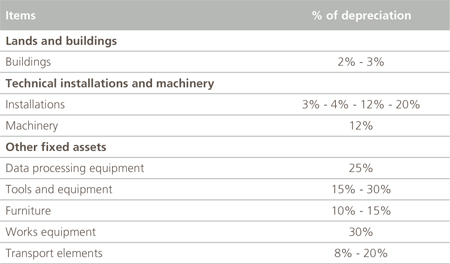
Waste ponds and similar assets are depreciated on the basis of the volume of waste in the ponds.
The assets’ residual values and useful economic lives are reviewed, and adjusted if necessary, at the end of the accounting period of the company which owns the asset.
When the carrying amount of an asset is higher than its recoverable amount, the carrying amount is reduced immediately to reflect the lower recoverable amount.
2.5. Fixed assets in projects (project finance)
This category includes property, plant and equipment and intangible assets of consolidated companies which are financed through Non-recourse Project Finance, that are raised specifically and solely to finance individual projects as detailed in the terms of the loan agreement.
These non-recourse Project Finance assets are generally the result of projects which consist of the design, construction, financing, application and maintenance of large- cale complex operational assets or infrastructures, which are owned by the company or are held under a concession agreement for a period of time. The projects are initially financed through non-recourse medium-term bridge loans and later by Non-recourse Project Finance.
In this respect, the basis of the financing agreement between the Company and the bank lies in the allocation of the cash flows generated by the project to the repayment of the principal amount and interest expenses, excluding or limiting the amount secured by other assets, in such a way that the bank recovers the investment solely through the cash flows generated by the project financed, any other debt being subordinated to the debt arising from the non-recourse financing applied to projects until the non-recourse debt has been fully repaid. For this reason, fixed assets in projects are separately reported on the face of the Consolidated Statement of Financial Position, as is the related non-recourse debt in the liability section of the same statement.
In addition, within the fixed assets in projects line item of the Consolidated Statement of Financial Position, assets are subclassified under the following two sub-headings, depending upon their nature and their accounting treatment:
- Intangible assets: includes fixed assets financed through non-recourse loans, mainly related to Service Concession Agreements, which are accounted for as intangible assets in accordance with IFRIC 12 (see Note 2.25). The rest of the assets shown under this heading are the intangible assets owned by the project company, the description and accounting treatment of which are set forth in Note 2.3.
- Property, plant and equipment: includes tangible fixed assets which are financed through a non-recourse loan and are not subject to a concession agreement as described below. Their accounting treatment is described in Note 2.4.
Non-recourse project finance typically includes the following guarantees:
- Shares of the project developers are pledged.
- Assignment of collection rights.
- Limitations on the availability of assets relating to the project.
- Compliance with debt coverage ratios.
- Subordination of the payment of interest and dividends to meeting inancial covenant ratios.
Once the project finance has been repaid and the non-recourse debt and related guarantees fully extinguished, any remaining net book value reported under this category is reclassified to the Property, Plant and Equipment or Intangible Assets line items, as applicable, in the Consolidated Statement of Financial Position.
2.6. Current and non-current classification
Assets are classified as current assets if they are expected to be realized in less than 12 months after the date of the Consolidated Statements of Financial Position. Otherwise, they are classified as non-current assets.
Liabilities are classified as current liabilities unless an unconditional right exists to defer their repayment by at least 12 months following the date of the Consolidated Statement of Financial Position.
2.7. Borrowing costs
Interest costs incurred in the construction of any qualifying asset are capitalized over the period required to complete and prepare the asset for its intended use. A qualifying asset is an asset that necessarily takes a substantial period of time to get ready for its internal use or sale, which in Abengoa is considered to be more than one year.
Costs incurred relating to non-recourse factoring are expensed when the factoring transaction is completed with the financial institution.
Remaining borrowing costs are expensed in the period in which they are incurred.
2.8. Impairment of non-financial assets
Abengoa reviews its property, plant and equipment, intangible assets with finite and indefinite useful life and goodwill to identify any indicators of impairment quarterly. In addition, goodwill and intangible assets with indefinite useful life or that are not yet in operation are tested for impairment on an annual basis.
These assets are impaired when the carrying amount of the Cash Generating Unit to which it belongs is lower than its recoverable amount. The recoverable amount is the higher of the market value less related cost to sell and the value in use, which is the present value of estimated future cash flows.
The recoverable amount of an asset is the higher of its fair value less costs to sell and its value in use, defined as the present value of the estimated future cash flows to be generated by the asset. In the event that the asset does not generate cash flows independently of other assets, Abengoa calculates the recoverable amount of the Cash-Generating Unit to which the asset belongs.
Assumptions used to calculate value in use include a discount rate, growth rates and projected changes in both selling prices and costs. The discount rate is estimated by Management, pre-tax, to reflect both changes in the value of money over time and the risks associated with the specific Cash-Generating Unit. Growth rates and changes in prices and costs are projected based upon internal and industry projections and management experience respectively. Financial projections range between 5 and 10 years depending on the growth potential of each Cash Generating Unit.
To calculate the value in use of the major goodwill balances (Recycling, Biofuels), the following assumptions were made:
- 10-year financial projections were used for those Cash-Generating Units (CGUs) that have high growth potential based on cash flows taken into account in the strategic plans for each business unit, considering a residual value based on the flow in the final year of the projection.
The use of these 10-year financial projections was based on the assumption that it is the minimum period necessary for the discounted cash flow model to reflect all potential growth in the CGUs in each business segment showing significant investments.
The aforementioned estimated cash flows were considered to be reliable due to their capacity to adapt to the real market and/or business situation faced by the CGU in accordance with the business's margin and cash-flow experience and future expectations.
These cash flows are reviewed and approved every six months by Senior Management so that the estimates are continually updated to ensure consistency with the actual results obtained.
In these cases, given that the period used is reasonably long, the Group then applies a zero growth rate for the cash flows subsequent to the period covered by the strategic plan. - For concession assets with a defined useful life and with a specific financial structure, cash flow projections until the end of the project are considered and no terminal value is assumed.
Concession assets have a contractual structure that permits to estimate quite accurately the costs of the project (both in the construction and in the operations periods) and revenue during the life of the project.
Projections take into account real data based in the contract terms and fundamental assumptions based in specific reports prepared by experts, assumptions on demand and assumptions on production. Additionally, assumptions on macro-economic conditions are also taken into account, such as inflation rates, future interest rates, etc. and sensitivity analysis are performed over all major assumptions which can have a significant impact in the value of the asset. - 5-year cash flow projections are used for all other CGUs, considering the residual value to be the cash flow in the final year projected.
- Cash flow projections of CGUs located in other countries are calculated in the functional currency of those CGUs and are discounted using rates that take into consideration the risk corresponding to each specific country and currency. Present values obtained with this method are then converted to euros at the year-end exchange rate of each currency.
- Taking into account that in most CGUs its specific financial structure is linked to the financial structure of the projects that are part of those CGUs, the discount rate used to calculate the present value of cash-flow projections is based in the weighted average cost of capital (WACC) for the type of asset, adjusted, if necessary, in accordance with the business of the specific activity and with the risk associated with the country where the project is performed.
- In any case, sensitivity analyses are performed, especially in relation with the discount rate used, residual value and fair value changes in the main business variables, in order to ensure that possible changes in the estimates of these items do not impact the possible recovery of recognized assets.
- Accordingly, the following table provides a summary of the discount rates used (WACC) and growth rates to calculate the recoverable amount for Cash-Generating Units with the operating segment to which it pertains:

In the event that the recoverable amount of an asset is lower than its carrying amount, an impairment charge for the difference recorded in the Consolidated Income Statement under the item “Depreciation, amortization and impairment charges”. With the exception of goodwill, impairment losses recognized in prior periods which are later deemed to have been recovered are credited to the same income statement heading.
2.9. Financial Investments (current and non-current)
Financial investments are classified into the following categories, based primarily on the purpose for which they were acquired:
a) financial assets at fair value through profit and loss;
b) loans and accounts receivable;
c) financial assets held to maturity; and
d) available for sale financial assets.
Classification of each financial asset is determinated by management upon initial recognition, and is reviewed at each year end.
a) Financial assets at fair value through profit and loss
This category includes the financial assets acquired for trading and those initially designated at fair value through profit and loss. A financial asset is classified in this category if it is acquired mainly for the purpose of sale in the short term or if it is so designated by Management. Financial derivatives are also classified as acquired for trading unless they are designated as hedging instruments.
These financial assets are recognized initially at fair value, without including transaction costs. Subsequent changes in fair value are recognized under “Gains or losses from financial assets at fair value” within the “Finance income or expense” line of the Consolidated Income Statement for the period.
b) Loans and accounts receivables
Loans and accounts receivables are non-derivative financial assets with fixed or determinable payments, not listed on an active market.
Following the application of IFRIC 12, certain assets under concessions can qualify as financial receivables (see Note 2.25).
Loans and accounts receivables are initially recognized at fair value plus transaction costs and subsequently measured at amortized cost in accordance with the effective interest rate method. Interest calculated using the effective interest rate method is recognized under “Interest income from loans and debts” within the “Finance income” line of the Consolidated Income Statement.
c) Financial assets held to maturity
This category includes non-derivative financial assets expected to be held to maturity which have fixed or determinable payments.
These assets are initially recognized at fair value plus transaction costs and subsequently measured at their amortized cost under the effective interest rate method. Interest calculated under the effective interest rate method is recognized under “Other finance income” within the “Other net finance income/expense” line of the Consolidated Income Statement.
d) Available for sale financial assets
This category includes non-derivative financial assets which do not fall within any of the previously mentioned categories. For Abengoa, they primarily comprise interests in other companies that are not consolidated.
Financial assets available for sale are initially recognized at fair value plus transaction costs and subsequently measured at fair value, with changes in fair value recognized directly in equity, with the exception of translation differences of monetary assets, which are charged to the Consolidated Income Statement. Dividends from available-for-sale financial assets are recognized under “Other finance income” within the “Other net finance income/expense” line of the Consolidated Income Statement when the right to receive the dividend is established.
When available-for-sale financial assets are sold or impaired, the accumulated amount recorded in equity is transferred to the Consolidated Income Statement. To establish whether the assets have been impaired, it is necessary to consider whether the reduction in their fair value is significantly below cost and whether it will be for a prolonged period of time. The cumulative gain or loss reclassified from equity to profit or loss when the financial assets are impaired is the difference between their acquisition cost (net of any principal repayment and amortization) and current fair value, less any impairment loss on that financial asset previously recognized in profit or loss.Impairment losses recognized in the Consolidated Income Statement are not subsequently reversed through the Consolidated Income Statement.
Acquisitions and disposals of financial assets are recognized on the trading date, i.e. the date upon which there is a commitment to purchase or sell the asset. Available for sale financial assets are derecognized when the right to received cash flows from the investment has expired or has been transferred and all the risks and rewards derived from owning the asset have likewise been substantially transferred.
At the date of each Consolidated Statement of Financial Position, the Group evaluates if there is any objective evidence that the value of any financial asset or any group of financial assets has been impaired.
2.10. Derivative financial instruments and hedging activities
Derivatives are recorded at fair value. The Company applies hedge accounting to all hedging derivatives that qualify to be accounted for as hedges under IFRS.
When hedge accounting is applied, hedging strategy and risk management objectives are documented at inception, as well as the relationship between hedging instruments and hedged items. Effectiveness of the hedging relationship needs to be assessed on an ongoing basis. Effectiveness tests are performed prospectively and retrospectively at inception and at each reporting date, following the dollar offset method or the regression method, depending on the type of derivatives.
The Company has three types of hedges:
a) Fair value hedge for recognized assets and liabilities
Changes in fair value of the derivatives are recorded in the Consolidated Income Statement, together with any changes in the fair value of the asset or liability that is being hedged.
b) Cash flow hedge for forecasted transactions
The effective portion of changes in fair value of derivatives designated as cash flow hedges are recorded temporarily in equity and are subsequently reclassified from equity to profit or loss in the same period or periods during which the hedged item affects profit or loss. Any ineffective portion of the hedged transaction is recorded in the Consolidated Income Statement as it occurs.
When options are designated as hedging instruments (such as interest rate options described in Note 14), the intrinsic value and time value of the financial hedge instrument are separated. Changes in intrinsic value which are highly effective are recorded in equity and subsequently reclassified from equity to profit or loss in the same period or periods during which the hedged item affects profit or loss. Changes in time value are recorded in the Consolidated Income Statement, together with any ineffectiveness.
When the hedged forecasted transaction results in the recognition of a non-financial asset or liability, gains and losses previously recorded in equity are included in the initial cost of the asset or liability.
When the hedging instrument matures or is sold, or when it no longer meets the requirements to apply hedge accounting, accumulated gains and losses recorded in equity remain as such until the forecast transaction is ultimately recognized in the Consolidated Income Statement. However, if it becomes unlikely that the forecast transaction will actually take place, the accumulated gains and losses in equity are recognized immediately in the Consolidated Income Statement.
c) Net investment hedges in foreign operation
Hedges of a net investment in a foreign operation, including the hedging of a monetary item considered part of a net investment, are recognized in a similar way to cash flow hedges. The foreign currency transaction gain or loss on the non-derivative hedging instrument that is designated as, and is effective as, an economic hedge of the net investment in a foreign operation shall be reported in the same manner as a translation adjustment. That is, reported in the cumulative translation adjustment section of equity to the extent it is effective as a hedge, as long as the following conditions are met: the notional amount of the non-derivative instrument matches the portion of the net investment designated as being hedged and the non-derivative instrument is denominated in the functional currency of the hedged net investment. In that circumstance, no hedge ineffectiveness would be recognized in earnings.
Amounts recorded in equity will be reclassified to the Consolidated Income Statement when the foreign operation is sold or otherwise disposed of.
Contracts held for the purposes of receiving or making payment of non-financial elements in accordance with expected purchases, sales or use of goods (“own-use contracts”) of the Group are not recognized as derivative instruments, but as executory contracts. In the event that such contracts include embedded derivatives, they are recognized separately from the host contract, if the economic characteristics of the embedded derivative are not closely related to the economic characteristics of the host contract. The options contracted for the purchase or sale of non-financial elements which may be cancelled through cash outflows are not considered to be own-use contracts.
Changes in fair value of derivative instruments which do not qualify for hedge accounting are recognized immediately in the Consolidated Income Statement. Trading derivatives are classified as a current assets or liabilities.
2.11. Fair value estimates
The fair value of financial instruments traded on active markets (such as officially listed derivatives), is determined by the market value as of the date of the Consolidated Statement of Financial Position.
A market is considered active when quoted prices are readily and regularly available from stock markets or financial intermediaries, among others, and these prices reflect current market transactions that regularly occur between parties operating independently.
The fair value of financial instruments which are not listed or which do not have readily available market values is determined by applying various valuation techniques that use assumptions based upon market conditions as of the date of the Consolidated Statement of Financial Position. The fair value of interest rate swaps is calculated as the present value of estimated future cash flows. The fair value of forward exchange rate contracts is measured on the basis of market forward exchange rates as at the date of Consolidated Statement of Financial Position.
The nominal value of receivables and payables less estimated impairment adjustments is assumed to be similar to their fair value due to their short-term nature. The fair value of financial liabilities is estimated as the present value of contractual future cash outflows, using market interest rate available to the Group for similar financial instruments.
Detailed information on fair values is included in Note 12.
2.12. Inventories
Inventories are valued at the lower of cost or net realizable value. In general, cost is determined by using the first-in-firstout (FIFO) method. The cost of finished goods and work in progress includes design costs, raw materials, direct labor, other direct costs and general manufacturing costs (assuming normal operating capacity). Borrowing costs are not included. The net realizable value is the estimated sales value in the normal course of business, less applicable variable selling costs.
Cost of inventories includes the transfer from equity of gains and losses on qualifying cash-flow hedging instruments related with the purchase of raw materials or with foreign exchange contracts.
2.13. Carbon emission credits (CERs)
Several Abengoa entities are involved in a number of external projects to reduce CO2 emissions through participation in Clean Development Mechanisms (CDM) and Joint Implementation (JI) programs with those countries/parties which are purchasing Carbon Emission Credits (CERs) and Emission Reduction Credits (ERUs), respectively. CDMs are projects in countries which are not required to reduce emission levels, whilst JIs are aimed at developing countries which are required to reduce emissions.
Both projects are developed in two phases:
1) Development phase, which, in turn, has the following stages:
- Signing an ERPA agreement (Emission Reduction Purchase Agreement), to which certain offer costs are associated.
- PDD (Project Design Document) development.
- Obtaining a certification from a qualified third party regarding the project being developed and submitting the certification to the United Nations, where it is registered in a database.
Thus, the Group currently holds various agreements for consultancy services within the framework of the execution of Clean Development Mechanisms (CDM). Costs incurred in connection with such consultancy services are recognized by the Group as non-current receivables.
2) Phase of annual verification of the reductions in CO2 emissions. After this verification, the company receives Carbon Emission Credits (CERs), which are registered in the National Register of Emission Rights. CERs are recorded as inventories and measured at market value.
Likewise, the company may hold Emission Allowances assigned by the competent EU Emission Allowance Authority (EUAs), which may also be measured at market price if held for sale. In case of the EUA are held for own use see Note 2.3.d. Furthermore, there are carbon fund holdings aimed at financing the acquisition of emissions from projects which contribute to a reduction in greenhouse gas emissions in developing countries through CDM’s and JI’s, as discussed above. Certain Abengoa companies have holdings in such carbon reduction funds which are managed by an external Fund Management team. The Fund directs the resources of the funds to purchasing Emission Reductions through CDM’s and JI’s projects.
The company with holdings in the fund incurs in a number of costs (ownership commissions, prepayments and purchases of CER’s). From the start, the holding is recorded on the balance sheet based upon the original Carbon Emission Credit (CER) allocation agreement; however this amount will be allocated over the life of the fund. The price of the CER is fixed for each ERPA. Based upon its percentage holding, and on the fixed price of the CER, it receives a number of CER’s as obtained by the Fund from each project.
These contributions are considered as long-term investments and are recognized in non-current assets in the Consolidated Statements of Financial Position under the heading of “Other receivables accounts”.
2.14. Biological assets
Abengoa recognizes sugar cane in production as biological assets. The production period of sugar cane covers the period from preparation of the land and sowing the seedlings until the plant is ready for first production and harvesting. Biological assets are classified as property, plant and equipment in the Consolidated Statement of Financial Position. Biological assets are recognized at fair value, calculated as the market value less estimated harvesting and transport costs.
Agricultural products harvested from biological assets, which in the case of Abengoa are cut sugar cane, are classified as inventories and measured at fair value less estimated sale costs at the point of sale or harvesting.
Fair value of biological assets is calculated using as a reference the forecasted market price of sugarcane, which is estimated using public information and estimates on future prices of sugar and ethanol. Fair value of agricultural products is calculated using as a the price of sugar cane made public on a monthly basis by the Cane, Sugar and Alcohol Producers Board (Consecana).
Gains or losses arising as a result of changes in the fair value of such assets are recorded, within “Other operating income” caption in the Consolidated Income Statement.
To obtain the fair value of the sugar cane while growing, a number of assumptions and estimates have been made in relation to the area of land sown, the estimated TRS (Total Recoverable Sugar contained within the cane) per ton to be harvested and the average degree of growth of the agricultural product in the different areas sown.
2.15. Clients and other receivables
Clients and other receivables relate to amounts due from customers for sales of goods and services rendered in the normal course of operation.
Clients and other receivables are recognized initially at fair value and are subsequently measured at amortized cost using the effective interest rate method, less provision for impairment. Trade receivables due in less than one year are carried at their face value at both initial recognition and subsequent measurement, provided that the effect of not discounting flows is not significant.
A provision for impairment of trade receivables is recorded when there is objective evidence that the Group will not be able to recover all amounts due as per the original terms of the receivables. The existence of significant financial difficulties, the probability that the debtor is in bankruptcy or financial reorganization and the lack or delay in payments are considered evidence that the receivable is impaired.
The amount of the provision is the difference between the asset’s carrying amount and the present value of estimated future cash flows discounted at the effective interest rate. When a trade receivable is uncollectable, it is written off against the bad debt provision.
Clients and other receivables which have been factored with financial entities are derecognized and hence removed from assets on the Consolidated Statement of Financial Position only if all risks and rewards of ownership of the related financial assets have been transferred, comparing the Company’s exposure, before and after the transfer, to the variability in the amounts and the calendar of net cash flows from the transferred asset. Once the Company’s exposure to this variability has been eliminated or substantially reduced, the financial asset has been transferred, and is derecognized from the Consolidated Statement of Financial Position (See Note 4.b).
2.16. Cash and cash equivalents
Cash and cash equivalents include cash in hand, cash in bank and other highly-liquid current investments with an original maturity of three months or less which are held for the purpose of meeting short-term cash commitments.
In the Consolidated Statement of Financial Position, bank overdrafts are classified as borrowings within current liabilities.
2.17. Share capital
Parent company shares are classified as equity. Transaction costs directly attributable to new shares are presented in equity as a reduction, net of taxes, to the consideration received from the issue.
Treasury shares are classified in Equity-Parent company reserves. Any amounts received from the sale of treasury shares, net of transaction costs, are classified equity.
2.18. Government grants
Non-refundable capital grants are recognized at fair value when it is considered that there is a reasonable assurance that the grant will be received and that the necessary qualifying conditions, as agreed with the entity assigning the grant, will be adequately complied with.
Grants related to income are recorded as liabilities in the Consolidated Statement of Financial Position and are recognized in “Other operating income” in the Consolidated Income Statement based on the period necessary to match them with the costs they intend to compensate.
Grants related to fixed assets are recorded as non-current liabilities in the Consolidated Statement of Financial Position and are recognized in “Other operating income” in the Consolidated Income Statement on a straight-line basis over the estimated useful economic life of the assets.
2.19. Loans and borrowings
External resources are classified in the following categories:
a) Non-recourse financing applied to projects (project financing) (see note 19);
b) Corporate financing (see Note 20);
Loans and borrowings are initially recognized at fair value, net of transaction costs incurred. Borrowings are subsequently measured at amortized cost and any difference between the proceeds initially received (net of transaction costs incurred in obtaining such proceeds) and the repayment value is recognized in the Consolidated Income Statement over the duration of the borrowing using the effective interest rate method.
Interest free loans, mainly granted for research and development projects, are initially recognized at fair value in liabilities in the Consolidated Statement of Financial Position. The difference between proceeds received from the loan and its fair value is initially recorded within “Grants and Other liabilities” in the Consolidated Statement of Financial Position, and subsequently recorded in “Other operating income- Grants” in the Consolidated income statement when the costs financed with the loan are expensed. In the case of interest free loans received for development projects where we record an intangible asset, income from the grant will be recognized according to the useful life of the asset, at the same path as we record its amortization.
Commissions paid for obtaining credit lines are recognized as transaction costs if it is probable that part or all of the credit line will be drawn down. If this is the case, commissions are deferred until the credit line is drawn down. If it is not probable that all or part of the credit line will be drawn down, commission costs are expensed in the period.
2.19.1. Convertible notes
Pursuant to the Terms and Conditions of each of the convertible notes issued, when investors exercise their conversion right, the Company may decide whether to deliver shares of the company, cash, or a combination of cash and shares (see Note 20.3 for further information).
In accordance with IAS 32 and 39, since Abengoa has a contractual right to choose the type of payment and one of these possibilities is paying through a variable number of shares and cash, the conversion option qualifies as an embedded derivative. Thus, the convertible bond is considered a hybrid instrument, which includes a component of debt and an embedded derivative for the conversion option held by the bondholder.
The Company initially measures the embedded derivative at fair value and classifies it under the derivative financial instruments liability heading. At the end of each period, the embedded derivative is re-measured and changes in fair value are recognized under “Other net finance income or expense” within the “Finance expense net” line of the Consolidated Income Statement. The debt component of the bond is initially recorded as the difference between the proceeds received for the notes and the fair value of the aforementioned embedded derivative. Subsequently, the debt component is measured at amortized cost until it is settled upon conversion or maturity. In general, debt issuance costs are recognized as a deduction in the value of the debt in the Consolidated Statement of Financial Position and included as part of its amortized cost.
2.19.2.Ordinary notes
The company initially recognizes ordinary notes at fair value, net of issuance costs incurred. Subsequently, notes are measured at amortized cost until settlement upon maturity. Any other difference between the proceeds obtained (net of transaction costs) and the redemption value is recognized in the Consolidated Income Statement over the term of the debt using the effective interest rate method.
2.20. Current and deferred income taxes
Income tax expense for the period comprises current and deferred income tax. Income tax is recognized in the Consolidated Income Statement, except to the extent that it relates to items recognized directly in equity. In these cases, income tax is also recognized directly in equity.
Current income tax expense is calculated on the basis of the tax laws in force or about to enter into force as of the date of the Consolidated Statement of Financial Position in the countries in which the subsidiaries and associates operate and generate taxable income.
Deferred income tax is calculated in accordance with the Consolidated Statement of Financial Position liability method, based upon the temporary differences arising between the carrying amount of assets and liabilities and their tax base. However, deferred income tax is not recognized if it arises from initial recognition of an asset or liability in a transaction other than a business combination that, at the time of the transaction, affects neither the accounting nor the taxable profit or loss. Deferred income tax is determined using tax rates and regulations which are enacted or substantially enacted at the date of the Consolidated Statement of Financial Position and are expected to apply and/or be in force at the time when the deferred income tax asset is realized or the deferred income tax liability is settled.
Deferred tax assets are recognized only when it is probable that sufficient future taxable profit will be available to use deferred tax assets.
Deferred taxes are recognized on temporary differences arising on investments in subsidiaries and associates, except where the timing of the reversal of the temporary differences is controlled by the Group and it is not probable that temporary differences will reverse in the foreseeable future.
2.21. Employee benefits
a) Share plans
Certain Group companies have obligations in connection with certain share-based incentive plans for managers and employees. These plans are linked to the achievement of certain management objectives during the upcoming years. When the shares have an active market (which is the case for plans linked to Abengoa shares), personnel expense is recognized during the vesting period based on their fair value at grant date. In either case, the impact of these share plans on Abengoa’s Consolidated Financial Statements is not significant. When there is no active market for the shares granted by the plan, personnel expense is recognized on the basis of the repurchase price identified in the plan during the vesting period.
Share plans are considered a cash-settled share-based payment plans in accordance with IFRS 2, since the company compensates the participants for their services in exchange for the assumption of the market risk on the shares. By use of the guarantee on the loan, Abengoa guarantees participants, up to the end of the plan period, no personal losses in conjunction with a change in the price of the shares purchased. As such, Abengoa measures and recognizes at the end of each reporting period, a liability based on the value of the shares. Upon expiration of the Plan, employees may sell the shares to repay the individual loan or may otherwise repay the loan as they wish.
b) Bonus schemes
The Group records the amount annually accrued in accordance with the percentage of compliance with the plan’s established objectives as personnel expense in the Consolidated Income Statement Expenses incurred from employee benefits are disclosed in Note 29.
2.22. Provisions and contingencies
Provisions are recognized when:
- There is a present obligation, either legal or constructive, as a result of past events;
- It is more likely than not that there will be a future outflow of resources to settle the obligation; and
- The amount has been reliably estimated.
Provisions are initially measured at the present value of the expected outflows required to settle the obligation and subsequently valued at amortized cost following the effective interest method. The balance of Provisions disclosed in the Notes reflects management’s best estimate of the potential exposure as of the date of preparation of the Consolidated Financial Statements.
Contingent liabilities are possible obligations, existing obligations with low probability of a future outflow of economic resources and existing obligations where the future outflow cannot be reliably estimated. Contingences are not recognized in the Consolidated Statements of Financial Position unless they have been acquired in a business combination.
2.23. Trade payables and other liabilities
Trade payables and other liabilities are obligations arising from the purchase of goods or services in the ordinary course of business and are recognized initially at fair value and are subsequently measured at their amortized cost using the effective interest method.
Other liabilities are obligations not arising from the purchase of goods or services in the normal course of business and which are not treated as financing transactions.
Advances received from customers are recognized as “Trade payables and other current liabilities”.
2.24. Foreign currency transactions
a) Functional currency
Financial statements of each subsidiary within the Group are measured and reported in the currency of the principal economic environment in which the subsidiary operates (subsidiary’s functional currency). The Consolidated Financial Statements are presented in euro, which is Abengoa’s functional and reporting currency.
b) Transactions and balances
Transactions denominated in a currency different from the subsidiary’s functional currency are translated into the subsidiary’s functional currency applying the exchange rates in force at the time of the transactions. Foreign currency gains and losses that result from the settlement of these transactions and the translation of monetary assets and liabilities denominated in foreign currency at the year-end rates are recognized in the Consolidated Income Statement, unless they are deferred in equity, as occurs with cash-flow hedges and net investment in foreign operations hedges.
c) Translation of the financial statements of foreign companies within the Group
Income Statements and Statements of Financial Position of all Group companies with a functional currency different from the group’s reporting currency (Euro) are translated to Euros as follows:
1) All assets and liabilities are translated to Euros using the exchange rate in force at the closing date of the Financial Statements.
2) Items in the Income Statement are translated into Euros using the average annual exchange rate, calculated as the arithmetical average of the average exchange rates for each of the twelve months of the year, which does not differ significantly from using the exchange rates of the dates of each transaction.
3) The difference between equity, including profit or loss calculated as described in (2) above, translated at the historical exchange rate, and the net financial position that results from translating the assets, and liabilities in accordance with (1) above, is recorded in equity in the Consolidated Statement of Financial Position under the heading “Accumulated currency translation differences”.
Results of companies carried under the equity method are translated at the average annual exchange rate calculated described in (2) above.
Adjustments to the goodwill and the fair value that arise on the acquisition of a foreign company are treated as assets and liabilities of the foreign company and are translated at the year-end exchange rate.
2.25. Service concession agreements
As established in IFRIC 12, Service Concession Agreements are public-to-private arrangements in which the public sector controls or regulates the service provided with the infrastructure and their prices, and it is contractually guaranteed to gain, at a future time, ownership of the infrastructure through which the service is provided. The infrastructures accounted for by the Group as concessions are mainly related to the activities concerning power transmission lines, desalination plants, cogeneration plants and certain thermo-solar electricity generation plants. The infrastructure used in a concession can be classified as a financial asset or an intangible asset, depending on the nature of the payment entitlements established in the agreement.
The Group recognizes an intangible asset within “Fixed assets in projects” to the extent that it has a right to charge final customers for the use of the infrastructure. This intangible asset is subject to the provisions of IAS 38 and is amortizable, taking into account the estimated period of commercial operation of infrastructure. The Group recognizes and measures revenue, costs and margin for providing construction services during the period of construction of the infrastructure in accordance with IAS 11 “Construction Contracts” and revenue for other services in accordance with IAS 18 “Revenue”.
Service Concession Agreements are accounted for in accordance with the following criteria:
1) Total construction costs, including associated financing costs, are recorded as intangible assets within “Fixed assets in projects”. Profits attributable to the construction phase of the infrastructure are recognized using the percentage of completion method, based on the fair value assigned to the construction phase and the concession phase.
2) The intangible asset is usually amortized on a straight-line basis over the period of the concession.
3) The amounts recognized in the Consolidated Income Statement during the period of the concession are as follows:
- Ordinary income: the annual updated concession fee income is recognized in each period.
- Operating costs: operating and maintenance costs and general overheads and administrative costs are charged to the Consolidated Income Statement in accordance with the nature of the cost incurred (amount due) in each period. Fixed assets are amortized as per point 2) above.
- Financial costs: financing costs and exchange rate differences arising from repayable debt denominated in foreign currencies are charged to the Consolidated Income Statement.
4) At the end of each period, each project is tested for impairment if the invested costs are considered not recoverable.
In those concession agreements where the grantor of the concession is responsible for the payment of the operator’s expenses and retains substantially all the legal risks associated with the concession, the asset arising from the construction phase of the project is reported as a non-current receivable within the line item Loans (non-current portion) under the noncurrent Financial accounts receivable caption of the Consolidated Statement of Financial Position, provided that it is possible to calculate the amount. The non-current receivable is measured at amortized cost in accordance with the effective interest rate method and gradually reduced during the term of the contract against the annual fees received (see also note 2.26.c). Interest calculated using the effective interest rate method is recognized within the line item “Interest income from loans and debt”, under the “Finance income” caption of the Consolidated Income Statement.2.26. Revenue recognition
a) Ordinary income
Ordinary income comprises the fair value of sales of goods or services, excluding VAT or similar taxes, any discounts or returns and excluding sales between Group entities.
Ordinary income is recognized as follows:
- Income from the sale of goods is recognized when the Group delivers the goods to the client, the client accepts them and it is reasonably certain that the related receivables will be collectible.
- Income from the sale of services is recognized in the period in which the service is provided.
- Interest income is recognized using the effective interest rate method. When a receivable is considered impaired, the carrying amount is reduced to its recoverable amount, discounting the estimated future cash flows at the original effective interest rate of the instrument and recording the discount as a reduction in interest income.
- Income from interest on loans that have been impaired is recognized when the cash is collected or on the basis of the recovery of the cost when the conditions are guaranteed.
- Dividend income is recognized when the right to receive payment is established.
b) Construction contracts
Costs incurred in relation to construction contracts are recognized when incurred. When the outcome of a construction contract cannot be reliably estimated, revenues are only recognized up to the amount of the costs incurred to date that are likely to be recovered.
When the outcome of a construction contract can be reliably estimated and it is probable that it will be profitable, revenue from the contract is recognized over the term of the contract. When it is probable that the costs of the project will be greater than its revenue, expected loss is recognized immediately as an expense. To determine the appropriate amount of revenue to be recognized in any period, the percentage of completion method is applied. The percentage of completion method considers, at the date of the Statement of Financial Position, the actual costs incurred as a percentage of total estimated costs for the entire contract. Costs incurred in the period which relate to future project activities are not included when determining the percentage of completion. Prepayments and certain other assets are recognized as inventories, depending upon their specific nature.
Partial billing that has not yet been settled by the clients and withholdings are included under the Trade and other receivables heading.
Gross amounts owed by clients for ongoing works in which the costs incurred plus recognized profits (minus recognized losses) exceed partial billing are presented as assets under the heading of “Unbilled Revenue” within “Clients and other receivables” heading of the Statement of Financial Position.
On the other hand, amounts outstanding from customers for work in progress for which the billing to date is greater than the costs incurred plus recognized profits (less recognized losses) are shown as liabilities within the line item “Advance payments from clients” in the Trade payables and other current liabilities caption of the Consolidated Statement of Financial Position.
Lastly, as stated in point 2.4.2 on the measurement of property, plant and equipment in internal asset construction projects outside the scope of IFRIC 12 on Service Concession Arrangements (see Note 2.25), revenues and profits between group companies are eliminated, meaning that such assets are shown at their acquisition cost.
c) Concession contracts
Concession contracts are public-private agreements for periods usually between 20 and 30 years including both the construction of infrastructure and future services associated with the operation and maintenance of assets in the concession period.
Revenues are obtained during the concession period via an annual charge payable by the grantor of the concession, which, in certain cases, is adjusted for inflation (see note 2.25 for revenue recognition). Typically the annual charge is updated based upon the official pricing index of the country and in the currency in which the fee is denominated and the fluctuations in local currency against a currency basket.
2.27. Leases
Lease contracts of fixed assets in which a Group company is the lessee and substantially retains all the risks and rewards associated to the ownership of the assets are classified as finance leases.
Finance leases are recognized at inception of the lease at the lower of the fair value of the leased asset and the present value of the minimum lease payments over the contract term. Each lease payment is distributed between debt and financing costs, in a way which establishes a constant interest rate on the outstanding debt. The amounts to be paid over the lease term, net of financing costs, are recognized as non-current and current payables, as appropriate. The interest portion of the financing costs is charged to the Consolidated Income Statement over the period of the lease agreement, in order to obtain a constant periodic interest rate on the balance of the outstanding debt in each period. Assets acquired under finance lease agreements are depreciated over the shorter of the useful life of the asset and the lease term.
Lease agreements undertaken by the Group in which the entity entering into the agreement does not substantially retain all the risks and rewards associated with the ownership of the asset are classified as operating leases. Payments made under operating leases are charged to the Consolidated Income Statement (net of any incentives received from the lessor) on a straight-line basis over the lease term.
2.28. Dividend distribution
Dividends paid to the shareholders of the parent company of the Group are recognized as a liability in the period in which the dividend payment is approved by the shareholders.
2.29. Segment reporting
Information on the Group’s operating segments is presented in accordance with internal information provided to the Group’s Chief Operating Decision Maker (CODM). The CODM, responsible for assigning resources and evaluating the performance of the operating segments, has been identified as the CEO and the Chairman.
As described in Note 5, the CODM reviews the business by 8 operating segments which are in turn grouped, for business purposes, into three activities: Engineering & Construction, Concession-type Infrastructures and Industrial Production.
Geographically, the Group reports financial information by 6 regions which are Spain (home market), USA, Europe (excluding Spain), Latin America (excluding Brazil), Brazil and other (the remaining overseas markets).
For detailed information on segment reporting, see Note 5.
2.30. Environmental assets
Equipment, installations and systems used to eliminate, reduce or control possible environmental impacts are recognized applying the same criteria used for other similar assets.
Provisions made for environmental restoration, costs of restructuring and litigations are recognized when the company has a legal or constructive obligation as a result of past events, it becomes probable that an outflow of resources will be necessary to settle the obligation and the outflow can be reliably estimated.
Note 33.7 gives additional information on the Group’s environmental policies.
2.31. Severance payments
Severance payments are made to employees in the event that the company terminates their employment contract prior to the normal retirement age or when the employee voluntarily accepts redundancy in the terms offered by the employer. The Group recognizes severance payments when it is demonstrably committed to third parties to provide indemnities for leaving the company or to dismiss the current workers in accordance with a detailed formal plan, with no possibility of retracting.
2.32. Non-current Assets held for sale and discontinued operations
The Group classifies property, plant and equipment, intangible assets and disposal groups (groups of assets that are to be sold together with their directly associated liabilities) as non-current assets held for sale when, at the date of the Consolidated Statement of Financial Position, an active programme to sell them has been initiated by Management and the sale is foreseen to take place within the following twelve months.
The Group includes in discontinued operations those business lines which have been sold or otherwise disposed of or those that meet the conditions to be classified as held-for-sale. Discontinued operations also include those assets which are included in the same sale programme together with the business line. Entities which are acquired exclusively with a view for resale are also classified as discontinued operations.
Assets held for sale or disposal groups are measured at the lower of their carrying value or fair value less estimated costs necessary to sell them. They are no longer amortized or depreciated from the moment they are classified as non-current assets held for sale.
Assets held for sale and the components of disposal groups are presented in the Consolidated Statement of Financial Position grouped under a single heading as “Assets held for sale and discontinued operations”. Liabilities are also grouped under a single heading as “Liabilities held for sale and discontinued operations”.
The after-tax profit or loss on discontinued operations is presented in a single line within the Consolidated Income Statement under the heading “Profit (loss) from discontinued operations, net of tax”.
-
Note 3.- Critical accounting policies
The preparation of the Consolidated Financial Statements in conformity with IFRS requires to make estimates and judgments that affect the reported amounts of assets, liabilities, revenues and expenses. Actual results may differ from these estimates under different assumptions or conditions. The most critical accounting policies, which reflect significant management estimates and judgment to determine amounts in the Consolidated Financial Statements are:
- Impairment of intangible assets and goodwill
- Consolidation through de facto control
- Revenue from construction contracts
- Income taxes and recoverable amount of deferred tax assets
- Share-based payments
- Derivative financial instruments and hedging
- Concession agreements
Some of these accounting policies require the application of significant judgment by management to select the appropriate assumptions to determine these estimates. These assumptions and estimates are based on our historical experience, advice from experienced consultants, forecasts and other circumstances and expectations as of the close of the financial period. The assessment is considered in relation to the global economic situation of the industries and regions where the Group operates, taking into account future development of our businesses. By their nature, these judgments are subject to an inherent degree of uncertainty; therefore, actual results could materially differ from the estimates and assumptions used. In such cases, the carrying values of assets and liabilities are adjusted.
As of the date of preparation of these Consolidated Financial Statements, no relevant changes in the estimates made are anticipated and, therefore, no significant changes in the value of the assets and liabilities recognized at December 31, 2012 are expected.
Although these estimates and assumptions are being made using all available facts and circumstances, it is possible that future events may require management to amend such estimates and assumptions in future periods. Changes in accounting estimates are recognized prospectively, in accordance with IAS 8, in the Consolidated Income Statement of the year in which the change occurs. The Group significant accounting policies are more fully described in Note 2.
Impairment of intangible assets and goodwill
Goodwill and Intangible assets which have not yet come into operation or that have an indefinite useful life are not amortized and are tested for impairment on an annual basis or whenever there is an impairment indicator. Goodwill is tested for impairment within the Cash-Generating Unit to which it belongs. Other intangible assets are tested individually, unless they do not generate cash flows independently from other assets, in which case they are tested within the Cash-Generating Unit to which they belong.
For those cash generating units with high potential growth, the Group uses cash flow projections for a period of 10 years based on the cash flows identified in the Group’s strategic plans, which are reviewed and approved every six months by the management of the Group. The residual value is calculated based on the cash flows of the latest year projected using a steady or nil growth rate. The use of a 10 year period is based on the consideration that this is the minimum period that needs to be used in order to appropriately reflect all the potential growth of these cash generating units. In addition, 10 years projections are prepared based on the historical experience within the Group in preparing long-term strategic plans, which are considered reliable and are prepared on the basis of the Group’s internal control system. These cash flows are considered reliable since they can easily adapt to the changes of the market and of the business segment to which cash generating units belong, based on the Group’s past experience on cash flows and margins and on future expectations.
For other cash generating units the Group uses cash flows projections based on a period of 5 years, calculating the residual value based on the cash flows of the latest year projected, using a growth rate which does not exceed the long term rate for the market in which the cash generating units operates.
Projected cash flows are discounted using the Weighted Average Cost of Capital (see Note 2.8), adjusted for the specific risks associated to the business unit to which the cash generating unit belongs.
Based on values in use calculated in accordance with the assumptions and hypotheses described above and in Note 8 for the years 2012 and 2011, the recoverable amount of the cash generating units to which goodwill was assigned is higher than their carrying amount. Detailed sensitivity analysis has been carried out and the Management is confident that the carrying amount of the cash generating units will be recovered in full. Main variables considered in sensitivity analysis are growth rates, discount rates based in weighted average cost of capital (WACC) and the main variables of each business.
During the years 2012 and 2011 there were no intangible assets with indefinite useful life or intangible assets not yet in use that were impaired.
Consolidation through de facto control
De facto control describes the situation where an entity does not hold majority of the voting shares in another entity, but is deemed to have control for reasons other than potential voting rights, contract or the Bylaws.
Judgment is required in applying the control concept to assess whether de facto control exists. The loss of de facto control in cases where applicable would not have a significant impact on the assets, liabilities, results of operations and cash flows of the Group.
Revenue from construction contracts
Revenue from construction contracts is recognized using the percentage-of-completion method for contracts whose outcome can be reliably estimated and it is probable that they will be profitable. When the outcome of a construction contract cannot be reliably estimated, revenue is recognized only to the extent it is probable that contract costs incurred will be recoverable.
As described in Note 2.26.b), the percentage of completion is determined at the date of every Consolidated Statement of Financial Position based on the actual costs incurred as a percentage of total estimated costs for the entire contract.
Revenue recognition using the percentage-of-completion method involves the use of estimates of certain key elements of the construction contracts, such as total estimated contract costs, allowances or provisions related to the contract, period of execution of the contract and recoverability of the claims. The Company has established, over the years, a robust project management and control system, with periodic monitoring of each project. This system is based on the long-track experience of the Group in constructing complex infrastructures and installations. As far as practicable, the Group applies past experience in estimating the main elements of construction contracts and relies on objective data such as physical inspections or third parties confirmations. Nevertheless, given the highly tailored characteristics of the construction contracts, most of the estimates are unique to the specific facts and circumstances of each contract.
Although estimates on construction contracts are periodically reviewed on an individual basis, we exercise significant judgments and not all possible risks can be specifically quantified.
It is important to point out that, as stated in Note 2.4.2 on the measurement of property, plant and equipment, in the internal asset construction projects outside the scope of IFRIC 12 on Service Concession Arrangements (see Note 2.25), the totality of the revenues and profits between group companies is eliminated, meaning that said assets are shown at their acquisition cost.
Income taxes and recoverable amount of deferred tax assets
Determining income tax expense requires judgment in assessing the timing and the amount of deductible and taxable items, as well as the interpretation and application of tax laws in different jurisdictions. Due to this fact, contingencies or additional tax expenses could arise as a result of tax inspections or different interpretations of certain tax laws by the corresponding tax authorities.
Group Management assesses the recoverability of deferred tax assets on the basis of estimates of the future taxable profit. In making this assessment, Management considers the foreseen reversal of deferred tax liabilities, projected taxable profit and tax planning strategies. This assessment is carried out on the basis of internal projections, which are updated to reflect the Group’s most recent operating trends.
The Group’s current and deferred income taxes may be impacted by events and transactions arising in the normal course of business as well as by special non-recurring circumstances. Assessment of the appropriate amount and classification of income taxes is dependent on several factors, including estimates of the timing and realization of deferred tax assets and the timing of income tax payments.
Actual collections and payments may materially differ from these estimates as a result of changes in tax laws as well as unforeseen future transactions impacting the income tax balances.
Share-based payments
The Group maintains various share-based incentive plans for some of its managers and employees at parent and subsidiary companies level. The most significant of these plans was granted in 2005 making available to 99 managers of Abengoa linked to the achievement of certain business objectives. Based on its specific conditions, the share-based plan is considered a cash-settled share-based payment, by means of which the company rewards the services provided by the managers, incurring a liability for an amount based on the value of the shares.
Note 29 to this Consolidated Report reflects the information detailing the expenses incurred from employee benefits.
The fair value of the services received in exchange for the granting of the option is recognized as a personnel expense using the Black-Scholes valuation model. Certain inputs are used in the Black-Scholes model to generate variables such as the share price, the estimated return per dividend, the expected life of the option (5 years), the interest rates and the share market volatility, as appropriate.
The total amount charged to expenses during the vesting period is determined by reference to the fair value of a hypothetical option to sell ("put") granted by the company to the managers, excluding the effect of the vesting conditions that are not market conditions, and including in the hypotheses only the number of options that are expected will become exercisable. In this regard, the number of options it is expected will become exercisable is considered in the calculation.
The determination of the fair value of the services requires the use of estimates and certain assumptions. At the end of each financial year, the company revises the estimates of the number of options that are expected will become exercisable and recognizes the impact of this revision of the original estimates, where appropriate, in the Consolidated Income Statement. Changes in the estimates and assumptions used in the valuation model could impact the results of operations.
Derivatives and hedging
The Group uses derivatives in order to mitigate risks arising from foreign exchange, interest rates and changes in the prices of assets and commodities purchased (principally zinc, aluminum, grain, ethanol, sugar and gas). Derivatives are initially recognized at fair value on the date that the derivative contract is entered into, and are subsequently re-measured at fair value at each reporting date (see Note 2.10 and 2.19.1 for a full description of the accounting policy for derivatives).
Contracts held for the purposes of receiving or making payment of non-financial elements in accordance with expected purchases, sales or use of goods (own-use contracts) of the Group are not recognized as financial derivative instruments, but as executory contracts. In the event that such contracts include embedded derivatives, those derivatives are recorded separately from the original contract, if the economic characteristics of the embedded derivative are not closely related to the economic characteristics of the original host contract. Options contracted for the purchase or sale of non-financial elements which may be cancelled through cash outflows are not considered to be “own-use contracts".
The inputs used to calculate fair value of our derivatives are based on prices observable on not quoted markets, through the application of valuation models (Level 2). The valuation techniques used to calculate fair value of our derivatives include discounting estimated future cash flows, using assumptions based on market conditions at the date of valuation or using market prices of similar comparable instruments, amongst others. The valuation of derivatives and the identification and valuation of embedded derivatives and own-use contracts requires the use of considerable professional judgment. These determinations were based on available market information and appropriate valuation methodologies. The use of different market assumptions and/or estimation methodologies may have a material effect on the estimated fair value amounts.
Concession agreements
The analysis on whether the IFRIC 12 applies to certain contracts and activities involves various complex factors and it is significantly affected by legal interpretation of certain contractual agreements or other terms and conditions with public sector entities.
Therefore, the application of IFRIC 12 requires extensive judgment in relation with, amongst other factors, (i) the identification of certain infrastructures (and not contractual agreements) in the scope of IFRIC 12, (ii) the understanding of the nature of the payments in order to determine the classification of the infrastructure as a financial asset or as an intangible asset and (iii) the recognition of the revenue from construction and concessionary activity.
Changes in one or more of the factors described above may significantly affect the conclusions as to the appropriateness of the application of IFRIC 12 and, therefore, the results of operations or our financial position (see Note 10.1).
Application of IFRIC 12 to concession assets in 2012 and 2011 has meant the recognition of revenues amounting to € 3,412 and €1,958, respectively.
-
Note 4.- Financial risk management
Abengoa’s activities are undertaken through its operating segments and are exposed to various financial risks: market risk (including currency risk, interest rate risk and price risk), credit risk, liquidity risk and capital risk.
The risk management model attempts to minimize the potential adverse impact of such risks upon the Group’s financial performance. Risk is managed by the Group’s Corporate Finance Department, which is responsible for identifying and evaluating financial risks in conjunction with the Group’s operating segments, quantifying them by project, region and company.
Written internal risk management policies exist for global risk management, as well as for specific areas of risk, such as foreign exchange risk, credit risk, interest rate risk, liquidity risk, the use of hedging instruments and derivatives and the investment of cash surpluses.
In addition, there are official written management regulations regarding key controls and control procedures for each company and the implementation of these controls is monitored through internal audit procedures.
The Group is affected by the following financial risks:
a) Market risk
Market risk arises when group activities are exposed fundamentally to financial risk derived from changes in foreign exchange rates, interest rates and changes in the fair values of certain raw materials.
To hedge such exposure, Abengoa uses currency forward contracts, options and interest rate swaps as well as future contracts for commodities. The Group does not generally use derivatives for speculative purposes.
- Foreign exchange rate risk: the international activity of the Group generates exposure to foreign exchange rate risk.
Foreign exchange rate risk arises when future commercial transactions and assets and liabilities recognized are not denominated in the functional currency of the group company that undertakes the transaction or records the asset or liability. The main exchange rate exposure for the Group relates to the US Dollar against the Euro.
To control foreign exchange risk, the Group purchases forward exchange contracts. Such contracts are designated as fair-value or cash-flow hedges, as appropriate. In the event that the exchange rate of the US Dollar had risen by 10% against the Euro as of December 31, 2012, with the rest of the variables remaining constant, the effect in the Consolidated Income Statement would have been a loss of €10,602 thousand (loss of €1,206 thousand n 2011) mainly due to the US Dollar net liability position of the Group in companies with Euro functional currency and an decrease of €2,440 thousand (increase of €3,338 in 2011) in other reserves as a result of the cash flow hedging effects on highly probable future transactions.
Details of the financial hedging instruments and foreign currency payments as of December 31, 2012 and 2011 are included in Note 14 of these Notes to these Consolidated Financial Statements. - Interest rate risk arises mainly from financial liabilities at variable interest rates.
Abengoa actively manages its risks exposure to variations in interest rates associated with its variable interest debt.
In non-recourse financing (see Note 19), as a general rule, the Company enters into hedging arrangements for at least 80% of the amount and the timeframe of the relevant financing.
In corporate financing (see Note 20), as general rule, 80% of the debt is covered throughout the term of the debt; in addition, in 2009 and 2010, Abengoa issued notes at a fixed interest rate.
The main interest rate exposure for the Group relates to the variable interest rate with reference to the Euribor.
To control the interest rate risk, the Group primarily uses interest rate swaps and interest rate options (caps), which, in exchange for a fee, offer protection against an increase in interest rates.
In the event that Euribor had risen by 25 basic points as of December 31, 2012, with the rest of the variables remaining constant, the effect in the Consolidated Income Statement would have been a profit of €4,004 thousand (profit of €15,923 thousand in 2011) mainly due to an increase of €52,163 thousand (increase of €44,077 thousand in 2011) in other reserves.
A breakdown of the interest rates derivatives as of December 31, 2012 is provided in Note 14 of these Notes to the Consolidated Financial Statements. - Risk of change in commodities prices arises both through the sale of the Group’s products and the purchase of commodities for production processes. The main risk of change in commodities prices for the Group is related to the price of zinc, aluminum, grain, ethanol, sugar and gas.
In general, the Group uses futures and options listed on organized markets, as well as OTC (over-the-counter) contracts with financial institutions, to mitigate the risk of market price fluctuations.
At December 31, 2012, if the price of zinc had increased by 10%, with the rest variables remaining constant, the effect in the Consolidated Income Statement would have been a profit of €3,900 thousand (profit of €2,174 thousand in 2011) and a reduction in other reserves of €5,293 thousand (reduction of €13,468 thousand in 2011) as a result of the cash flow hedging effects.
At December 31, 2012, if the price of grain had increased by 10%, with the rest variables remaining constant, the effect in the Consolidated Income Statement would have been a loss of €35,092 thousand (null in 2011) and a reduction in other reserves of €16,391 thousand (reduction of €2,661 thousand in 2011) due to open derivative contracts primarily grain sales held by the Group.
At December 31, 2012, if the price of ethanol had increased by 10%, with the rest variables remaining constant, the effect in the Consolidated Income Statement would have been a profit of €11,035 thousand (null in 2011) and null impact in other reserves (increase of €969 thousand in 2011) due to open derivative contracts primarily ethanol purchases held by the Group.
A breakdown of the commodity derivative instruments as of December 31, 2011 is included in Note 14 to these Consolidated Financial Statements.
In addition, certain Bioenergy Business Group companies engage in purchase and sale transactions in the grain and ethanol markets, in accordance with a management policy for trading transactions.
Management has approved and supplemented trading strategies to control the purchase and sale of forward and swap contracts, mainly for sugar, grain and ethanol, which are reported on a daily basis, following the internal procedures established in the Transactions Policy. As a risk-mitigation element, the company sets daily limits or “stop losses” for each strategy, depending on the markets in which it operates, the financial instruments purchased and the risks defined in the transaction.
These transactions are measured monthly at fair value through the Consolidated Income Statement. In 2012, Abengoa recorded profit of €11,768 thousand (loss of €4,593 thousand in 2011), €11,768 thousand of which related to profit on settled transactions (€4,567 thousand in 2011) and €0 thousand to open derivative contracts valued at the year ended (€26 thousand in 2011).
b) Credit risk
The main financial assets exposed to credit risk derived from the failure of the counterparty to meet its obligations are trade and other receivables, current financial investments and cash.
a) Clients and other receivables (see Note 15).
b) Current financial investments and cash (see Notes 13, 14, 15 and 17).
- Clients and other receivables: Most receivables relate to clients operating in a range of industries and countries with contracts that require ongoing payments as the project advances, the service is rendered or upon delivery of the product. It is a common practice for the company to reserve the right to cancel the work in the event of a material breach, especially non-payment.
In general, and to mitigate the credit risk, as requirement prior to any commercial contract or business agreement, the company generally holds a firm commitment from a leading financial institution to purchase the receivables through a non-recourse factoring arrangement. Under these agreements, the company pays the bank for assuming the credit risk and also pays interest for the discounted amounts. The company always assumes the responsibility that the receivables are valid.
Abengoa derecognizes the factored receivables from the Consolidated Statement of Financial Position when all the conditions of IAS 39 for derecognition of assets are met. In other words, an analysis is made to determine whether all risks and rewards of the financial assets have been transferred, comparing the company’s exposure, before and after the transfer, to the variability in the amounts and the calendar of net cash flows from the transferred asset. Once the company’s exposure to this variability has been eliminated or substantially reduced, the financial asset has been transferred.
In general, Abengoa considers that the most significant risk related to these assets within its activity is the risk of uncollectibility, since: a) trade receivables may be quantitatively significant during the progress of work performed for a project or service rendered; b) it would not be within the company’s control. However, the risk of delays in payment is considered low in these contracts and typically relates to technical problems, i.e. associated with the technical risk of the service provided and, therefore, within the company’s control.
In any case, to hedge those contracts in which the possibility of a payment delay from the client, with no commercial justification, could theoretically be identified as a risk associated to the financial asset, Abengoa establishes that, not only should the risk of legal insolvency (bankruptcy, etc.) be covered, but also that of de facto or evident insolvency (arising from the client’s management of its own cash, even though there is no “general moratorium”).
If the company concludes that the risk associated to the contract has been transferred to the financial institution, the receivable is derecognized in the Consolidated Statement of Financial Position at the time it is transferred, in accordance with IAS 39.20.
Taking into account this general policy of using non-recourse factoring, to have an accurate estimate of the Group’s exposure to credit risk, it would be necessary to exclude from the accounts receivable balance unbilled revenues for which factoring arrangements exist, trade receivables not yet sent to factoring and receivables covered by credit insurance contracts.
An ageing of trade receivables as of December 31, 2012 and 2011 is included in Note 15 ”Clients and other receivable accounts”. The same note also discloses the credit quality of the clients as well as the movement on provisions for receivables for the years ended December 31, 2012 and 2011. - Financial investments: to control credit risk in financial investments, the Group has established corporate criteria which require that counterparties are always highly rated financial entities and government debt, as well as establishing investing limits with periodic review.
c) Liquidity risk
Abengoa’s liquidity and financing policy is intended to ensure that the company keeps sufficient funds available to meet its financial obligations as they fall due. Abengoa uses two main sources of financing:
- Non-recourse project financing, which is typically used to finance any significant investment (see Notes 2.5 and 19). The repayment profile of each project is established on the basis of the projected cash flow generation of the business, allowing for variability depending on whether the cash flows of the transaction or project can be forecast accurately. This ensures that sufficient financing is available to meet deadlines and maturities, which mitigates the liquidity risk significantly.
- Corporate Financing, used to finance the activities of the remaining companies which are not financed under the aforementioned financing model. This means of financing is managed through Abengoa S.A., which pools cash held by the rest of the companies so as to be able to re-distribute funds in accordance with the needs of the Group (see Notes 2.19 and 20) and to ensure that the necessary resources are obtained from the bank and capital markets.
To ensure there are sufficient funds available for debt repayment in relation to its cash-generating capacity, the Corporate Financial Department annually prepares and the Board of Directors reviews a Financial Plan that details all the financing needs and how such financing will be provided. We fund in advance disbursements for major cash requirements, such as capital expenditures, debt repayments and working capital requirements. In addition, as a general rule, we do not commit our own equity in projects until the associated long term financing is obtained.
Abengoa has maintained its financing needs covered for 2012 since it completed refinancing in 2012 of syndicated loans as well as new financing transactions in subsidiaries which have the support of export credit agencies. In addition, in January and February 2013 the Company has issued €400 M convertible notes due 2019 and €250 M ordinary notes due 2018 in order to extend its debt maturities (see Note 33.8).
We aim to maintain our strong liquidity position, extend the debt maturities of our existing corporate loans and bonds, continue to access the capital markets from time to time, as appropriate, and further diversify our funding sources. We aim to continue to raise equity funding at the project company level through partnerships.
In accordance with the foregoing, the sources of finance are diversified, in an attempt to prevent concentrations that may affect our liquidity risk.
An analysis of the Group’s financial liabilities classified into relevant maturity groupings based on the remaining period is included in the following Notes to these Consolidated Financial Statements:

d) Capital risk
The Group manages capital risk to ensure the continuity of the activities of its subsidiaries from an equity standpoint by maximizing the return for the shareholders and optimizing the structure of equity and debt in the respective companies or projects.
Since the admission of its shares to trade on the stock market, the company has grown in the following ways:
- Cash flows generated by conventional businesses;
- Financing of new investments through non-recourse financing, which also generates induced business for conventional businesses;
- Corporate financing, either through banks or capitals markets;
- Issuance of new shares of subsidiaries through organized markets;
- Assets rotation or divestures, such as the wind activity divestiture, divestiture of Telvent or the sale of mature concessional shares, such as the sale in two portions of certain transmission line concession activity in Brazil (for details see Note 6.2.b.).
- Capital increase carried out for €300 M in 2011.
The leverage objective of the activities of the company is not measured based on the level of debt on own resources, but on the nature of the activities:
- For activities financed through Non-recourse Financing each project is assigned a leverage objective based on the cash and cash flow generating capacity, generally, of contracts that provide these projects with highly recurrent and predictable levels of cash flow generation.
- For activities financed with Corporate Financing, the objective is to maintain reasonable leverage, defined as three (3) times corporate Ebitda over Net Corporate Debt (excluding the Ebitda and the non-recourse financing).
- Foreign exchange rate risk: the international activity of the Group generates exposure to foreign exchange rate risk.
-
Note 5.- Financial information by segment
5.1. Information by business segment
As indicated in Note 1, the Abengoa’s activity is grouped under the following three activities which are in turn composed of eight segments as defined by IFRS 8:
- Engineering and construction; includes our traditional engineering activities in the energy and water sectors, with more than 70 years of experience in the market as well as the development of solar technology.
This activity comprises two operating segments:- Engineering and construction – Abengoa is specialized in carrying out complex turn-key projects for thermosolar plants, solar-gas hybrid plants, conventional generation plants, biofuels plants and water infrastructures, as well as large-scale desalination plants and transmission lines, among others. This activity covers the operating segment.
- Technology and other – This segment includes those activities related to the development of thermo-solar technology, water management technology and innovative technology businesses such as hydrogen energy or the management of energy crops.
- Concession-type infrastructures; groups together the company’s proprietary concession assets that generate revenues governed by long term sales agreements, such as take-or-pay contracts, tariff contracts or power purchase agreements. This activity includes the operation of electric (solar, cogeneration or wind) energy generation plants and transmission lines. These assets generate low demand risk and we focus on operating them as efficiently as possible.
This activity currently comprises four operating segments:- Solar – Operation and maintenance of solar energy plants, mainly using thermo-solar technology;
- Transmission – Operation and maintenance of high-voltage transmission power line infrastructures;
- Water – Operation and maintenance of facilities aimed at generating, transporting, treating and managing water, including desalination and water treatment and purification plants;
- Cogeneration – Operation and maintenance of conventional cogeneration electricity plants.
- Industrial production; covers Abengoa’s businesses with a high technological component, such as biofuels and industrial waste recycling. The company holds an important leadership position in these activities in the geographical markets in which it operates.
This activity comprises two operating segments:- Biofuels – Production and development of biofuels, mainly bioethanol for transport, which uses cereals, sugar cane and oil seeds (soya, rape and palm) as raw materials.
- Recycling – Industrial waste recycling, principally steel dust, aluminum and zinc.
Abengoa’s CODM assesses the performance and assignment of resources according to the above identified segments.
The CODM in Abengoa considers the revenues as a measure of the activity and the EBITDA (Earnings before interest, tax, depreciation and amortization) as measure of the performance of each segment. Interest expense and depreciation, amortization and impairment charges by operating segment are not measures that are provided to the CODM to assess segment performance and to decide how to allocate the resources. These measures are managed on a consolidated basis, since most of the related assets are held at project companies which are financed through non-recourse project finance. Such measures are therefore analyzed on a project by project basis.
a) The following table shows the Revenues and Segment EBITDA for the years 2012 and 2011:
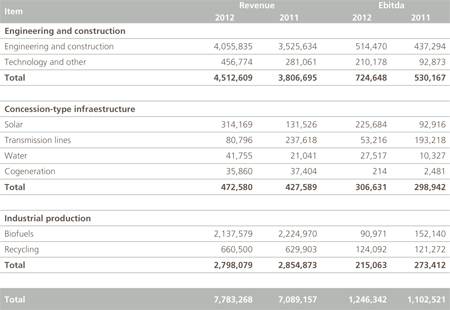
The reconciliation of segment EBITDA with the profit attributable to owners of the parent is as follows:

b) The long term asset and liabilities by Segment at the end of 2012 and 2011 are as follows:
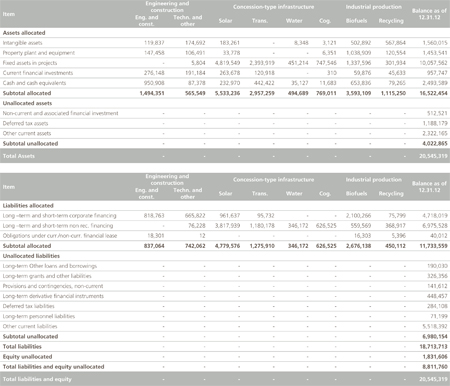
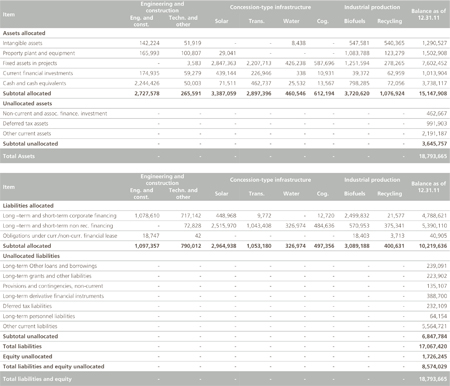
The criteria used to obtain the assets and liabilities per segment, are described as follows:
- With the only objective of presenting liabilities by segment, Corporate Financing signed by Abengoa, S.A. and Abengoa Finance, S.A. has been allocated by segments (see Note 20), since its main purpose is to finance investments in projects and in companies needed to expand businesses and lines of activity of the group.
c) Net Debt by segment as of December 31, 2012 and 2011 is as follows:
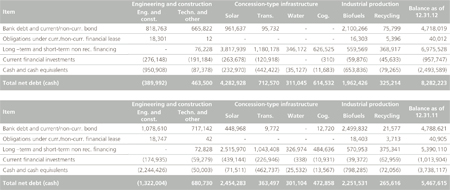
In order to obtain Corporate Net Debt, by segment:
- With the only objective of presenting liabilities by segment, Corporate Financing signed by Abengoa, S.A. and Abengoa Finance, S.A. has been allocated by operating segment (see Note 20), since its main purpose is to finance investments in projects and in companies needed to expand the businesses and lines of activity of the group.
- Short-term financial investments and Cash an cash equivalents are presented reducing debt, since both items are considered highly liquid.
d) The investment in property, plant and equipment and intangible assets by segments at the end of 2012 and 2011 is as follows:
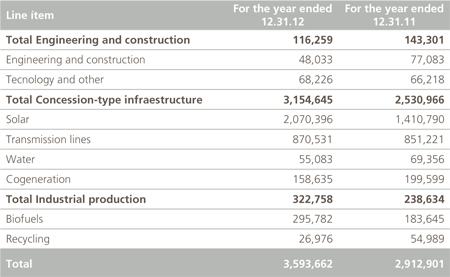
5.2. Information by geographic areas
a) The revenue distribution by geographical region for the years ended December 31, 2012 and 2011 is as follows:

b) The net book value of Property, plant and equipment by geographical region as of December 31, 2012 and 2011 is as follows:
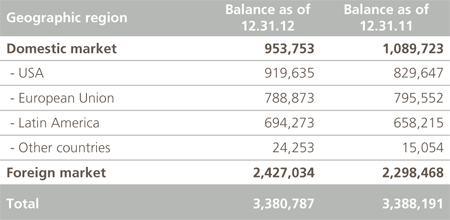
c) The net book value of Intangible assets by geographic region as of December 31, 2012 and 2011 is as follows:
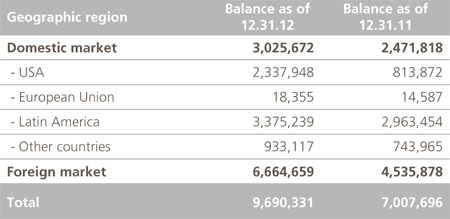
- Engineering and construction; includes our traditional engineering activities in the energy and water sectors, with more than 70 years of experience in the market as well as the development of solar technology.
-
Note 6.- Changes in the composition of the group
6.1. Changes in the consolidation group
a) In 2012 a total of 81 subsidiaries (26 in 2011), 3 associates (1 in 2011) and 9 joint ventures (3 in 2011), were included in the consolidation group, which are identified in Appendices I, II, III, XII, XIII and XIV of these Consolidated Financial Statements.
These changes did not have a significant impact on the overall consolidated amounts in 2012 and 2011.
In addition, during 2012, 14 Temporary joint ventures (UTE) (39 in 2011) have commenced their activity or have started to undertake a significant level of activity and were included in the consolidation group. These UTE contributed €90,637 thousand (€160,429 thousand in 2011) to the consolidated net sales.
The amounts set out below represent the Group's proportional interest in the assets, liabilities, revenues and profits of the joint ventures (not fully owned by the Group) which have been included in the Consolidated Financial Statements in 2012 and 2011:
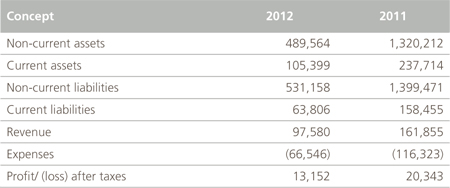
On the other hand, the amounts set out below represent the Group's proportional interest in the assets, liabilities, revenues and profits of the UTE which have been included in the Consolidated Financial Statements in 2012 and 2011:
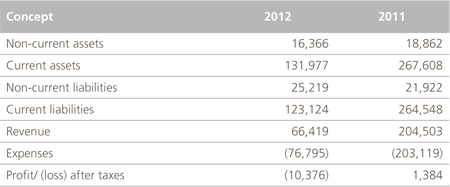
Funds provided by Group companies to the only UTE excluded from the consolidation group (3 in 2011) is nil (€2 thousand in 2011) and are recorded under “Financial Investments” in the Consolidated Statement of Financial Position. Revenues of recorded UTE excluded from the consolidation accounted for 0.00% of the Group’s consolidated revenues (0.02% in 2011). Net income corresponding to those UTE is nil in 2012 and 2011. b) In 2012 a total of 46 subsidiaries were no longer included in the consolidation group (84 in 2011), 5 associates (2 in 2011) and 7 joint ventures (3 in 2011), which are identified in Appendix IV, V and VI and which did not have any material impact in the Consolidated Income Statement, except for disposals mentioned in Note 6.2b).
During 2012, 33 UTE (147 in 2011) were excluded from the consolidated group because they had ceased their activities or had become insignificant in relation to overall group activity levels. The proportional consolidated revenues of these UTE in 2012 were €271 thousand (€26,294 thousand in 2011).
c) During 2012, Rioglass group, which was consolidated proportionally until December 31, 2011, started to be fully consolidated due to the business combination conducted in this period (see Note 6.3).
During 2011, no companies changed the method of consolidation due to a change in its shares with the exception of the Brazilian transmission line companies which were consolidated globally until November 30, 2011 and proportionally after the sale of the first portion and until the sale of the second portion on March 16, 2012 (see Note 6.2.b).
6.2. Main acquisitions and disposals
a) Acquisitions
- There were no significant acquisitions during the year 2012.
- On March 17, 2011, the Board of Directors of Proyectos de Inversiones Medioambientales, S.L. (the bidding company), a subsidiary of Abengoa, S.A., agreed to formulate a public tender offer to acquire the shares in Befesa Medio Ambiente, S.A. (Befesa), in order to delist Befesa’s shares from the Spanish official secondary markets on which it was listed, in accordance with Article 34.5 and subsequent articles of the Securities Market Act and Article 10 and subsequent articles of Royal Decree 1066/2007 and other applicable legislation.
On April 25, 2011, the General Shareholders' Meeting of Befesa approved the resolution to delist the shares representing the share capital of the Affected Company from stock markets and the subsequent public tender offer for the shares. The offer was to acquire 710,502 Befesa shares, which represent 2.62% of its share capital at 23.78 Euros per share.
On August 24, 2011 the Governing Body of the Bilbao Stock Exchange reported the delisting of the shares of Befesa Medioambiente, S.A. from trading, effective August 25, 2011, upon the forced sale of shares by Proyectos de Inversiones Medioambientales, S.L.. As of the date of issuance of these financial statements Befesa’s shares have been delisted from trading due to the successful tender offer process. - On November 2, 2011, Abengoa reached an agreement with Qualitas Venture Capital (QVC) to acquire its 38% stake in the aluminum recycling business for €34 M, which resulted in a final 98.25% ownership by Abengoa in the aluminum recycling company on November 24, 2011, date on which approval was obtained from the competent authorities. In 2007 Abengoa and QVC integrated their respective aluminum waste recycling activities in the Abengoa division responsible for this business. The transaction gave Abengoa a 60.25% stake in the company.
b) Disposals
- On March 16, 2012, the Company reached an agreement with Compañía Energética Minas Gerais (CEMIG) to sell the 50% stake that Abengoa S.A. still owned in four transmission line concessions in Brazil (STE, ATE, ATE II and ATE III). On July 2, we received €354 M of cash proceeds corresponding to the total price agreed for the shares. The gain from this sale has amounted to €4 M and is recorded in “Other operating income” in the Consolidated Income Statements.
- On September 5, 2011, Abengoa, S.A. closed an agreement with Schneider Electric, S.A. for the sale of 40% of its shares in Telvent GIT, S.A. The sale of said shares brought in cash proceeds of €391 M and a net profit from discontinued operations, including gain, of €91 M, reflected in the section “Profit (loss) from discontinued operations, net of tax” of the Consolidated Income Statement. For more information on the sale of the shares of Telvent GIT, S.A. (see Note 7).
- In addition, on November 30, 2011, Abengoa, S.A. closed an agreement with Compañía Energética Minas Gerais (CEMIG) through Transmissora Aliança de Energía Eléctrica, S.A. (TAESA) for the sale of 50% shares in the companies STE, ATE, ATE II and ATE III, and 100% in NTE. The sale of said shares generated cash proceeds of €479 M and a gain of €45 M reflected in the section “Other Operating Income” in the Consolidated Income Statement (€43 M after tax). Of the €45 M gain, € 10.6 M is attributable to recognizing the investment retained at fair value at the date when control is lost, according to IAS 27, and the remaining € 34.4 M correspond to the profit obtained in the sale.
6.3. Business combinations
Rioglass Group was incorporated in 2006 as a joint venture between Abengoa and its former shareholders. The group manufactures and sells parabolic trough mirrors for thermo-solar plants, thanks to an exclusive technology developed internally which is specially remarkable due to specific techniques for manufacturing mirrors with tempered glass, very accurate automatic techniques for bending and mirroring and high reflectivity.
Since the incorporation of Rioglass Group, thermo-solar energy has experienced a very high development worldwide. Global installed capacity has reached 1.560 MW in operation, mainly in Spain and the United States. Recently, we can appreciate a significant international expansion in other geographies, with plants in construction in the Middle East, Africa and India and with ambitious plans to develop new thermo-solar plants in several countries such as South Africa, Australia, China, India, Saudi Arabia and Chile.
As of January 16, 2012, Abengoa Solar, S.A. closed an agreement with Rioglass Laminar, S.L. to acquire an additional share of Rioglass Holding, S.A. With this acquisition and once the conditions for the closing were fulfilled, Abengoa Solar, S.A. became the majority shareholder of Rioglass Holding, S.L. and obtained control of the management of the group, a business which is key in its strategy of international expansion. As a result, Rioglass group, which was integrated proportionally, started to be fully consolidated.
Since the business combination was achieved in stages, according to IFRS 3, the Company has remeasured its previously held equity interest in the acquiree at its acquisition-date fair value, which has consisted basically in the value of committed sales from Rioglass Group for the use of technology and mirrors, linked to relations and contracts existing with clients in the construction of thermo-solar plants in Spain, the United States, South Africa, Mexico and India. This valuation has represented a gain of € 85,247 thousand.
The difference between the fair value of the stake acquired in Rioglass group and the fair value of the identifiable assets and liabilities acquired, amounting to € 38,919 thousand, has been recorded as Goodwill.
Additionally, according to IFRS 3, Directors are in process of evaluation of the identifiable assets and liabilities acquired in order to perform the purchase price allocation, considering all identifiable fixed and intangible assets, liabilities and contingent liabilities to the extent they are subject to recognition according to IFRS. Among the assets identified, the higher values have been assigned to technology and customer relationships.
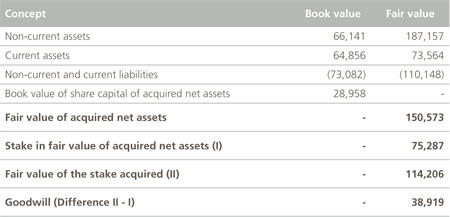
In 2011 no significant business combinations were carried out by the Group.
-
Note 7.- Discontinued operations
On June 1, 2011, our 40% owned subsidiary ,Telvent GIT, S.A., entered into an acquisition agreement with Schneider Electric S.A., (“SE”), under which SE launched a tender offer to acquire all Telvent shares. Concurrently with the signing of the acquisition agreement between SE and Telvent, Abengoa entered into an irrevocable undertaking agreement with SE under which we agreed to tender our 40% shareholding in Telvent into the tender.
SE launched the tender offer to acquire all Telvent shares at a price of $40 per share in cash, which represented a company value of €1,360 M, and a premium of 36% to Telvent’s average share price over the previous 90 days prior to the announcement of the offer.
The transaction was closed in September 2011, following completion of the usual closing conditions and once all of the regulatory authorizations had been obtained. The sale generated cash proceeds of €391 M and a total gain from discontinued operations of €91 M for Abengoa, reflected under the heading of “Profit (loss) from discontinued operations, net of tax” in the income statement for the twelve months ending in December 2011.
Taking into account the significance of the activities carried out by Telvent GIT, S.A. to Abengoa, the sale of this shareholding was considered as a discontinued operation in accordance with the stipulations and requirements of IFRS 5, Non-Current Assets Held for Sale and Discontinued Operations, and therefore included under a single heading in the consolidated income statement for the twelve month period ending December 31, 2011.
Below is the Income Statement of Telvent GIT up to the date of sale, and a detail of the heading “Profit for the year from discontinued operations” of the Consolidated Income Statement for the year 2011:
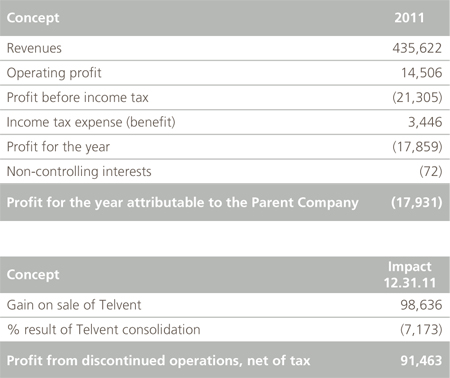
-
Note 8.- Intangible assets
8.1.
The following table sets out the movement of intangible assets in 2012 broken down into those generated internally and other intangible assets:
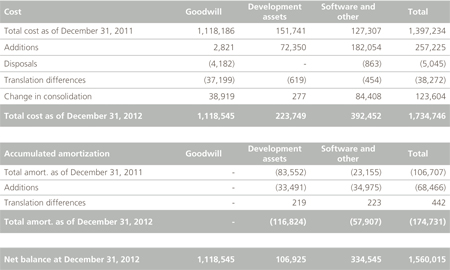
Goodwill has remained stable: the increase arising from the business combination of the Rioglass group, by €38,919 thousand, has been offset by the negative effect of translation differences, arising mainly from the depreciation of the Brazilian real with respect to the Euro. Additionally, the business combination of Rioglass has caused that intangible assets identified in the purchase price allocation were recorded at fair value and fully consolidated, in accordance with IFRS 3, which explains the increase in the rest of the intangible assets (see Note 6.3), together with the progress in the construction of several thermo-solar plants in Spain (€172M) and investment effort in research and development projects (see Note 8.3).
During 2012 no significant losses for impairment of intangible assets were recorded.
8.2.
The following table sets out the movement of intangible assets in 2011 broken down into those generated internally and other intangible assets:
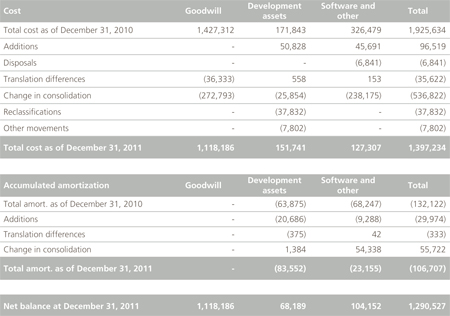
The decrease in the cost of intangible assets is mainly due to the sale of Telvent GIT, S.A. (see note 7) and to translation differences mainly caused by the depreciation of the Brazilian Real against the Euro.
During 2011 no significant losses for impairment of intangible assets were deemed necessary.
8.3. Development assets
During 2012, Abengoa made significant Research, Development and Innovation (R&D&i) investment efforts, investing a total of €91,260 thousand (€90,630 thousand in 2011) through the development of new technologies in different areas of business (solar technology, biotechnology, desalination, water treatment and reuse, recycling, hydrogen, energy storage and new renewable energies).
The following table summarizes the total investments made in R&D&i in 2012 and 2011:
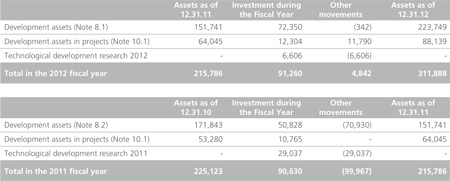
The year 2012 has been essential to consolidate Abengoa Research in the commitment of the Company for the technological development and innovation. Abengoa Research works, included within Abengoa activities of energy and environment consists in research to generate knowledge, consultancy in complex technical problems and long-term technological development. In order to strengthen this activity, in 2012 the Office of patents and technological surveillance has been created, as a fundamental tool for industrial property protection of the Company. Currently, Abengoa has 78 patents registered and 125 patents under request process.
The strategic technologies of the company also experienced an important progress: the main development asset stem from technologies intered for higher performance of concentrated solar power plants (CSP), for biorefineries, for the treatment of municipal solid wastes (MSW) for energy production, and for water treatment plants.
Most relevant R&D projects carried out during the year 2012 have been, in the thermo-solar technology field, Solugas project, which is a demonstration tower plant with hybrid solar-gas technology. Its construction was finalized in May and it has been in operation since then. In addition, investments have been made to improve direct steam generation plants and in new materials for energy accumulation. In the biofuels segment, we can outline the construction of a pilot plant that produces bioetanol using municipal solid wastes (MSW) as raw material. In this plant, different types of MSW will be tested, in order to adapt technology to different geographies. Additionally, the construction of a pilot plant for the production of biobutanol has been started. This new technology has the advantage that it can use assets and equipment already existing in Abengoa, with no need of additional capital expenditures. Regarding zinc recycling business, investments were made to develop a new technology that permits to recover the zinc which is retained in the slag within the recycling process, improving the product recovery ratio. In the desalination program, we have continued improving efficiency, especially by reducing costs of membranes which are necessary for the reverse osmosis process.
8.4. Goodwill
The table below shows the breakdown of Goodwill as of December 31, 2012 and 2011:
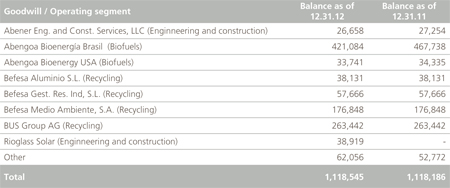
Based on the values in use calculated in accordance with the assumptions and hypothesis described in Notes 2.8 and 3, in 2012 and 2011 the recoverable amount of the cash generating units to which goodwill was assigned is higher than their carrying amount.
For each goodwill, sensitivity analysis have been performed, especially in relation to discount rates, terminal values and changes in the main business key variables, to ensure that potential changes in valuation do not make cash generating units fair value lower than its book value.
8.5.
There are no intangible assets with indefinite useful life other than goodwill. There are no intangible assets with restricted ownerships or that may be under pledge as liabilities guarantee.
-
Note 9.- Property, plant and equipment
9.1.
The table below shows the movement on the different categories of Property, plant and equipment (PP&E) for 2012:
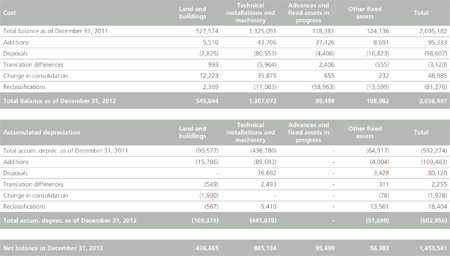
Property, plant and equipment cost has decreased in December 31, 2012 when compared to December 31, 2011 due to the dismantling of Rontealde (Vizcaya) desulfuration plant and to the reclassification from “PP&E” to “Intangible assets in projects” of the fixed assets related with the Mojave solar plant in the United States, once the construction of the plant has started after obtaining the project financing. This effect has been partially offset by the recognition of the Rioglass Group’s business combination described in Note 6.3, which has resulted in the consolidation of 100% of the identifiable fixed assets of the group and its valuation at fair value in compliance with IFRS 3.
During 2012, no significant losses from impairment of PP&E were recorded.
9.2.
The table below shows the movement on the different categories of Property, plant and equipment (PP&E) for 2011:
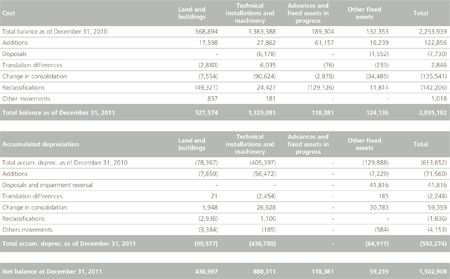
The total decrease in the cost of fixed assets is mainly due to changes in the consolidation which occurred after the sale of the shares of Telvent GIT, S.A. (see Note 7) and to the reclassification of €123 M from “PP&E” to “Intangible fixed asset in projects” of the fixed assets related with the solar plant in the USA (Solana) upon obtaining the Federal Guarantee-backed non-recourse financing for US$1,450 M upon the completion of the previously established conditions.
The decrease in the accumulated depreciation is mainly due to the reversal of an impairment for €42 M recognized in past fiscal years on the lands acquired in the US in connection with the Mojave Solar Projects. Such impairment was reversed during the year 2011 as the US government, through its Department of Energy (DOE), granted Abengoa Solar a Conditional Commitment to issue a Federal Guarantee for US$1,202 M in relation to said project upon completing a series of previously established conditions. Since the obtention of the conditional commitment represented an important milestone in the closing of the project financing and the development of the Mojave project within the agreements signed with the utility company, Management considered that the reasons considered to record the impairment had disappeared.
During 2011, no significant losses from impairment of PP&E were deemed necessary.
9.3.
Property, plant and equipment not assigned to operating activities at the year-end is not significant.
9.4.
The companies’ policy is to contract all insurance policies deemed necessary to ensure that all Property, plant and equipment is covered against possible risks that might affect it.
9.5.
The amount of capitalized interest costs included in PP&E at December 31, 2012 was €2,051 thousand (€1,669 thousand in 2011).
9.6.
At the end of 2012 and 2011, Property, Plant and Equipment include the following amounts where the group is a lessee under a finance lease:

9.7.
The cost of lands included in the lands and building subcategory amounted to €94,907 thousand at December 31, 2012 (€93,878 thousand in 2011).
9.8.
The table below sets out the information related to those assets constructed by the Group during 2012 and 2011 classified under the heading Property, plant and equipment of the Consolidated Statement of Financial Position):

-
Note 10.- Fixed assets in projects (project finance)
As indicated in Note 2.5 included in the Group are several companies which engage in the development of projects including the design, construction, financing, operation and maintenance of owned assets or assets under concession-type agreements which are financed through non-recourse financing.
This note provides a breakdown of the property, plant and equipment and intangible fixed assets within such companies. Nonrecourse financing details related to such companies are disclosed in Note 19 of these Notes to the Consolidated Financial Statements.
10.1. Intangible assets in projects.
a) The following table shows the movements of intangible assets included in the heading “Fixed Assets in Projects” for 2012:

During 2012 concession assets have increased due to Concession projects in process, mainly solar-thermal power plants in Spain (€615 M), thermo-solar plants in the United States (€1,167 M), Kaxu y Khi thermo-solar plants in South Africa (€100 M), as well as the cogeneration plant in Mexico (€97 M) and transmission lines in Brazil and Peru (€860 M). This increase and the reclassification from “PP&E” to “Intangible assets in projects” of the fixed assets related with the Mojave thermo-solar in the USA, (see Note 9.1), have been partially offset by the sale of transmission lines in Brazil further described in Note 6.2 and by the net negative effect of translation differences.
No significant losses from impairment of “Intangible assets in projects” were recorded during 2012.
b) The following table shows the movements of intangible assets included in the heading “Fixed Assets in Projects” for 2011:
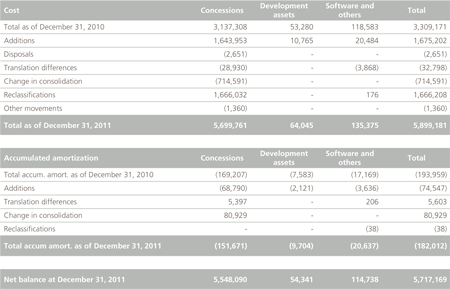
The increase in the cost of concession-type assets is mainly due to the progress in the construction of infrastructure concession assets, mainly the Solana thermosolar Solar plant in the US (€475 M), the Cogeneration plant in Mexico (€164 M) and various transmission lines in Brazil and Peru (€696 M). In addition, as the Company began to apply IFRIC 12 to its thermosolar plants in Spain starting September 1, 2011, the carrying amount of such assets of €1,644 M was transferred from “PP&E in projects” to “Intangible assets in projects”.
On the other hand, intangible assets in projects decreased mainly due to the changes that occurred in the consolidation after the sale of the shares the Brazilian transmission lines (see Note 6.2.b) and due to the movement of the exchange rate differences after the depreciation of the Brazilian Real and the appreciation of the US Dollar against the Euro.
During 2011, no significant losses from impairment of “Intangible assets in projects” were deemed necessary.
c) Capitalized interest cost for the year ended December 31, 2012 amounts to €172,854 thousand (€156,185 thousand in 2011).
d) There are no intangible assets with indefinite useful lives. There are no intangible assets restricted for use or pledged as security for liabilities.
e) Appendix VII to these Consolidated Financial Statements includes certain information on project companies included within the scope of IFRIC 12.
10.2. Property, plant and equipment in projects
a) The table below shows a breakdown of the movement in “Property, plant and equipment assets in projects” for 2012:
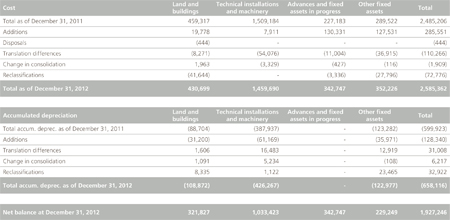
Fixed assets in progress increased primarily due to the construction of the second generation bioenergy plant in Kansas, United States, that will generate ethanol from biomass. The increase in “Other fixed assets” corresponds primarily to increased biological assets in the bioenergy business in Brazil. On the other hand, there was a decrease in Property, plant and equipment due to the negative effect of the depreciation of the Brazilian Real and the US Dollar with respect to the Euro.
During 2012, no significant losses from impairment of PP&E in projects were recorded.
b) The table below shows a breakdown of the movement in “Property, plant and equipment assets in projects” for 2011:

The decrease in the total cost of the tangible assets is mainly due to the reclassification of the thermosolar plants in Spain amounting € -1,644 M from tangible fixed assets to intangible fixed assets derived from the application of IFRIC 12 to such plants , as well as for the movement of the exchange rate differences after the depreciation of the Brazilian Real and the appreciation of the US Dollar against the Euro.
In addition, there was an increase in assets amounting to €105 M following the start of the construction of the first commercial plant for biofuel from biomass, after Federal Guarantee was granted by the US Department of Energy (DOE) for its financing.
During 2011, no significant losses from impairment of PP&E in projects were deemed necessary.
c) Borrowing costs capitalized for the years ended December 31, 2012 and 2011 amounted to €19,484 thousand, €5,881 thousand.
d) The fixed assets in projects have no mortgage warranty additional to the ones assigned to its non-recourse financing (see Note 19).
e) It is the policy of the Group to enter into a number of insurance policies to cover risks relating to property, plant and equipment.
f) In cases of property plant and equipment over third party land, the company has estimated the dismantling costs of affected items, as well as the rehabilitation costs of the place where they are settled. See Note 22.1.
10.3. Assets constructed by group
The table below sets out the information related to those assets constructed by the Group during 2012 and 2011 classified under the heading fixed assets in projects of the Consolidated Statement of Financial Position (intangible assets and property plant and equipment):

-
Note 11.- Investments in associates
11.1.
The table below shows the breakdown and the movement of the investments held in associates for 2012 and 2011:
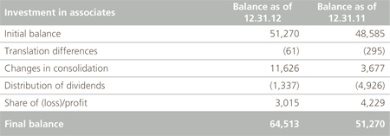
11.2.
The tables below shows a breakdown of assets, revenues and operating profit as well as other information of interest for the years 2012 and 2011 of the associated companies:

-
Note 12.- Financial instruments by category
The Group’s financial instruments are primarily deposits, trade and other receivables, derivatives and loans. Financial instruments by category (current and non-current), reconciled with the Statement of Financial Position, are as follows:

The information on the financial instruments measured at fair value, is presented in accordance with the following level classification:
- Level 1: Quoted prices in active markets for identical assets or liabilities.
- Level 2: Measured on inputs other than quoted prices included within Level 1 that are observable for the asset or liability, either directly (i.e. as prices) or indirectly (i.e. derived from prices).
- Level 3: Measured on inputs for the asset or liability that are not based on observable market data (unobservable inputs).
The following is a breakdown of the Group’s assets and liabilities measured at fair value at December 31, 2012 and 2011 (except assets and liabilities with a carrying amount close to their fair value, non-quoted equity instruments measured at cost and contracts with components that cannot be measured reliably):
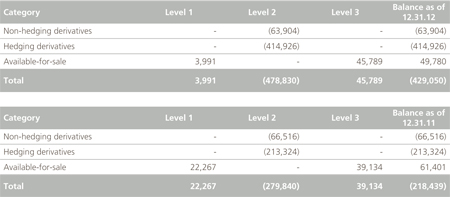
The following table shows the changes in the fair value of level 3 assets for the years ended December 31, 2012 and 2011:
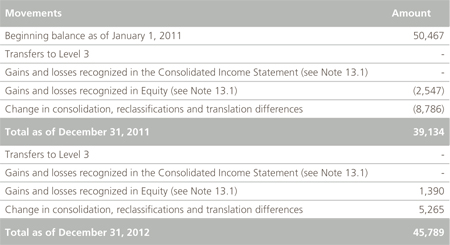
-
Note 13.- Available-for-sale financial assets
13.1.
The following table shows the detail and the movement on available-for-sale financial assets during 2012 and 2011:

13.2.
The following table shows those entities which, in accordance with the then current legislation, were not consolidated in the years 2012 and 2011 and in which the parent company’s direct and indirect shareholding is higher than 5% and lower than 20%. The net carrying amount of these holdings is €8,626 thousand at December 31, 2012 (€7,986 thousand in 2011).
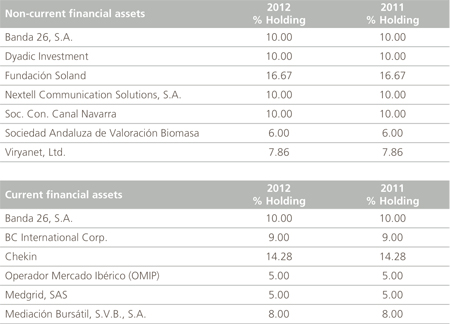
13.3.
All necessary notifications have been made to the companies in which the Group holds an interest of over 10%, as required under Article 155 of the Capital Societies Law (Ley de Sociedades de Capital).
13.4.
There are no circumstances which have a material impact on the financial assets on the Group’s portfolio, such as litigations, pledges, etc.
13.5.
There are no firm agreements in place regarding the sale or purchase of these investments which could be considered material in relation to the Group’s Financial Statements.
13.6.
The amount of interest accrued but not yet collected is not material.
13.7.
There are no fixed-yield securities in arrears. The average rate of return on fixed-yield securities is in line with the market.
13.8.
As of December 31, 2012 and 2011, Abengoa, S.A. held a 3% interest in Yoigo, S.A, a Spanish telecom operator, recorded at a cost of €32,997 thousand and held in the Group through the ownership of Siema Investments, S.L. (a holding company owned 100% by Abengoa, S.A.). Additionally the shareholders of Yoigo have granted this company several “participative” loans in accordance with a pre-established plan, which involved a total disbursement of €21,030 thousand in 2011 (as of December 31, 2012 y 2011), equivalent to 3% of the total loan made to the company by its shareholders in said years.
To value this holding, as in prior periods, once Yoigo’s activities had commenced, the principal reference point taken is the company’s future cash-flow generation on the basis of its current Business Plan, discounted at a rate appropriate to the sector in which this company operates.
As a result of the purchase of its holding in Yoigo, Siema Investment, S.L. became responsible, for furnishing guarantees to the Spanish Administration as security for compliance with the commitments relating to investment, commercialization, employment and network development acquired by Yoigo, together with other guarantees relating to the Radioelectronic Spectrum Rate, which the Group is required to counter-guarantee, for a total amount of €12,085 thousand (€12,085 thousand in 2011).
13.9.
The Group applies IAS 39 to determine whether the carrying amount of an available-for-sale financial asset has been impaired. This process requires significant judgment. To make this judgment, the Group assesses, among other factors, for how long and to what extent the fair value of an investment will be below its cost, considering the financial health and short-term prospects of the company issuing the securities, including factors such as the industry and sector return, changes in the technology and cash flows from operating and financing activities.
-
Note 14.- Derivative financial instruments
14.1.
The fair value of derivative financial instruments as of December 31, 2012 and 2011 is as follows:
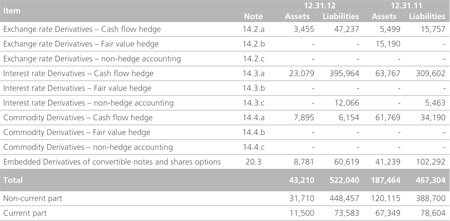
Derivatives classified as non-hedge accounting are those derivative financial instruments which, although obtained for the purpose of hedging certain market risks (interest rates, exchange rates and commodity prices), do not meet the specific requirements established by IAS 39 to be designated as hedging instruments from an accounting point of view (since, at the inception of the hedge, there was no designation or formal documentation relating to the hedge or the risk management strategy that it was intended to implement) or, having complied with all of the requirements to be designated a hedging instrument, the underlying has been sold or the hedging designation has been interrupted.
Fair value of derivative assets decreased during 2012 due to the decrease in fair value of call options on Abengoa own shares that were signed to hedge the convertible notes, mainly due to a decrease in the stock price of the shares of Abengoa, which is a principal factor in the evaluation of the embedded derivatives and the options, and to the decrease in the fair value of commodity and interest rate derivatives.
On the other hand, fair value of derivative liabilities has increased due to the increase in negative interest rate derivatives, which was partially offset by the decrease in fair value of commodity and by the decrease in fair value of the derivative liabilities embedded in the convertible notes issued in 2009 and 2010, described in Note 20.3.
The fair value amount recognized in the Consolidated Income Statement of the 2012 and 2011 fiscal year for the financial instruments derivatives designated as hedging instruments is a loss of €96,172 thousand (loss of €7,578 thousand in 2011).
Included in the following sections are detailed fair value presentations of each of the categories of derivative financial instruments presented in the table above. The net position of assets and liabilities for each line item of the summary table above reconciles with the net amount of the fair values of collections and payments for exchange rate derivatives, the net amount of the fair values of caps and swaps for interest rates hedges and the net amount of the fair values of commodity price derivatives, respectively.
14.2. Exchange rate hedges
The terms “Collection hedges” and “Payment hedges” refer to foreign currency derivates designated as hedging instruments of future cash inflows and outflows associated to highly probable forecasted sales and purchase, respectively, denominated in a foreign currency.
The following table shows a breakdown of the notional amounts of the financial instruments relating to amounts receivable and payable in foreign currencies as of December 31, 2012 and 2011.
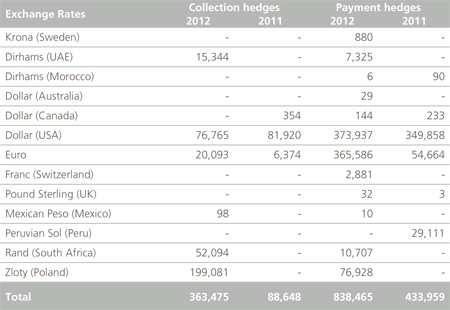
The following table shows a breakdown of the fair values of exchange rate derivatives relating to amounts receivable and payable in foreign currencies as of December 31, 2012 and 2011:
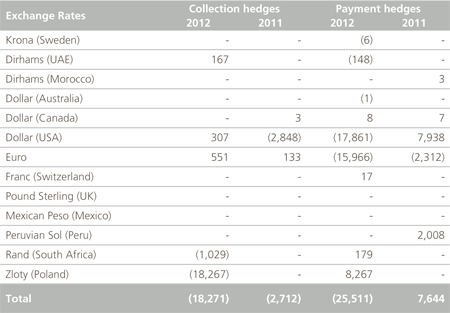
a) Cash flow hedges
The table below shows a breakdown of the maturities of notional amounts of exchange rate derivatives designated as cash flow hedges at the end of 2012 and 2011:

The table below shows a breakdown of the maturities of fair value amounts of exchange rate derivatives designated as cash flow hedges at the end of 2012 and 2011 year end:

The net amount of the fair value of exchange rate derivatives designated as cash flow hedges transferred to the Consolidated Income Statement in 2012 and 2011 has been of €1,033 thousand and €-1,163 thousand, respectively (see Note 18.3).
The ineffective amount recognized in the Consolidated Income Statement for the years 2012 and 2011 with respect to exchange rate derivatives designated as cash flow hedges amounts to €-17,193 thousand and €2,225 thousand, respectively.
The after-tax gains/losses accumulated in equity in connection with exchange rate derivatives designated as cash flow hedges at December 31, 2012 amounted to €-17,395 thousand (€45,708 thousand in 2011). See note 18.3.
b) Fair value hedges
The group does not have any exchange rate derivatives designated as fair value hedges at the end of 2012.
The table below shows a detail of the maturities of notional amounts of exchange rate derivatives designated as fair value hedges as at the end of 2011:
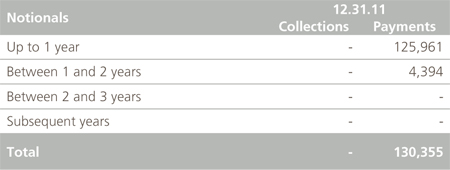
The table below shows a detail of the maturities of fair value amounts of exchange rate derivatives designated as fair value hedges at the end of 2011
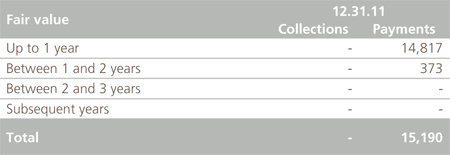
The net amount of the fair value of exchange rate derivatives designated as fair value hedges transferred to the Consolidated Income statement in 2011 has been of €7,561 thousand (see Note 30.2).
c) Non-hedge accounting derivatives
At the end of 2012 and 2011 the Group does not hold any exchange rate non-hedge accounting derivatives instruments.
The net amount of the fair value of exchange rate derivatives charged directly to the Consolidated Income Statement as a result of not meeting all the requirements of IAS 39 to be designated as hedges represented an impact of €-19,947 thousand (see Note 30.2).
14.3. Interest rate hedges
As stated in Note 4 to these Consolidated Financial Statements, the general hedging policy for interest rates is to purchase call options in exchange of a premium to fix the maximum interest rate cost. Additionally, under certain circumstances, the company also uses floating to fixed interest rate swaps.
As a result, the notional amounts hedged, strikes contracted and maturities, depending on the characteristics of the debt on which the interest rate risk is being hedged, can be diverse:
- Corporate Financing: we hedge between 66% and 100% of the notional amount, with maturities up to 2021 and average guaranteed interest rates of between 1.05% and 4.75% for loans referenced to the 1-month and 3-month Euribor rates.
- Non-recourse financing;
- Non-recourse financing in Euros: we hedge between 75% and 100% of the notional amount, maturities until 2032 and average guaranteed interest rates of between 2.00 % and 5.25%.
- Non-recourse financing in US Dollars: we hedge between 80% and 100% of the notional amount, including maturities until 2028 and average guaranteed interest rates of between 0.35% and 5%.
a) Cash flow hedges
The table below shows a breakdown of the maturities of notional amounts of interest rate derivatives designated as cash flow hedges at the 2012 and 2011 year end:

The table below shows a breakdown of the maturity of the fair values of interest rate derivatives designated as cash flow hedges at the 2012 and 2011 year end:

The net amount of the fair value of interest rate derivatives designated as cash flow hedges transferred to the Consolidated Income Statement in 2012 and 2011 has been of €-75,664 thousand and €-49,775 thousand, respectively (see Note 18.3).
The after-tax gains/losses accumulated in equity in connection with derivatives designated as cash flow hedges at the end of 2012 and 2011 amount to €-273,966 thousand and €-254,028 thousand, respectively (see Note 18.3).
The net amount of the time value component of the cash flow derivatives fair value recognized in the Consolidated Income Statement for the years 2012 and 2011 has been €-24,221 thousand and €-64,324 thousand, respectively.
b) Fair value hedges
The Group does not have any interest rate derivatives designated as fair value hedges at the end of 2012 and 2011.
c) Non-hedges accounting derivatives
The table below shows a detail of the maturities of notional amounts of interest rate derivatives that not meet the requirements to be designed as hedging instruments at the end of 2012 and 2011:

The table below shows a detail of the maturities of fair values of non-hedge accounting interest rate derivatives at the end of 2012 and 2011:

At the end of 2012 and 2011, the net amount of the fair value of interest rate derivatives charged directly to the Consolidated Income Statement as a result of not meeting all the requirements of IAS 39 to be designated as hedges represented an impact of €-4,305 thousand and €2,104 thousand, respectively (see Note 30.1).
Additionally, a series of interest rate swaps and caps were settled in 2008, generating a positive cash flow upon liquidation. These contracts had been designated as cash flow hedge as a result of the respective effectiveness tests performed. Therefore, applying IAS 39, when the hedging instrument no longer exists and the hedged transaction continues to be probable, the cumulative gain or loss on the hedging instrument that remains recognized in equity from the period when the hedge was effective should remain in equity until the forecasted transaction occurs. This amount will be reclassified to profit or loss in the same period or periods in which the hedged forecasted transaction affects profit or loss. In the present case, it will be reclassified to profit or loss as the finance expense originated by the loan hedged is recognized in the Consolidated Income Statement. As a result, Abengoa will reclassify the profit recognized in equity to the Consolidated Income Statement following the swaplet method, where each interest rate calculation period of the swap is called a swaplet. The basis of this method is that the amount recognized in equity will be equivalent to the sum of the present value of the cash flows of each swaplet (i.e. the difference between the fixed rate and the forward rate calculated for each swaplet at the last date on which the hedge was effective, discounted to the date when hedge accounting was discontinued).
The balance calculated for each swaplet is recognized in the Consolidated Income Statement in the period of each swaplet. The amounts transferred from equity to the Consolidated Income Statement in 2012 and 2011 were a gain of €7,695 thousand and €10,095 thousand, respectively, with an amount of €1,032 thousand (€8,727 thousand in 2011) yet to be transferred to the Consolidated Income Statement in the following years.
14.4. Commodity price hedges
In relation to hedges of commodity prices, as stated in Note 2.10 of the Consolidated Financial Statements of Abengoa for the year ended on December 31, 2012, the different activities carried on by Abengoa through its different segments (Biofuels, Recycling and Engineering and construction) expose the group to risks derived from the fair value of certain commodity prices (zinc, aluminum, grain, ethanol and gas).
To hedge these risks, Abengoa uses derivative contracts and OTC derivatives for commodity prices.
a) Cash flow hedges
The table below shows a breakdown of the maturities of notional amounts for the commodity price derivatives designated as cash flow hedges at the 2012 and 2011 year end:

The table below shows a breakdown of the maturities of the fair value of commodity price derivatives designated as cash flow hedges at the 2012 and 2011 year end:
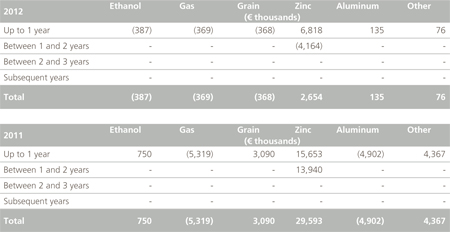
The net amount of the fair value of commodity price derivatives designated as cash flow hedges transferred to the Income statement in 2012 and 2011 has been of €-21,541 thousand and €58,516 thousand, respectively (see Note 18.3).
The after-tax gains/losses accumulated in equity in connection with derivatives designated as cash flow hedges at December 31, 2012 amounted to €8,761 thousand (€28,286 thousand in 2011), see Note 18.3.
b) Non-hedge accounting derivatives
At the end of 2012 and 2011, the Group does not hold non-hedge accounting derivative financial instruments of commodity prices.
The net amount of the fair value of commodity prices derivatives charged directly to the Consolidated Income Statement as a result of not meeting all the requirements of IAS 39 to be designed as hedges represented an impact of €-19,991 thousand (see Note 30.3).
-
Note 15.- Clients and other receivable accounts
15.1.
The breakdown of Clients and Other Receivable Accounts as of December 31, 2012 and 2011 is as follows:
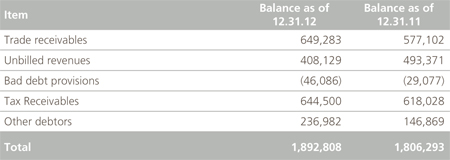
As a general rule, "Unbilled revenues" are billed within the three months following completion of the work being performed on the project. Nevertheless, given the highly-tailored characteristics of some construction contracts, some projects may take longer to be billed due to specific billing milestones in the contracts. The total outstanding balances as of December 31, 2012 and 2011 are supported by contracts signed with such customers and do not include any receivables relating to customer claims.
At the end of 2012 and the 2011 there were no balances with related parties (see Note 33.2).
15.2.
The fair value of Clients and other receivable accounts does not differ significantly from its carrying value.
15.3.
The list of Clients and Other Accounts Receivable according to foreign currency as at December 31, 2012 and 2011 are as follows:
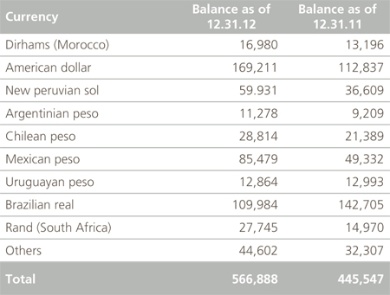
15.4.
The following table shows the maturity detail of trade receivables as of December 31, 2012 and 2011:

15.5.
The credit quality of outstanding Trade receivables, that are neither past due nor impaired, may be assessed under the following categories:

15.6.
The movement in the bad debt provision for 2012 and 2011 is the following:
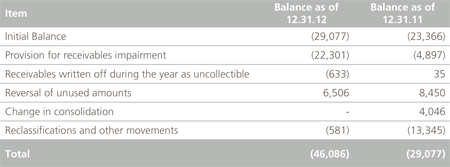
The most significant variations for the year 2012 are due to the recognition of doubtful trade receivables mainly related to water infrastructure projects as well as other minor engineering and construction projects.
The most significant variations for the year 2011 are mainly due to changes in the consolidation which occurred after the sale of the shares of Telvent GIT, S.A.
15.7.
The Company maintains a number of non-recourse factoring lines of credit. The Company enters into these factoring agreements with certain financial institution by selling the Company’s credit rights in certain commercial contracts. The factoring agreements are entered into on a non-recourse basis, meaning that the financial institutions undertake the credit risk associated with the Company’s customers. The Company is responsible for the existence and legitimacy of the credit rights being sold to the financial institutions. Credit rights from recurring customers or with terms of up to one year are supported by annual revolving factoring lines of credit. Credit rights from non-recurring customers or with terms longer than a year are supported with global transfer agreements commencing on the date when the underlying commercial contract comes into force and expiring when the contracted works are completed.
At the end of the 2012 financial year, approximately 360 M€ (346 M€ in 2011) were factored and derecognized pursuant to the provisions of IAS39. Additionally there were 196 M€ (nil in 2011) related to the construction agreement of a 640 MW electricity plant in Mexico, which has been assigned to a financial institution. The value of this contract will be settled directly by the customer to the financial institution at the provisional reception of the plant. As a result, Abengoa is effectively being paid according to completion of milestones of the construction works, which is customary practice in EPC contracts.
The finance cost in the 2012 fiscal year derived from factoring operations amounted to €44 M (€20 M in 2011).
15.8.
The breakdown of Tax receivables as of December 31, 2012 and 2011 is as follows:

15.9.
The following table shows a breakdown of financial accounts receivable as of December 31, 2012 and 2011:
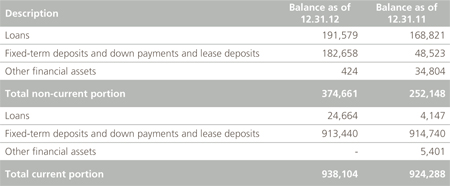
This heading includes the loans and other accounts receivable considered as non-derivative financial assets not listed in an active market, with a maturity period of less than twelve months (current assets) or exceeding that period (non-current assets).
The market value of these assets does not differ significantly from their carrying amount.
As of December 31, 2012 the amount corresponding to entities with non-recourse financing is €477 M (€890 M in 2011).
Loans for an amount of €216 M in 2012 (€173 M in 2011), mainly includes note receivables with third parties and local administrations for a total amount of €145 M (€93 M in 2011), and includes certain loans to group companies associates and other related parties, not eliminated in consolidation for a total amount of €44 M (€46 M in 2011).
Fixed-term and deposits for an amount of €1,096 M (€963 M in 2011) includes primarily restricted investments in fixedincome securities and bank deposits. Under this heading there are reserve accounts for debt servicing in the amount of €102 M (€42 M in 2011) in current asset (see Note 19.2) and €20 M (€33 M in 2011) in non-current asset. Fixed-term investments and deposits are invested in financial entities with a high credit quality as stated in Note 4.
Other financial assets include other receivable amounts considered as non-derivative financial assets not listed in an active market, which are not classified in any of the other categories.
-
Note 16.- Inventories
16.1.
Inventories as of December 31, 2012 and 2011 were as follows:
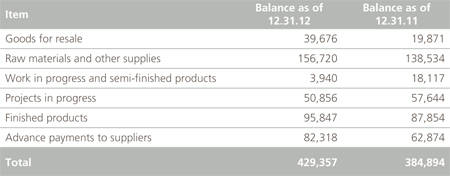
Inventories for entities located outside Spain were €409,692 thousand (€233,034 thousand in 2011).
16.2.
There are no restrictions on the availability of inventories, with the exception of guarantees provided for construction projects in the normal course of business, which are released as the contractual milestones of the project are achieved.
-
Note 17.- Cash and cash equivalents
The following table sets out the detail of Cash and cash equivalents at December 31, 2012 and 2011:
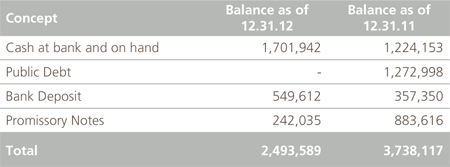
The following breakdown shows the main currencies in which cash and cash equivalent balances are denominated:
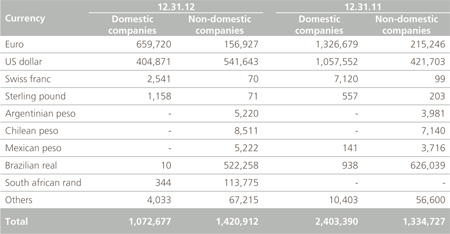
The balance of cash and cash equivalents of entities with non-recourse financing (see Note 19) was €851,287 thousand (€654,547 thousand in 2011).
-
Note 18.- Shareholders’ equity
18.1. Share capital
As of December 31, 2012 the share capital amounts to €90,143,938.83 represented by two distinct classes of 538,062,690 shares completely subscribed and disbursed:
- 85,619,507 class A shares with a nominal value of 1 Euro each, all in the same class and series, each of which grants the holder a total of 100 voting rights and which are the class A shares of the Company (“Class A Shares”).
- 452,443,183 class B shares with a nominal value of 0.01 Euros each, all in the same class and series, each of which grants One (1) voting right (“Class B Shares” and, together with class A shares, “Shares with Voting Rights”).
On September 30, 2012, the General Shareholders’ Meeting approved a capital increase of 430,450,152 class B shares with a nominal value of €0.01per share, charged to our freely available reserves, which have been distributed for no consideration to all existing shareholders on the basis of four class B shares for each class A share or class B share which they hold (“the Capital increase”). Therefore, no dilution or further concentration with respect to our share capital occurred.
The General Shareholders’ Meeting approved a right of voluntary conversion for the class A shareholders to convert their class A shares with a nominal value of 1 Euro into class B shares with a nominal value of 0.01 Euros during pre-set windows until December 31, 2017. Following the exercise of this right, after each conversion window, .a capital reduction has taken place and will take place, by reducing the par value of a number of class A shares to be determinated by 0.99 euros per share, by creating a non-available reserve.
Since the approval by the General Shareholder’s Meeting of the afore-mentioned conversion right of class A shares into class B shares, four capital conversions have taken place after four conversion windows periods; the last one has finalized on January 15, 2013.
After such capital conversions the share capital as of January 22, 2013 after the end of the fourth conversion period amounts to €89,513,059.35 represented by two distinct classes of 538,062,690 shares completely subscribed and disbursed: 84,982,255 class A shares and 453,080,435 class B shares.
Abengoa´s shares are represented by book entries. Class A and B shares are listed on the Madrid and Barcelona Stock Exchange and on the Spanish Stock Exchange Electronic Trading System (Electronic Market). Class A shares have been listed since November 29, 1996 and class B shares since October 25, 2012. The Company presents mandatory financial information on a quarterly and semiannual basis.
In the context of the such Capital increase, Inversión Corporativa IC, S.A. (“Inversión”) has undertaken not to sell ("lockup") Abengoa shares for a period of six months from the date on which the Extraordinary General Shareholders' Meeting was held. Additionally, Inversión has undertaken to (i) limit its right to vote to the 55.93% of total voting rights and (ii) that the percentage of voting shares held by Inversión (whether they are class A shares or class B ordinary shares) over the total shares of the Company shall at no time be lower than one fourth of the percentage of voting rights that those shares provide to Inversión, with respect to the total voting rights in the Company, meaning that its voting rights may not exceed four times its economic rights. Should that threshold be exceeded, Inversión will transfer class A ordinary shares, or convert class A shares into class B shares, in such number as may be necessary to maintain such proportion.
In accordance with notifications received by the company and in compliance with reporting requirements to communicate shareholding percentages and the information received from relevant parties, shareholders with a significant holding as of December 31, 2012 are as follows:

On November 4, 2011, Abengoa, S.A. closed an investment transaction with First Reserve Corporation (FRC), a US Investment Fund specialized in Private Capital and Investments within the energy sector, by virtue of which it invested €300 million in Abengoa’s stock capital, through the issuance of 17,142,858 new class B shares at a nominal value of €0.01 per share, at a nominal price plus a premium of €17.50 per share.
At the same time, Abengoa issued 4,020,124 warrants of class B shares, at an exercise price of €0.01, which are transmissible, and which shall afford FRC the right to subscribe a class B share from Abengoa for each warrant and to receive a cash sum equivalent to the dividend per share and other distributions, for a period of 5 years. As a consequence of the distribution of class B shares approved by the Extraordinary General Meeting held on September 30, 2012, FRC received 16,080,496 warrants of class B shares, at an exercise price of €0.01.
The General Shareholders’ meeting held on April 1, 2012 approved a dividend of €0.07 per share, which totals €37,664 thousand, compared to €18,094 thousand in the previous year. On April 11, a first payment of €0.03 per share was made and on July 4, 2012 the remaining €0.04 per share was paid.
18.2. Parent company reserves
The following table shows the amounts and movements of the Parent Company Reserves in 2012 and 2011:
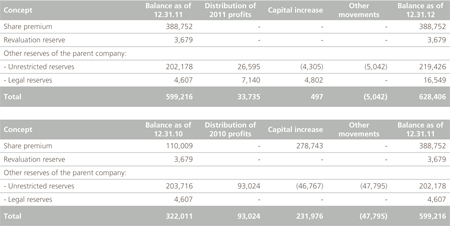
The amount corresponding to “Other movements” for 2012 and 2011 is mainly part of operations carried out with treasury shares.
The Legal Reserve is created in accordance with Article 274 of the Capital Companies Act, which states that in all cases an amount of at least 10% of the earnings for the period will be allocated to this reserve until at least 20% of the share capital is achieved and maintained. The Legal Reserve may not be distributed and, if used to compensate losses in the event that there are no other reserves available to do so, it should be replenished from future profits.
On November 19, 2007, the company entered into a liquidity agreement on class A shares with Santander Investment Bolsa, S.V. Replacing this liquidity agreement, on January 8, 2013, the company entered into a liquidity agreement on class A shares with Santander Investment Bolsa, S.V. in compliance with the conditions set forth in CNMV Circular 3/2007 of December 19. On November 8, 2012, the company entered into a liquidity agreement on class B shares with Santander Investment Bolsa, S.V. in compliance with the conditions set forth in CNMV Circular 3/2007 of December 19.
As of December 31, 2012 treasury stock amounted to 14,681,667 shares (2,913,435 shares in 2011), which 2,939,135 are class A shares and 11,742,532 are class B shares.
Regarding the operations carried out during the year, the number of treasury stock purchased amounted to 8,201,391 class A shares and 15,458,056 class B shares and treasury stock transferred amounted to 8,175,691 class A shares and 3,715,524 class B shares, with a net result of €-961 thousand recognized in equity (€-2,144 thousand in 2011).
The proposed distribution of 2012 profits of the Parent Company:
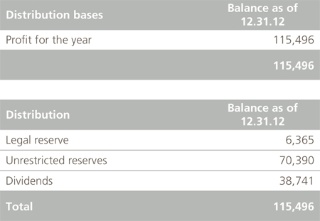
The proposed distribution of 2012 profits involves the payment of €0.073 per share in 2013. The Company paid a dividend of €0.070 per share in 2012.
18.3. Other reserves
Other reserves include the impact of the valuation of derivative instruments and available for sale investments at the end of the year.
The following table shows the balances and movements of Other reserves by item for 2012 and 2011:
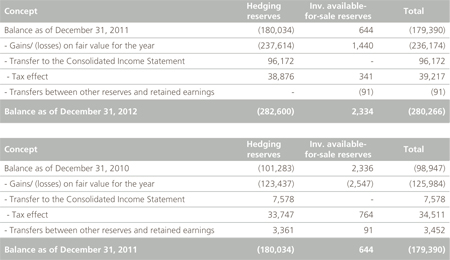
For further information on hedging activities, see Note 14.
18.4. Accumulated currency translation differences
The amount of accumulated currency translation differences for fully and proportionally consolidated companies and associates at the end of 2012 and 2011 is as follows:

The decrease in the accumulated currency translation differences is mainly due to the depreciation of the Brazilian Real and US Dollar against the Euro.
18.5. Retained earnings
The breakdown and movement of Retained earnings during the 2012 and 20011 fiscal years are as follows:
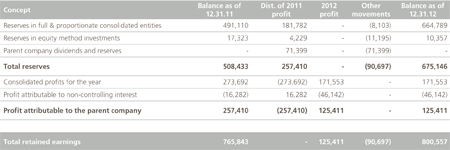
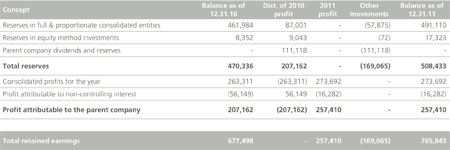
Amounts included under “Other movements” mainly refer to the acquisition of various non-controlling interests , the effects of which is recorded in net equity as required by the revised IFRS 3.
The Reserves in full and proportionate consolidated entities and equity method investments are as follows:

-
Note 19.- Non-recourse financing (project financing)
As indicated in Note 2.2, there are certain entities within the Group for which, in general, the main commercial purpose is the longterm development of integrated products which are financed through non-recourse project finance. This note outlines the nonrecourse financing linked to the assets included in Note 10 of these Consolidated Financial Statements.
Non-recourse financing is generally used for constructing and/or acquiring an asset, exclusively using as guarantee the assets and cash flows of the company or group of companies carrying out the activities financed. In most of the cases, the assets and/or contracts are set up as guarantee to ensure the repayment of the related financing.
Compared to corporate financing, non-recourse financing has certain key advantages, including a greater leverage period permitted and a clearly defined risk profile.
19.1.
The balances and movements for 2012 and 2011 of non-recourse financing are set out in the table below:

During 2012 the increase in non-recourse financing was mainly due to drawnings in relation to new solar projects amounting to €1,262 M, especially for the solar projects in the United States, for which €955 M were drawn. In addition, €468 M were drawn in relation with transmission lines and €48 M in relation to the co-generation project in Tabasco, Mexico. On the other hand, non-recourse financing decreased due to the sale of transmission lines in Brazil (€-210 M decrease) and due to translation differences (€-225 M decrease) mainly caused by the depreciation of Brazilian real with respect to the euro.

The increase occurred in 2011 was mainly due to new financing obtained for the development of new projects in connection with the solar activity for €1,046 M (€439 M for a thermosolar project in the US and €607 M for thermosolar projects in Spain), to the transmission line activities (Brazil) for €232 M, to the cogeneration activities for €147 M and to the zinc recycling activities for €300 M.
A decrease also occurred mainly due to the financing of the Brazilian Lines companies in the proportional part of the percentage sold for €-249 M (see Note 6.2.b), to the cancellation of the debt previously owned by Befesa Zinc, S.A. with the new financing obtained as indicated above (€-185 M) and to the effect of the exchange rate differences brought about by the depreciation of the Brazilian Real and the appreciation of the US Dollar against the Euro (€-13 M).
19.2.
Within the assets on the Consolidated Statement of Financial Position and under the Cash and Cash equivalent and Financial Receivables (Current) headings, there are debt service reserve accounts in the amount of €100 M relating to project finance in 2011 (€42 M in 2011).
19.3.
Appendix IX of this consolidated report details the Project companies as of the end of 2012 which are financed by Nonrecourse project finance.
19.4.
The repayment schedule for Non-recourse project financing, at the end of 2012 is as follows and is consistent the projected cash flows of the related projects.

Included within the amounts repayable there are balances relating to operations financed through non-recourse bridge loans (see Note 19.6) which will be repaid upon granting long-term non-recourse project financing.
19.5.
Non-recourse financing projects entered into in 2012 and 2011 (in Millions of Euros) is as follows:
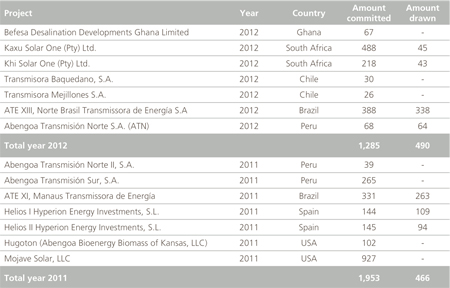
19.6.
Non-recourse project finance applied to projects also includes Non-Recourse Finance in Process. This relates to certain operations which are financed in a similar manner to non-recourse projects, generally by financial entities, and which are earmarked to be future development projects which typically will eventually be financed through non- recourse project finance. Receiving finance in process is in effect similar to receiving traditional customer prepayments during various early phases of construction of a project; Non-recourse finance in process varies slightly from traditional prepayments, however, in that it is not received from customers but from a financial entity. Such funding typically relates to transitional financing phases of a project (typically periods of less than 2-3 years) during the launch and construction phase of goods/projects which once completed and ready for operation become financed under the non-recourse project finance model (See Note 2.5).
However, if during the transitory period there is a risk of non-compliance with the debt repayment schedule necessary for the formalization of Project Finance (or of construction, which will ultimately require financing), this would be reclassified to elsewhere on the Consolidated Statement of Financial Position, depending upon the nature of the arrangement, typically being Loans with financial entities.
The table below lists projects with non-recourse financing in progress as of December 31, 2012 (amount in thousands of euros):
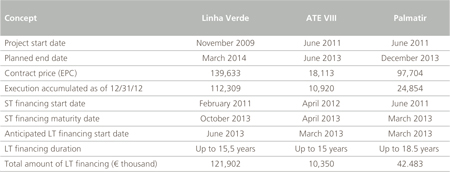
19.7.
Current and non-current loans with credit entities include amounts in foreign currencies for the total of €4,278,013 thousand (€2,913,128 thousand in 2011).
The equivalent in euros of the most significant foreign-currency-denominated debts held by the Group is as follows:
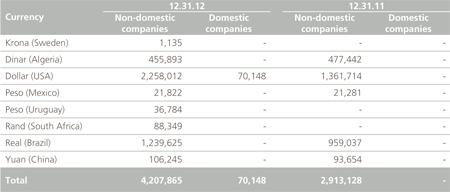
-
Note 20.- Corporate financing
20.1.
The breakdown of the corporate financing as of December 31, 2012 and 2011 is as follows:
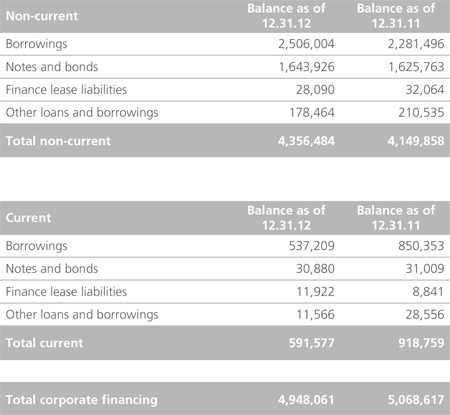
20.2.
Credit facilities with financial entities
a) The amount of current and non-current credit facilities with financial entities as of December 31, 2012 includes debts denominated in foreign currencies in the amount of €260,301 thousand.
The most significant value of exchange for currencies of debts in foreign currencies owed by companies of the Group to financial entities is as follows:

b) The following table shows a list of credit facilities with financial entities:

With the aim of minimizing the volatility in interest rates of financial operations, specific contracts are signed to hedge the possible variations that may occur (See Note 14).
The long-term syndicated financing loans are raised for the purposes of financing investments and general financing requirements of Abengoa, S.A. and all the companies of the group without non-recourse financing.
On April 27, 2012, the Company signed the refinancing and syndication of €1,566,210 thousand of its long term corporate debt. The refinancing was led by a group of national and international entities, which acted as arrangers and bookrunners for the transaction. On May 22, 2012 and according to the option included in the contract, the principal amount was increased by €47,000 thousand and on July 11, 2012 it was additionally increased by €50,000 thousand, so the refinancing amounts to 1,663,210 thousand as of December 31, 2012. The refinancing was supported by 37 international financial institutions.
The new Forward Start Facility is divided in two tranches: Tranche A amounting € 1,350,723 thousand and Tranche B, amounting to € 312,487 thousand. Part of tranches A and B were drawn for the purpose of repaying and extinguishing certain syndicated credit facilities agreements borrowed in 2005 and 2006 as well as making a partial repayment under the 2010 Forward Start Facility, in each case on July 20, 2012. In addition, certain amounts under the 2012 Forward Start Facility will be utilized, along with other funds, to repay and extinguish the 2010 Forward Start Facility in July 2013. The new Forward Start Facility can only be drawn with the purpose of repaying the 2010 Forward Start Facility on its repayment dates. As of December 31, 2012, borrowings under the 2012 Forward Start Facility amounted to €551 M.
The Company also has amounts outstanding under a forward start facility agreement maturing in 2013 dated April 22, 2010 borrowed by Abengoa and jointly and severally guaranteed on a senior basis by certain companies of the Group (the “2010 Forward Start Facility”). On April 27, 2012, the Company signed the 2012 Forward Start Facility described above which made available to us certain tranches by which we can make partial repayments under the 2010 Forward Start Facility, which has had the effect of extending the maturity of our syndicated facilities. Our 2005 Credit Facility and 2006 Credit Facility were extinguished and a partial repayment under the 2010 Forward Start Facility was made on July 20, 2012, when we made a repayment of €556 M utilizing drawdowns under the 2012 Forward Start Facility and cash on hand. As of December 31, 2012, borrowings under the 2010 Forward Start Facility amounted to €1,278 M.
The table below shows the maturity of the corporate syndicated financing before and after this refinancing until the issuance of these financial statements:

Interest rate applicable to both tranches is Euribor plus a margin of 3.75% until January 20, 2013, 4.00% until January 2015 and 4.25% until July 2016.
In addition, the bilateral loans with the Official Credit Institute (ICO) and the European Investment Bank (EIB) are aimed at financing specific investment programs, more notably overseas programs, as well as R&D&i programs.
On July 11, 2012, the €150 M bilateral facilities loan with the Instituto de Crédito Oficial originally signed on July 18, 2007 was amended and restated. The bilateral facilities loan now matures on July 18, 2016, with annual repayments starting in 2014.
In addition, some subsidiaries of Abengoa S.A. undersigned long-term loans with various entities, including two financing agreements signed with a group of financing entities backed by an EKN (Swedish Export Credit Agency) guarantee to finance industrial machinery in various projects:
- A €247.7 M Swedish law credit facility maturing in 2020 dated March 2, 2010 borrowed by Instalaciones Inabensa S.A. (the “Swedish Credit Agreement”). On December 10, 2010, this loan was increased in the amount of €128.8 million. As of December 31, 2012, borrowings under this agreement amounted to €303 M.
- A €299.3 framework facility agreement dated August 11, 2010 as amended on October 19, 2010 and January 25, 2012 borrowed by Abener Energia, S.A. and jointly and severally guaranteed by Abengoa (the “Framework Facility Agreement”). Sixteen individual loan agreements have been borrowed under the Framework Facility Agreement amounting to €269.4 M maturing between 2018 and 2022. As of December 31, 2012, borrowings under this agreement amounted to €198 M.
To ensure that the Company has sufficient funds to repay the debt with respect to its capacity to generate cash flow, Abengoa has to comply with a Corporate Net Debt/EBITDA financial ratio with the financial institutions.
According to the financing agreements, the maximum limit of this ratio is 3.0 for the years 2012, 2013 and until December 30, 2014 and 2.5 starting December 31, 2014. As of December 31, 2012 and 2011, Corporate Net Debt/EBITDA financial ratio was 1.80 and 0.14 respectively, according to the conditions of the financing agreements.
c) As of December 31, 2012 the debt repayment calendar was as set out in the following table, which has been modified after the convertible notes issuance in January 2013, amounting to €400 M, and ordinary bonds issuance in February 2013, to €250 M (see Note 33.8 on Subsequent events).

The exposure of the Group to movements in interest rates and the dates at which prices are revised is specified in Note 4 on the management of financial risks. The fair value is based on discounted cash flows, applying a discount rate being that of the third-party loan.
d) The balance of interest payable is €17,890 thousand as of 2012 (€11,588 thousand in 2011) and is included under “Short-term borrowings”.
e) Real estate pledged against mortgages corporate financing as of December 31, 2012 is not significant.
f) The average interest rates associated with the debt facilities reflect normal levels in each of the regions and areas in which the facility was agreed upon.
g) The average cost of total financing during 2012 was 6.7%.
20.3. Notes and bonds
As described in Note 33.8 Subsequent events, in January 2013 the Company has issued €400 M convertible notes due 2019. Part of the proceeds obtained with the issuance of these convertible notes were used to partially repay €99.9 M of the convertible notes due 2014. The table below shows the maturities of the existing notes as of December 31, 2012 without considering the new issuance of 2013.

As described in Note 2.19.1 in Significant accounting policies, in accordance with IAS 32 and 39 and the Terms and Conditions of the issuance, since Abengoa has a contractual right to choose the type of settlement and one of these possibilities is paying through a variable number of shares and cash, the conversion option qualifies as an embedded derivative. Thus, the convertible bonds are considered a hybrid instrument, which includes a component of debt and an embedded derivative for the conversion option held by the bondholder.
Convertible notes 2014
On July 24, 2009, Abengoa, S.A. issued Convertible Notes, convertible into ordinary shares, to qualified investors and institutions in Europe for the amount of €200 M. The terms and conditions of the issuance are currently as follows:
a) The Notes were issued for two hundred million Euros (€200 M) with maturity set at five (5) years.
b) The Notes accrue a fixed annual interest of 6.875% payable semiannually.
c) The 2014 Convertible Notes are convertible into fully paid class A shares or class B shares of Abengoa, subject to certain liquidity conditions, credited in the number determined by dividing the aggregate nominal amount of the Notes by the applicable conversion price. The conversion price was initially set at €21.12 per ordinary share of Abengoa and was adjusted to €20.84 per share in July 2012 following a dividend payment (€0.35 per share) in excess of the dividend threshold permitted without adjustment in the conversion price (€0.21 per share). In October 2012, the conversion price was adjusted to €4.17 per share of Abengoa due to the distribution of class B shares as approved by the Extraordinary General Shareholders’ Meeting held on September 30, 2012.
d) Pursuant to the Terms and Conditions, in the event that investors decide to exercise their right of conversion, the Company may decide to settle the issuance entirely in shares, in cash or in a combination of shares and cash.
The carrying value amount of the liability component of this note at December 31, 2012 amounted to 178,720 thousand (€167,267 thousand at December 31, 2011).
Additionally, at December 31, 2012, the fair value of the derivative liability embedded in the convertible bond is €21,313 thousand, while its fair value as of December 31, 2011 amounted to €46,101 thousand. The decrease in fair value has been recorded as an income amounting to €24,788 thousand in “Other net finance income/expense” in the Consolidated Income Statement for the year ended December 31, 2012 (€4,360 thousand in 2011), see Note 30.3.
The key data for the valuation model were the share price, the estimated profitability of the dividend, an envisaged option maturity life, an interest rate and underlying volatility as set out in the table below:
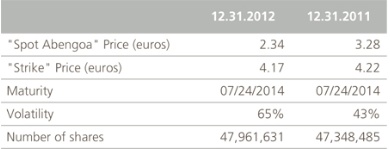
Furthermore, in order to partially hedge the derivatives embedded in the notes convertible, during the years 2011 and 2010 the Company purchased two call options over 7,000,000 Abengoa’s own shares with a strike price of €21.125 per share, maturing on July 24, 2014 (over 35,000,000 Abengoa’s shares with a strike price of €4.22 after the distribution of class B. shares approved by the Extraordinary General Meeting held on September 30, 2012).
These options hedge around 73% of the notes in the event of conversion.
The fair value of the options at December 31, 2011, calculated using the Black-Scholes model, was €20,034 thousand, while the fair value was €4,714 thousand at December 31, 2012. The decrease in fair value has been recorded as a finance expense amounting to €15,320 thousand recorded in “Other net finance income/expense” in the Consolidated Income Statement (€19,446 thousand in 2011), see Note 30.3.
The key data for the valuation model included the share price, the estimated profitability of the dividend, the envisaged life of maturity, an interest rate and underlying volatility as set forth in the table below:
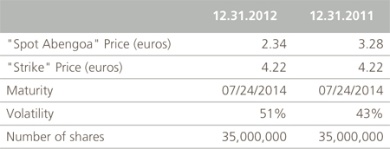
Convertible notes 2017
On February 3, 2010, Abengoa, S.A. issued Convertible Notes, convertible into ordinary shares, to qualified investors and institutions for the amount of €250 M. The terms and conditions of the issuance are currently as follows:
a) The Notes were issued for two hundred million Euros (€250 M) with maturity set at five (7) years.
b) The Notes accrue a fixed annual interest of 4.5% payable semiannually.
c) The 2017 Convertible Notes are convertible into fully paid class A shares or class B shares of Abengoa, subject to certain liquidity conditions, credited in the number determined by dividing the aggregate nominal amount of the Notes by the applicable conversion price. The conversion price was initially set at €30.27 per ordinary share of Abengoa and was adjusted to €29.87 per share in July 2012 following a dividend payment (€0.35 per share) in excess of the dividend threshold permitted without adjustment in the conversion price (€0.21 per share). In October 2012, the conversion price was adjusted to €5.97 per share of Abengoa due to the distribution of class B shares as approved by the Extraordinary General Shareholders’ Meeting held on September 30, 2012.
d) Pursuant to the Terms and Conditions, in the event that investors decide to exercise their right of conversion, the Company may decide to settle the issuance entirely in shares, in cash or in a combination of shares and cash.
The carrying value amount of the liability component of this bond at December 31, 2012 amounted to 191,516 thousand (€180,894 thousand at December 31, 2011).
Additionally, at December 31, 2012, the fair value of the derivative liability embedded in the convertible bond is €39,306 thousand, while its fair value as of December 31, 2011 amounted to €56,191 thousand. The decrease in fair value has been recorded as an income amounting to €16,885 thousand in “Other net finance income/expense” in the Consolidated Income Statement for the year ended December 31, 2012 (€3,194 thousand in 2011), see Note 30.3.
The key data for the valuation model included the share price, the estimated profitability of the dividend, an envisaged option maturity life, an interest rate and underlying volatility as set forth in the table below:
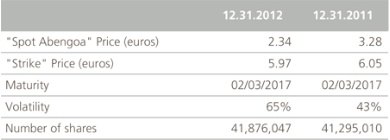
Furthermore, in order to partially hedge the derivatives embedded in the notes convertible, during the years 2011 and 2010 the Company purchased two call options over 7,100,000 Abengoa’s own shares with a strike price of €30.27 per share, maturing on February 3, 2017 (over 35,500,000 Abengoa’s own shares with a strike price of €6.05 after the distribution of class B shares approved by the Extraordinary General Meeting held on September 30, 2012).
These options hedge around 85% of the notes in the event of conversion.
The fair value of the options at December 31, 2011, calculated using the Black-Scholes model, was €21,204 thousand, while the fair value was €4,065 thousand at December 31, 2012. The decrease in fair value has been recorded as a finance expense amounting to €17,139 thousand recorded in “Other net finance income/expense” in the Consolidated Income Statement (€17,812 thousand in 2011), see Note 30.3.
The key data for the valuation model included the share price, the estimated profitability of the dividend an envisaged option maturity life, an interest rate and underlying volatility as set forth in the table below:
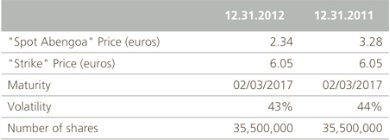
Ordinary notes Abengoa 2015
On December 1, 2009, Abengoa S.A. issued ordinary Notes for the amount of €300 M. In summary, the final terms and conditions of the issuance are as follows:
a) The Notes were issued for three hundred million Euros (€300 M) with maturity set at five (5) years.
b) These Notes will accrue a fixed annual interest of 9.625% payable semiannually.
c) These Notes are jointly guaranteed by some subsidiaries of the group.
Ordinary notes Abengoa 2016
On March 31, 2010, Abengoa S.A. issued ordinary Notes to qualified investors and institutions in Europe for the amount of €500 M. In summary, the final terms and conditions of the issuance are as follows:
a) The Notes were issued for five hundred million Euros (€500 M) with maturity set at six (6) years.
b) The fixed annual payable twice-yearly interest on the Notes is 8.50% annually.
c) The notes are guaranteed jointly by certain subsidiaries of the group.
Ordinary notes Abengoa 2017
On October 19, 2010, Abengoa Finance, S.A. Unipersonal, a subsidiary of Abengoa, S.A., placed an ordinary bond issue for USD 650 M among qualified and institutional investors in accordance with Rule 144A of the Securities Act of 1933 and subsequent amendments thereto.
In summary, the terms and conditions of the issue that were established definitively are:
a) The bond issue is for an amount of six hundred and fifty million United States dollars (USD 650 M) and matures at seven (7) years.
b) The notes will accrue fixed annual interest of 8.875%, payable every six months.
c) The notes are jointly and severally guaranteed by Abengoa, S.A. and certain group subsidiaries.
20.4. Finance lease liabilities
Finance lease creditors as of the end of 2012 and 2011 were:
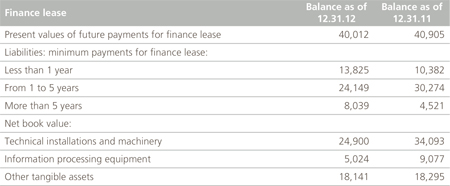
20.5. Other loans and borrowings
The following table sets out the movement of Other loans and borrowings at the 2012 and 2011 year end:

-
Note 21.- Grants and other liabilities
Grants and Other Liabilities as of December 31, 2012 and 2011 are shown in the following table:

-
Note 22.- Provisions and contingencies
22.1. Provisions for other liabilities and charge
The following table shows the movement of the non-current heading of “Provisions for other liabilities and charges” for the years 2012 and 2011:
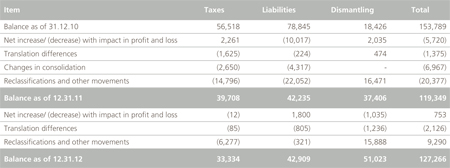
The only significant variation in 2012 has been the increase in the provision for dismantling costs, which is mainly related with the construction of thermo-solar plants. The dismantling provision is capitalized as a cost of the plant either during the construction period or when the plant enters into operation, depending on the nature of the obligations assumed in each case.
The most significant variations of 2011 are mainly related to the increase of €9 M for the purpose of covering adequately tax risks, liabilities and dismantling obligations and due to the reduction caused by the reversal of €15 M of provisions, set up during previous years since the reversal was considered advisable given its current classification as remote contingent liabilities or since the risk for which they were set up had materialized. In addition, €16 M has been recognized for dismantling, mainly related to solar segments.
In addition, €14.8 M have been reclassified from the Taxes provision to Other loans and borrowings once a payment schedule has been arranged and €17 M have been reclassified from Liabilities provision to long-term Personnel liabilities given that they correspond to long term compensation liabilities. These two movements have been included in the line “Reclassifications and other movements” because they did not have any impact in our consolidated income statement.
Finally, the line item “Reclassifications and other movements” in 2011includes a provision recorded for dismantling costs included in the carrying amount of fixed assets related to plants within the Solar operating segment for an amount of €15 M.
Provision for tax and legal contingencies
This provision represents the Group’s best estimates in connection with risks relating to tax contingencies arising during the normal course of the Group's business, fundamentally in Latin America, when it is considered probable that there will be an outflow of resources in the medium or long term (which has been estimated being comprised in a period between 2 to 5 years or over 5 years), although the development of the contingencies and the new facts and circumstances that may arise overtime could change such estimated settlement period.
There are also provisions recorded by Group companies in relation with court rulings and unfavorable tax inspections that are under appeal but have not been resolved yet. For these tax disputes the Group considers that it is probable that there will be an outflow of resources in the medium term (between 2 and 5 years).
Provision for liabilities
This provision includes the Group’s best estimates of probable cash outflows in connection with litigation, arbitration and claims in progress in which the various group companies are defendants as a result of the activities they carry out.
Management considers that these liabilities will likely be settled in the medium or long term (which has been estimated being comprised in a period between 2 to 5 years).
Dismantling provision
This provision is intended to cover future expenditures related to the dismantlement of the solar and environmental plants and those expenses deriving from the sealing and closing of waste safety deposits that are operated by several companies in the Industrial Production activity and it will be likely to be settled with an outflow of resources in the long term (over 5 years).
22.2. Contingent liabilities
As of December 31, 2012 Abengoa and its Group of companies are involved in certain claims and litigations both against and in their favor. Such matters arise during the Group’s normal course of business and represent the technical and economic claims that the contractual parties typically invoke.
We have briefly summarized below the most significant proceedings, which in the Management opinion are not expected to have a material adverse effect in the Consolidated Financial Statements, individually or as a whole, or for which the future outcome cannot be reliably estimated.
- In May 2000, Abengoa Puerto Rico S.E., a subsidiary of Abengoa S.A, brought a lawsuit against the Electricity Power Authority (Autoridad de Energía Eléctrica, “AEE”) of Puerto Rico and terminated the agreement that both parties had entered into in relation to an EPC project for the construction of an electricity power station in Puerto Rico, in which the AEE was the Principal Contractor. The referred lawsuit contained different claims such as, inter alia, withholding payments, default invoices, loss of future profits damages and several other costs, which tentatively amounted to US$ 40 M.
As a reaction to the lawsuit brought by Abengoa Puerto Rico, S.E., the AEE brought a counterclaim based on the agreement against Abengoa Puerto Rico, S.E. and, at the same time, brought an additional lawsuit for the same amount against Abengoa and its insurer, American International Insurance Co. of Puerto Rico. The amount claimed by the AEE is approximately US$450 M. - In May 2011Abengoa, S.A. initiated an arbitration procedure before the CIADI arbitration court in Washington, D.C. against the Mexican State for an alleged breach of the international treaty between Mexico and Spain for the reciprocal protection of investments. The arbitration procedure is in its early stages and concerns the nonrenewal of a license for an industrial waste landfill plant in Mexico. This claim provisionally amounts to $50.5 M plus interest.
- On February 15, 2010, our subsidiary, Centro Tecnológico Palmas Altas, S.A. (“CTPA”) filed a suit against Geco Alvicorp, S.L, claiming the non-existence of a termination clause in the purchase and sale agreement of certain plots in Huerta del Huracán, Spain entered into by the parties in 2007 and pursuant to which CTPA sold the plots for €46.7 million. Subsequently, Geco Alvicorp, S.L. claimed the existence of such a termination condition and has claimed the return of the purchase price plus interest. Both in first instance and in appeal proceedings, the courts ruled in CTPA’s favor. Geco Alvicorp, S.L. lodged appeal before the Supreme Court (Tribunal Supremo) that was not admitted. Against that resolution, Geco-Alvicorp has filed a complaint with the Supreme Court that is pending.
In February 2010, Centro Tecnológico Palmas Altas, S.A. initiated a lawsuit against Geco-Alvicorp S.L.
22.3. Contingent assets
As of December 31, 2012 Abengoa and its Group of companies have the following most significant contingent assets:
- On October 29, the Company received a favorable resolution from the International Court of Arbitration on the arbitration procedure between ASA Bioenergy Holding and Adriano Ometto, former owner of Abengoa Bioenergy Brazil, denying the appeal from Adriano Ometto and giving ASA Bioenergy Holding full recovery of the litigation expenses. In November 2011, the International Court of Arbitration had awarded Abengoa Bioenergy Brazil with 90% of the amount claimed, which amounts to U.S. $120 M plus interest and litigation costs. Procedures have been initiated for the execution of the arbitration resolution in Brazil. According with IAS 37 on contingent assets and based on the date on which confirmation was received, the Company has not recorded any amount in its Consolidated Income Statement.
- In May 2000, Abengoa Puerto Rico S.E., a subsidiary of Abengoa S.A, brought a lawsuit against the Electricity Power Authority (Autoridad de Energía Eléctrica, “AEE”) of Puerto Rico and terminated the agreement that both parties had entered into in relation to an EPC project for the construction of an electricity power station in Puerto Rico, in which the AEE was the Principal Contractor. The referred lawsuit contained different claims such as, inter alia, withholding payments, default invoices, loss of future profits damages and several other costs, which tentatively amounted to US$ 40 M.
-
Note 23.- Third-party guarantees and commitments
23.1. Third-party guarantees
At the close of 2012 the overall sum of Bank Bond and Surety Insurance directly deposited by the group companies and all that the parent company deposited to any company in the group as guarantee to third parties (clients, financial entities, Public Entities and other third parties) amounted to €1,541,255 thousand (€1,033,219 thousand in 2011) out of which €6,464 thousand (€136,910 thousand in 2011) are attributed to operations of financial nature and €1,534,791 thousand (€896,309 thousand in 2011) to those of technical nature.
In addition, the declarations of intent and commitments undertaken by the Group companies and what the parent company undertook to any company in the group as guarantee to third parties (clients, financial entities, Public Entities and other third parties) amounted to €4,428,780 thousand (€3,682,848 thousand in 2011) out of which €148,508 thousand (€167,620 thousand in 2011) are attributed to operations of financial nature and €4,280,272 thousand (€3,515,229 thousand in 2011) to those of technical nature.
23.2. Contractual obligations
The following table shows the breakdown of the third-party commitments and contractual obligations as of December 31, 2012 and 2011 (in thousands of Euros):
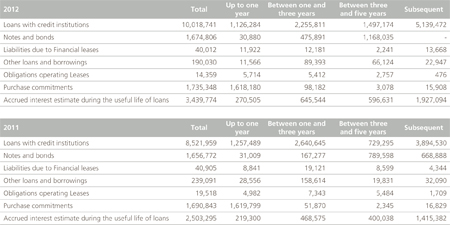
-
Note 24.- Tax situation
24.1 Application of rules and tax groups in 2012
Abengoa, S.A. and 258 and 283 consolidated subsidiaries in 2012 and 2011, respectively (see Appendixes XI and XVI of these Consolidated Financial Statements) will file its 2012 income taxes following the rules for tax consolidation in Spain under the “Special Regime for Tax Consolidation” Number 2/97.
Befesa Medioambiente, S.L.U and 12 other companies (see Appendix XI) will file its 2012 income taxes following the rules for tax consolidation in Vizcaya, with a group number 13/05/B.
During the year 2012, the tax Group under Vizcaya tax regulations has been modified:
Proyectos de Inversiones Medioambientales, S.L. (which in 2011 was the parent company of the tax consolidation group number 13/05/B, see Appendix XVI of these Consolidated Financial Statements) has been merged with Befesa Medio Ambiente, S.A. and the resulting company has been renamed Befesa Medio Ambiente, S.L.U. and is now the parent company of the tax group 13/05/B.
In addition, the former tax group 00109BSC existing in 2011 (see Appendix XVI) has been extinguished and all the companies which were part of this group are now consolidated from a tax point of view under the new group 13/05/B, with parent company Befesa Medio Ambiente, S.L.U.
The applicable law for the payment of corporate income tax in the Historic Territory of Biscay is Provincial Law 3/1996 of June 26 (taking into account subsequent amendments).
Management of the companies part of this tax group has calculated income tax expense for the year 2012 and for all the preceding years open to potential tax audits following tax regulations in force at the end of each years in this region.
All the other Spanish and foreign companies included in the Consolidation group file income taxes according to the tax regulations in force in each country on an individual basis or under consolidation tax regulations.
In order to calculate the taxable income of the consolidated tax Group and the consolidated entities individually, the accounting profit is adjusted for temporary and permanent differences, recording the corresponding deferred tax assets and liabilities. At each Consolidated Income Statement date, a current tax asset or liability is recorded, representing income taxes currently refundable or payable. Deferred income taxes reflect the net tax effects of temporary differences between the carrying amount of assets and liabilities for financial statement and income tax purposes, as determined under enacted tax laws and rates.
Income tax payable is the result of applying the applicable tax rate in force to each tax-paying entity, in accordance with the tax laws in force in the territory and/or country in which the entity is registered. Additionally, tax deductions and credits are available to certain entities, primarily relating to inter-company trades and tax treaties between various countries to prevent double taxation.
24.2. Deferred tax assets and liabilities
At the end of 2012 and 2011 the analysis of deferred tax assets and deferred tax liabilities is as follows:

Most of the tax credits for net operating loss carryforwards correspond to Brazil (€ 130 M), the United States (€43 M), Spain (€ 117M) and the Netherlands (€38M). Tax loss carryforwards in Brazil have been generated in years with poor meteorological conditions which have negatively affected sugarcane production. During 2011 and 2012 investments have been made to improve the quality of biological assets, to increase milling capacity and cogeneration plant capacity, with the ultimate purpose of increasing assets profitability. Tax loss carryforwards in the United States correspond mainly to projects in an initial stage of development or operation and to application of tax incentives. Tax loss carryforwards in Spain correspond mainly to the application of tax incentives.
Tax credits for deductions have been generated mainly in Spain. Among these tax credits the larger amount corresponds to deduction on export activities (DAEX), which is calculated as a percentage over investments effectively made for the acquisition of foreign companies or capital increases in foreign companies. This percentage, which was initially 25% was been gradually reduced since 2007 to reach 3% in 2010, disappearing the deduction on 2011. To benefit from this deduction, among other requirements, the acquisition or incorporation of companies should be directly related to the export of goods and services from Spain.
During the year 2012, the Company has not recorded any income in relation to this deduction, as it had been recorded entirely as of December 31, 2011.
In 2011, the Company recorded total income amounting to € 65M, part of which was classified as grants in “Other operating income”. In relation to the accounting treatment of the DAEX deduction, IAS 12 and IAS 20 (which covers the accounting treatment of government grants) exclude from their scope the accounting treatment of investment tax credits. IAS 20 indicates that a grant may exist in certain tax packages with certain characteristics of “investment tax credits” and recognizes that on occasions it is difficult to distinguish whether the underlying components of an economic transaction are government grants. In order to determine if the DAEX export tax is within the scope of IAS 12 or IAS 20, the Company analyzes each investment on a case-by-case basis. DAEX export tax deductions are considered government grants when the deduction is fundamental to the decision to make an investment in an asset and is recorded as “Other operating income- grants” in these cases (€ 50M were recorded under this heading in 2011). In all other cases the DAEX export tax deduction is considered to be part of the income tax (€ 15M were recorded under this heading in 2011).
In addition, efforts in research, development and innovation activities (R&D&i) that Abengoa has been carrying out during the last years have resulted in the generation of important tax deductions, some of which are recorded as deferred tax assets for an amount of €70 M as of December 31, 2012.
“Other deductions”, which have been generated mainly in Spain, correspond primarily to deductions for double taxation (€12M), environmental deductions (€12M), deduction for reinvestment of extraordinary benefits (€ 51M) and deductions for donations to non-profit organizations (€19M).
In relation to tax loss carryforwards and deductions pending to be used recorded as deferred tax assets, the Company evaluates its recoverability projecting forecasted taxable income for the upcoming years and taking into account the Company tax planning strategy. Deferred tax liabilities reversals are also considered in these projections, as well as any limitation established by tax regulations in force in each tax jurisdiction.
On the other hand, the Company has certain tax credits as of December 31, 2012 which it has not capitalized, as it determined that recoverability of such assets is not probable. These tax credits consist mainly of tax loss carryforwards related to our US subsidiaries amounting to €28,2 M (€21.6 M in 2011), with expiration dates between 2029 and 2031; and R&D&i and environmental tax credits in Spain amounting to €50,3 M (€57.9 M in 2011), with expiration dates between 2022 and 2030.
The movements in deferred tax assets and liabilities during 2012 and 2011 were as follows:
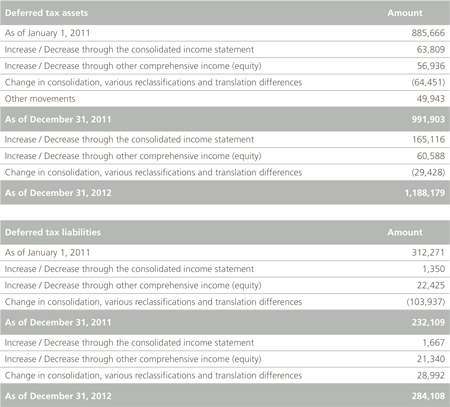
-
Note 25.- Trade payables and other current liabilities
25.1.
Trade payable and other current liabilities as of the close of 2012 and 2011 are shown in the following table:

25.2.
Nominal values of Trade payables and other current liabilities are considered to approximate fair values and the effect of discounting them is not significant.
25.3.
The table above includes amounts payable of €1,229 M at December 31, 2012 (€767 M in 2011) being “Confirming without recourse” relating to various agreements entered into with a number of financial entities in which the Group receives “confirming” services in connection with cash advances from trade receivables. There are linked deposits and cash and cash equivalents for an amount of €454 M (€439 M in 2011) over the abovementioned cash payments, classified under the “Financial accounts receivable” heading of the Consolidated Statement of Financial Position, as well as cash linked to such payments of suppliers through confirming in the amount of €486 M (€638 M in 2011) included under the heading “Cash and cash equivalents” of the asset of the Consolidated Statement of Financial Position.
25.4.
Details on supplier maturities are provided in the following table:
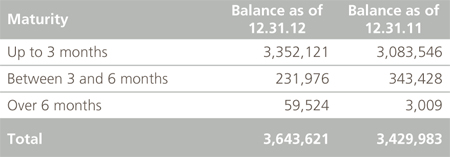
25.5.
Pursuant to the Decision dated December 29, 2010, of the Instituto de Contabilidad y Auditoría de Cuentas (Spanish Accounting Board), on the information to incorporate into the Financial Statements report in relation to the delays in payments to suppliers in commercial transactions, companies located in Spain that issue individual and consolidated statements must expressly make public the information on payment term to suppliers in the notes to their Financial Statements.
The obligation to provide information affects commercial payment transactions. That is, to the trade creditors included under the heading of current liability of the balance sheets, therefore, the regulations excludes creditors or suppliers that do not meet such condition as suppliers of fixed assets or finance lease creditors.
The information in the consolidated financial statements refers to suppliers of the Group as a single reporting entity, after reciprocal credits and debits of subsidiaries and, if applicable, those of multi-group companies have been eliminated in accordance with the provisions of the applicable consolidation rules, together with those of suppliers related with the construction of own assets.
Thus, at the end of 2012, the outstanding balance with suppliers located in Spain with payment terms greater than the legal period, in accordance with the procedure established by said Decision, amounts to €124,070 thousand (€94,641 thousand in 2011).
According to the foregoing, and considering the fact that in general, the payment system used by Abengoa is the financial figure of confirmed payment through financial institutions without recourse to supplier (PPB or confirming), by under contracts signed with various financial entities, at the end of 2012 and 2011, the outstanding balances to suppliers did not accumulate a payment delay significantly longer than the legal payment term.
In addition, the payments to suppliers of companies within Spain during 2012 exceed the legal limit by 19 days (66 days in 2011) and amounts to €558 M, 25% of the total of payments (€339 M, 15% of the total payments in 2011), although, considering that most of the payments are made to international suppliers under the framework of strategic agreements signed, it may be said that the total payments and days exceeded did not exceed the legal terms.
The Directors of the parent company do not expect that additional liabilities may arise as a result of balances of outstanding suppliers exceeding payment terms established in Law 15/2010 referred to in this note.
-
Note 26.- Construction contracts
Further to the information set out in Note 2.26.b) relating to the accounting treatment of construction contracts, the table below includes aggregated information on outstanding construction contracts to which IAS 11 was applied at the end of the years 2012 and 2011:
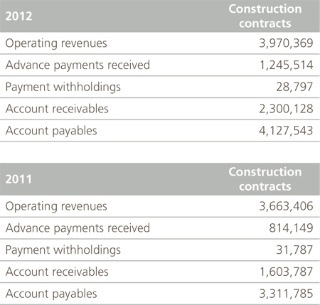
The amount of unbilled revenue by the end of the years 2012 and 2011 is €408,128 and €493,371 thousand, respectively.
The aggregated total amount of the costs incurred and the aggregated total profits (less the related losses) recognized since origin for all the ongoing contracts at December 31, 2012 amount to €10,547,329 thousand and €829,611 thousand respectively.
-
Note 27.- Revenues
The breakdown of Revenues for the years ended December 31, 2012 and 2011 is as follows:

-
Note 28.- Other operating income and expenses
The table below shows the detail of Other Operating Income and Expenses for 2012 and 2011:
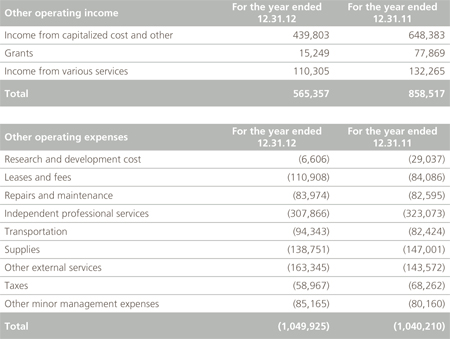
Income from capitalized costs and other corresponds to income from capitalized costs for an amount of €306.6 M and €642.5 M for the years 2012 and 2011, respectively. Income from capitalized costs and other includes mainly the capitalization of costs associated with the construction of our own assets (except for concession assets for which IFRIC 12 is applied). The corresponding costs are recognized in the individual expense line item in the accompanying income statements. The recognition of an income for the sum of such costs through the line item "income from capitalized costs and other" results in these costs having no impact in net operating profit. The corresponding assets are capitalized and included in property, plant and equipment in the accompanying balance sheets. The variation year-over-year is caused by the fact that costs associated with the construction of thermosolar plants in Spain were included in this line item until the prospective application of IFRIC 12 starting September 1, 2011.
Additionally, other income correspond mainly to the gain amounting to €85 M arising from the business combination of Rioglass Group, where we achieved control by increasing our ownership in stages as well as an income for the collection of €26 M by the company Abengoa Bioenergy U.S. Holding in the last quarter of 2012, by a favorable jury verdict of a litigation against the company Chicago Tithe Insurance Company. Finally, this heading includes income arising from the fair value adjustment of our biological assets in Brazil, to sales of property plant and equipment and to other minor income.
As indicated in Note 24.2, Grants in 2011 include income in relation to export activity deductions in cases where it is considered appropriate to apply IAS 20 to these investment tax credits (see Note 24).
Income from various services in 2012 primarily includes profits generated by the sale of the second 50% of the shareholding of STE, ATE, ATE II and ATE III amounting to €4.5 M and other income by minor services. In 2011 it primarily includes profits generated by the sale of the first 50% of the Brazilian transmission lines amounting to €45 M.
“Leases and fees” mainly includes leases of buildings, offices, machinery and construction equipment required in the ordinary course of operating activities of companies.
Under “Other external services” are mainly recorded trips and per diem expenses.
-
Note 29.- Employee benefit expenses
The breakdown of Employee Benefit Expense for 2012 and 2011 is as follows:

a) Share plans
On February 2, 2006, Abengoa granted a Share Acquisition Plan, or Plan, which was approved by the Board of Directors of Abengoa on January 23, 2006. The Plan is on the same terms to all participants, members of the senior management of Abengoa and its subsidiaries. Under the Plan, participants were entitled to purchase up to 3,200,000 shares of Abengoa. Subsequently, the number of shares has been adjusted due to the increase in class B share capital charged to our freely available reserves, approved by the Extraordinary General Meeting held on September 30, 2012 (see Note 18).
The material terms of the Plan are as follows:
- Participants: 122 members of the senior management of the Abengoa Group (business group managers, business unit managers, technical and research and development officers and corporate services officers) from all its subsidiaries and business areas are eligible to participate in the Plan if they desire to do so. The Plan is not open to any member of Abengoa’s Board of Directors. At the end of 2012, besides the participants excluded from the Plan, there were 98 participants.
- Shares Available for Purchase: Up to 3,200,000 Abengoa shares (the “shares”). The shares purchased by Plan participants were already issued and in circulation and were purchased on the open market, at the then current market price, over a period that extended to December 31, 2006, in accordance with the Stock Exchange Act (Spain). A total of 3,166,000 were purchased under the Plan. As such, these shares are not dilutive instruments for earnings per share calculation purposes. At year ended 2012, the number of shares covered by the plan amounted to 12,251,425 shares, adjusted due to capital increase by distribution of class B shares mentioned above.
- Financing: As a feature of the Plan, each participant utilized the proceeds of an individual bank loan from Banco Sabadell, S.A. or Caja Madrid (collectively the “Bank”) to finance the purchase of shares of Abengoa under the Plan. The same standard loan terms apply to all participants. The interest rate on the loans is a variable rate equal to EURIBOR plus 0.75%. These are bullet and not amortizing loans. The loans must be repaid by the participants by August 7, 2011. Each loan is secured by a pledge of 100% of the participant’s shares and is guaranteed by the Company to the extent set forth under paragraph 8 below. Except for the pledge of the shares, the loan is not considered a non-recourse financing to the participant. The maximum amount of indebtedness related to all such loans is €87 M euros (including expenses, commissions and interests). As of December 31, 2012 and 2011, the amounts drawn by total participants under these loans amounted to €61 M and €59 M respectively.
- Share Purchase: The acquisition cost for all participants has been the average acquisition price, plus associated commissions and other costs, for all of the shares purchased under the Plan for all participants.
- Term and Vesting Period: The duration and vesting period of the Plan is five complete financial years (2006-2010) plus six months (until June 30, 2011) (the requisite service period). The Plan requires the annual accomplishment by the participant of annual management objectives, including specific financial targets and qualitative objectives, set by the management of the Abengoa Group company by which the participant is employed, as well as their continuation as a Group employee through June 30, 2011. If the annual objectives are not met by the participant, the Bank from which the participant borrowed the funds to purchase his/her shares may sell a percentage of the shares purchased for such participant as follows: 2006-30%, 2007-30%, 2008-15%, 2009-15%, 2010-10%.
- As of December 31, 2010, the participants had consolidated the annual objectives required by the Plan.
- Restrictions on Sales: A participant may not transfer, sell, borrow against or otherwise dispose of the shares purchased before July 1, 2011.
- Repurchase Option: Under the Plan, Abengoa has a repurchase option under which Abengoa can require a participant to sell the shares back to the Company on the occurrence of certain events, such as death, disability or retirement of the participant or termination of the employment of the participant with the Abengoa Group Company.
- Shortfall on Sale of Shares: At the end of the five years and six months term of the Plan, if the amount realized on a sale of the shares does not entirely cover the amount owed under the loan and costs and taxes on capital gains, Abengoa will compensate the participant with the necessary amount to repay the loan plus accrued and unpaid interest and pay such taxes.
- In 2011 agreements were closed with participating financial entities and the directors of said Plan for its extension for an additional period of two years, until December 31, 2012.
Compensation expense is recognized over the requisite service period (the vesting period), and is determined by reference to the fair value of a hypothetical put option granted by the company to the participant, excluding the effect of vesting conditions that are not market conditions. For these purposes, the calculation takes into account the number of shares that are expected to become exercisable (or vested), which is updated at each year end, recognizing the impact of the revision of the original estimates, if applicable, in the Consolidated Income Statement.
The fair value of the hypothetical options granted during the year 2012, calculated using the Black-Scholes model was €36,245 thousand (€26,772 thousand in 2011), recording a loss during the year 2012 of €9,473 thousand (expense of €7,914 thousand in 2011). The key data required for the valuation model were share price, the estimated return per dividend, an expected option life of 5 years, an annual interest rate and share market volatility that are included in the table below:
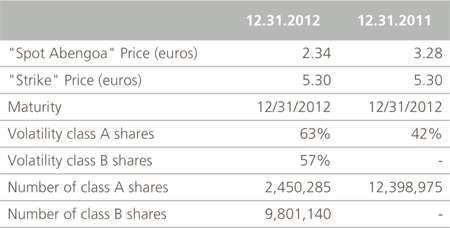
b) Bonus schemes
On July 24, 2006 and December 11, 2006, the Board of Directors approved an Extraordinary Variable Compensation Plan for Managers (Plan II) at the proposal of the Remuneration Committee. This plan initially included 190 beneficiaries and had a total cost of €51,630 thousand over a five-year period from 2007 to 2011, inclusive. It required that objectives set forth in the Strategic Plan be attained at an individual level as well as the individual’s continued ongoing service throughout the period in question.
In addition to the aforementioned, given that the acquisition of the company B.U.S. Group AB was completed only shortly after implementation of the Plan, on October 22, 2007 the Board of Directors approved the inclusion of the management team of such company, formed by 10 people, in the Plan under the same conditions as those established for the rest of the beneficiaries, for a total amount of €2,520 thousand. At the close of 2012 financial year, there were 155 participants, and the total cost of the plan was €35,237 thousand.
On October 24, 2011, the Board of Directors approved the extension of the Plan II for a period of one additional year.
On January 24, 2011, the Board of Directors approved an Extraordinary Variable Compensation Plan for Managers (Plan III), proposed by the Remuneration Committee. The plan, which includes 104 beneficiaries (the participants), has a duration of five years (from 2011 to 2015) and is based on achieving the objectives defined in the Strategic Plan, at an individual level. The plan also requires the individual’s continued ongoing service for the entire period considered. The total amount available under the plan for the 104 participants is €56,500 thousand. The company recognizes the corresponding personnel expense in the Consolidated Income Statements for the amounts accrued based on the percentage of consolidation of the objectives. At the end of 2012, there were 103 participants and the total amount of the plan has reached €55,270 thousand.
The cost recognized through the variable remuneration plans in 2012 was €11,054 thousand (€23,138 thousand in 2011), the accumulated cost being €71,933 thousand (€60,879 thousand in 2011). The cost of Plan III corresponding to senior Management of the Company recognized in 2012 amounts to €2,380 thousand.
-
Note 30.- Financial income and expenses
30.1. Financial income and expenses
The following table sets forth our Finance income and expenses for the years ended December 31, 2012 and 2011:
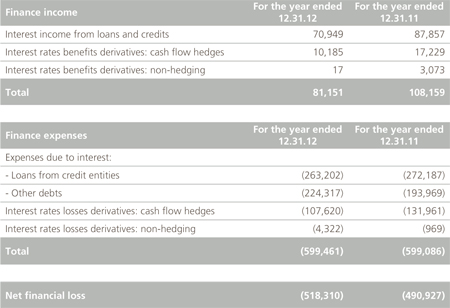
For the year ended December 31, 2012 financial income has decreased with respect to the same period of the previous year mainly due to lower interest income from loans and credits in Brazil due to the sale of transmission lines in two parts.
Interest expenses from loans and credits have remained stables, due to a higher proceeds from non-recourse financing for the year was offset by increased capitalized interest in projects that are under construction. The increase in interest from other debts, mainly due to a larger volume in our non-recourse factoring arrangements, has been practically offset by a decrease in losses from our interest rate derivatives.
The net financial expenses for non-recourse financing project companies is €-115,254 thousand (€-124,225 thousand in 2011).
30.2. Net exchange differences
The following table sets out the exchange rate differences in 2012 and 2011:

The most significant amounts in net exchange differences during 2012 correspond to a loss from exchange rate derivatives recognized as a result of the interruption of the hedging relationship, when the transaction hedge is no longer expected to occur and to different hedges in several subsidiaries that have not been offset perfectly with the differences generated by the hedged item.
The most significant amounts in net exchange differences during 2011 correspond to the negative impact of foreign exchange transactions, for an amount of €32.3 M, due to the unfavorable evolution of the Brazilian real-U.S. Dollar exchange rate related to the U.S. Dollar-denominated debt financings of out Brazilian subsidiaries.
Net exchange rate differences in 2012 for entities with non-recourse financing amounts to €-27,327 thousand (€6,961 thousand in 2011).
30.3. Other net finance income and expenses
The following table sets out “Other net finance income and expenses” in 2012 and 2011:
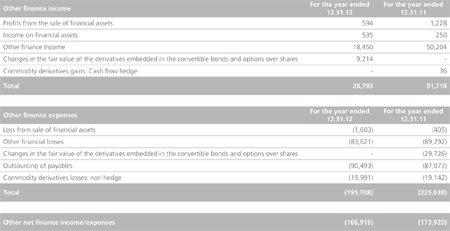
At December 31, 2012 the heading “Other finance income” mainly includes the change in fair value of embedded derivatives of the convertible bonds, net of change in fair value of the call options over Abengoa’s own share, which hedge the embedded derivatives partially, amounting to a net gain of €9,214 thousand (see Note 20.3). In 2011 this impact was a loss classified in “Other finance expenses”. The remaining balance of “Other finance income” corresponds to other minor finance income.
At December 31, 2012 in the heading “Other finance expenses”, expenses generated by outsourcing of payables have remained in line with the prior year. Commodity derivatives losses correspond to the interruption of the hedging relationship, when the transaction hedged is no longer expected to occur. Additionally, “Other financial losses” line includes financial guarantees and letters of credit, costs related to wire transfers and other bank fees, loss on available for sale financial assets and other minor finance expenses.
The most significant amounts at the end of 2011 are mainly in changes in fair value of derivatives embedded in convertible notes of Abengoa with regards to previous periods and to changes in the fair value of options over the shares of Abengoa (basically due to the decrease in the price of the shares of Abengoa, which is a principal factor in the valuation of derivatives embedded in the options) for a net sum of €30 M in losses and to other financial expenses basically relating to opening commissions, formalization of debts and financial expenses relating to confirmed payments to suppliers through financial institutions.
The net of “Other incomes and financial expenses” for Non-recourse financing project companies is €-33,607 thousand (€-59,455 thousand in 2011).
30.4. Non-monetary items of derivative financial instruments
The table below provides a breakdown of the line item “Fair value gains on derivative financial instruments” included in the Consolidated Cash Flow Statement for the years ended December 31, 2012 and 2011:

-
Note 31.- Income tax
Details regarding income tax at the end of 2012 and 2011 are as follows:

The reconciliation between the theoretical income tax resulting from applying statutory tax rate in Spain to income before income tax and the actual income tax expense recognized in the Consolidated Income Statement for the years 2012 and 2011 is as follows:
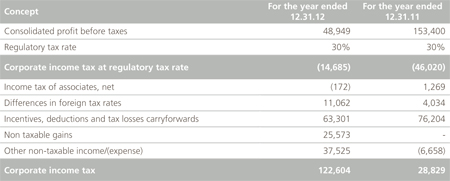
Differences between theoretical tax and actual tax expense arise mainly from:
- Companies based in jurisdictions with statutory tax rates different from Spanish statutory tax rate.
- Application in Spain of tax incentive for the transfer of use of intangible assets under Article 23 of the Revised Text of the Spanish Income Tax Act and application also in Spain of the tax incentive which exempts any profits generated abroad for international projects involving the export of goods and services from Spain. Generation of tax deductions, mainly in Spain, among which we can outline R&D&I deductions, double taxation deductions, deductions on training expenses and deductions on donation expenses. In addition, the Company has recorded deferred tax assets for tax loss carryforwards generated in past years in other tax jurisdictions.
- In 2012, the Company has recorded no taxable gains corresponding to the gain obtained in the business combination achieved in stages over Rioglass Group (see Note 6.3).
- The heading “Other non-taxable income/ (expense)” includes, among others, income tax expenses corresponding to the previous period and permanent differences arising in other jurisdictions as a result of revaluation of assets and liabilities.
-
Note 32.- Earnings per share
As explained in Note 18, on September 30, 2012, the General Shareholders’ Meeting approved an increase in class B share capital, charged to our freely available reserves, which will be distributed for no consideration to all existing shareholders on the basis of four (4) class B shares for each class A share or class B share which they hold. Therefore, no dilution or further concentration with respect to our share capital has occurred.
According to IAS 33, when ordinary shares are issued to existing shareholders for no additional consideration, the transaction is equivalent to a share split. In this case, the number of ordinary shares outstanding before the event is adjusted for the proportionate change in the number of ordinary shares outstanding as if the event had occurred at the beginning of the earliest period presented.
32.1. Basic earnings per share
Basic earnings per share are calculated by dividing the profit attributable to equity holders of the company by the weighted average number of ordinary shares outstanding during the period.
The average number of ordinary shares used for the earnings per share calculation has been adjusted to reflect the capital increase described in Note 18, consisting in distributing to all existing shareholders four (4) class B shares for each class A share or class B share which they hold, for no consideration.
On the other hand, the weighted average number of shares for the year ended on December 31, 2011 is different from the number of shares for the year ended on December 31, 2012 because the latter incorporates during the entire period the capital increase subscribed by FRC in November 2011, as described in Note 18.

32.2. Diluted earnings per share
To calculate the diluted earnings per share, the average weighted number of ordinary shares issued and outstanding is adjusted to reflect the conversion of all the potential diluting ordinary shares.
The potential diluting ordinary shares held by the group correspond to the warrants on Type B shares issued in November 2011. The assumption is that all warrants will be exercised and a calculation is made to determine the number of shares that may have been acquired at fair value based on the monetary value of the subscription rights of the warrants still to be exercised. The difference between the number of shares issued assuming the exercise of the warrants, and the number of shares calculated based on the above, is included in the calculation of the income per diluted share.
In addition, the average number of ordinary shares used for the earnings per share calculation has been adjusted to reflect the capital increase described in Note 18, consisting in distributing to all existing shareholders four (4) class B shares for each class A share or class B share which they hold, for no consideration.
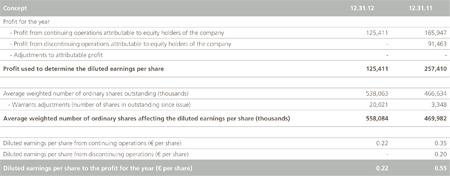
-
Note 33.- Other information
33.1. Average number of employees
The average number of employees during 2012 and 2011 was:

The average number of employees is 29% in Spain (34% in 2011) and 71% abroad (66% in 2011).
The average number of employees during the year with disabilities above or equal to 33% is 115 (108 in 2011).
The total number of people employed at the end of 2012 was 26,402 (22,243 in 2011).
33.2. Related parties
The account held by Abengoa with Inversión Corporativa I.C., S.A., as of year-end 2012 and 2011 has a nil balance.
Dividends distributed to related parties during 2012 amounted to €17,745 thousand (€10,140 thousand in 2011).
During 2012 no new operations exist with related parties.
As indicated in Note 18.1, Inversión Corporativa is Abengoa’s main shareholder, and issues its own separate Consolidated Financial Statements.
These operations were subject to verification by the Abengoa Audit Committee and the consideration paid for the different transactions has been determined by independent third parties.
33.3. Employee remuneration and other benefits
Directors are remunerated as established in article 39 of the Articles of Association. The remuneration of Directors is made up of a fixed amount as agreed upon at the General Shareholders’ Meeting, and is not necessarily equal for all directors. Additionally, they may participate in profit sharing programs, for a percentage between 5% and 10% (maximum) of the net income of the Company after the declaration of the dividends for the year. Travel expenses related to work undertaken by the board are reimbursed to Directors.
Salary (both fixed and variable) and allowances paid to the members of the Board of Abengoa S.A. in 2012 were €13,887 thousand (€13,237 thousand in 2011), as well as €169 thousand attributed to other items (€156 thousand in 2011).
Detail on individual salaries and benefits in 2012 paid to the Board of Directors are as follows (in thousands of Euros):

Detail on individual salaries and benefits in 2011 paid to the Board of Directors is as follows (in thousand of Euros):

Additionally, in 2012 overall remuneration for key management of the Company (Senior Management which are not executive directors), including both fixed and variable components, amounted to €13,574 thousand (€7,822 thousand in 2011).
No advanced payments or credits are granted to members of the Board, nor are any guarantees or obligations granted in their favor.
As of December 31, 2012 there existed €71,199 thousand in non-current personnel compensation obligations (€64,154 thousand in 2011 ).
33.4.
On May 3, 2012 Mrs. Mercedes Gracia Díez was appointed as president of the Audit Committee.
33.5.
In compliance with Royal Decree 1/2010 of July 2, that approves the Capital Companies Act, the Company informs that no member of the Board of Directors of Abengoa, S.A. and, to its knowledge, none of the individuals related parties as referred to by article 231 in the Capital Companies Act maintains any direct to indirect share in the capital of companies with the same, analogous or complementary kind of activity that the parent company’s corporate purpose, nor has any position in any company with the same, analogous or complementary kind of activity that the parent company’s corporate purpose. In addition, no member of the Board of Directors has accomplished any activity with the same, analogous or complementary kind of activity that the parent company’s corporate purpose.
As of December 31, 2012, members of the Board of Directors who are in turn directors or management in other subsidiaries included in the consolidation group are:
Mr José B. Terceiro Lombs is the president and vocal of the Board of Directors of Bioetanol Galicia, S.A. and Ms María Teresa Benjumea Llorente is vocal in the Board of Directors of Sociedad Inversora en Energía y Medioambiente, S.A.
In accordance with the record of significant holding in the Company, and as required by the “Internal Rules and Regulations for Conduct involving Stock Exchange Matters”, the shares and the holding percentages of the Company Directors as of December 31, 2012 are:
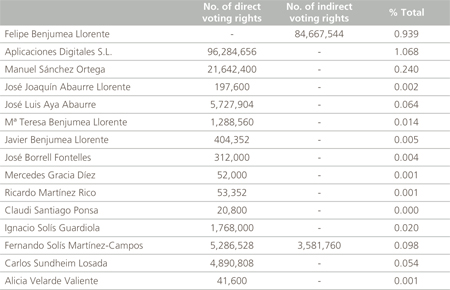
Throughout out 2012 and 2011 there was no evidence of any direct or indirect conflict of interest situation, in accordance with what is envisaged in Article 229 of the Capital Companies Act.
33.6. Audit fees
The fees and costs obtained by Deloitte, S.L. and other auditors are the following:

(*) From this amount, €845 thousand correspond to tax advisory services provided by Deloitte, S.L. prior to their appointment as Group auditors.
The amounts included in the table above show all the fees related to the services provided by the principal auditor (PricewaterhouseCoopers, S.L.) during 2011 and by the principal auditor (Deloitte, S.L.) during 2012.
33.7. Environmental information
The principles of the environmental policies of Abengoa are based on compliance with the current legal regulations applicable, preventing or minimizing damaging or negative environmental consequences, reducing the consumption of energy and natural resources, and achieving ongoing improvement in environmental conduct.
In response to this commitment to the sustainable use of energy and natural resources, Abengoa, in its Management Rules and Guidelines for the entire Group, explicitly establishes the obligation to implement and certify environmental management systems in accordance with the ISO 14001 International Standard.
Consequently, by year-end 2012, the percentage of Companies with Environment Management Systems certified according to the ISO 14001 Standard per sales volume is 92.84% (80.52% in 2011).
The table below lists the percentage of distribution of the Companies with Certified Environmental Management Systems, broken down by business unit:

33.8. Subsequent events
On January 17, 2013, Abengoa, S.A. issued €400 M aggregate principal amount of 6.25% notes due 2019 (the “2019 Convertible Notes”). In summary, the final terms and conditions of the issuance are as follows:
a) The Notes were issued for four hundred million Euros (€400 M) with maturity set at six (6) years.
b) The Notes accrue a fixed annual interest of 6.25% payable semiannually.
c) The Notes are convertible, at the option of noteholders into fully paid class B shares.
d) In the event that investors decide to exercise their right of conversion, the Company may decide to repay the notes in shares, cash or a combination of cash and shares.
e) The 2019 Convertible Notes are convertible into fully paid class B shares of the Parent Guarantor credited in the number determined by dividing the aggregate nominal amount of the Notes by the applicable conversion price. The conversion price is three Euros and twenty-seven cents of a Euro (€3.27) for each share B of the Company.
On January 9, 2013, Abengoa entered into certain stock loan agreements with Inversión Corporativa IC, S.A. for a total amount of 11,047,468 Class B shares to facilitate stock borrow liquidity to investors in the 2019 convertible notes.
On January 17, 2013, we used €108.8 M out of the proceeds from the issuance of the 2019 Convertible Notes to repurchase €99.9 M principal amount of our outstanding 2014 Convertible Notes. The remaining proceeds of the 2019 Convertible Notes will be used to repay syndicated bank debt maturing in 2013 and other short-term corporate debt.
On February 5, 2013, Abengoa Finance S.A.U. issued € 250 M ordinary Notes. In summary, the final terms and conditions of the issuance are as follows:
a) The Notes were issued for two hundred and fifty million Euros (€250 M) with maturity set at five (5) years.
b) The Notes accrue an annual interest of 8.875% payable semiannually.
c) The notes are guaranteed jointly by certain subsidiaries of the Group.
Finally, on February 2, 2013, Royal Decree 2/2013 of February 1 on urgent measures related to the electric system and financial sector has been published and ratified by Spanish General Courts on February 14. Among other measures, this Royal Decree establishes an amendment starting in 2013 on the mechanism to update tariffs and premiums received by electricity suppliers in application of its sector regulation and several amendments to Royal Decree 661/2007, of May 25, that regulates electricity production activity under the special regime and under the regime derived from the latter. These measures have meant a significant modification in the regulatory framework applicable to the electricity generation with thermo-solar technology in Spain.
Given that the afore-mentioned measures have been approved and made public after the date of these consolidated financial statements and will be effective in 2013, they correspond to a circumstance occurred in the period 2013 and do not correspond to an evidence or confirmation of conditions that existed prior to the closing of the reporting period 2012.
In consequence, under IAS 10 on “Events after the reporting period”, its potential impacts should be considered after the closing of the reporting period 2012. In accordance with the analysis performed by the Company on the potential impacts that these measures could have, considering all the evidence available at the date of issuance of these consolidated financial statements, Management has concluded that the analysis carried out do not indicate an impairment in the carrying amount of assets related to thermo-solar electricity generation activity in Spain. As a result, the Company does not expect to have impairment losses nor any default in the financial obligations related to these projects as a consequence of the measures established in Royal Decree 2/2013.
© 2012 Abengoa. All rights reserved
